ESSENTIALS OF PRACTICAL LEADERSHIP IN WHOLESALE-DISTRIBUTION








































































































































































































































































































































































































































































































































































































































































































































































 Karla Neupert Hockley President, Consolidated Supply Co.
Karla Neupert Hockley President, Consolidated Supply Co.

Developing the next generation of leaders for our industry is no small task; beyond attracting the right talent to our industry, businesses must continually invest in, develop, and sharpen the skills that the next generation of leaders will bring to their organizations. Failure to do so can mean the difference between a business poised to succeed for the next several decades, and one whose doors will languish, or close with the retirement of a key leader, or owner.
The American Supply Association Education Foundation (ASAEF) has long recognized the need to cultivate strong, nimble leaders to bring new ideas, new approaches, and new energy to our industry. ASAEF’s belief in furthering all levels of the training model–from day-to-day job tasks to complex, leadership-driven activities–has led the industry forward since day one.
In 2015, ASA University announced the first holistic leadership program designed to target upand-coming leaders, with the goal of developing them into leadership juggernauts: the Master of Distribution Management (MDM) Program. Over time, the program has helped many future leaders shine a light on their path forward.























The ASA Education Foundation’s newest Essentials offering, Essentials of Practical Leadership in Wholesale-Distribution, has been uniquely developed for future leaders. Packed chock-full of best practices from industry leaders that have been gleaned from their real-world experiences. This book provides a strong foundation for leadership skills–and going forward, will serve as the backbone for the ASA Master of Distribution Management program.
Read how CEOs, Presidents, and top-level executives of successful businesses across our industry navigate the twists and turns of our economy and the market. Learn how they manage their businesses, and how they lead their teams with heart, courage, and pride. As you read this book, you’ll learn from the personal and professional experiences of our industry leaders. You’ll soak up wisdom imparted from those who have walked the walk–and whom at one time, were future leaders themselves.
This real-life look at leadership and the skill sets needed to succeed will bring a whole arsenal of tools to any developing leader’s playbook. Read how Rick Fantham, President and CEO of Hajoca, sees the world and applies his strategic vision to a national, privately held. Learn how Bill Condron, President and CEO of The Granite Group, brings his team together with core values, common goals, and an outstanding, long-lasting culture of greatness that drives their success. Hear from Joe Poehling, past President & CEO of First Supply, and his daughter, Katie Poehling Seymour, current President and CEO as they share their perspectives on succession planning and the transition of ownership between generations.
















Throughout this book, you’ll also find key chapters on skill sets needed to succeed as a leader in our industry–including chapters authored by Dr. Kathy Newton, Associate Professor at Purdue University’s Polytechnical Institute, and faculty from Texas A&M’s Industrial Distribution Program. You’ll also hear from individuals who have been in and around training in our industry for years, like Dirk Beveridge, founder and CEO of “UnleashWD”, and Dayna Williams, leader of the Association for Talent Development’s (ATD) Developing Sales Capabilities Practice and author of “The Diligence Fix”.











This Essentials course is unique as it leverages the expertise and wisdom of leaders across the wholesale-distribution industry. Anyone can reference a textbook about being a great team leader, or how to read a financial statement. This resource grounds these lessons in the real, day-to-day business challenges that our industry leaders face. It will bring valuable insight and applicability to the lessons shared.










My family has been involved in our industry for five generations, as stewards of Consolidated Supply Co, a family-owned wholesale-distribution business. I’ve been fortunate enough to observe the impact of training and development at all levels of the business. Over time, I’ve watched the industry change, evolve, and demand more skilled workers than ever before. We have a pressing need to develop leaders who can rise to the challenge of an ever-changing landscape.
My father, the late Karl E. Neupert, who was third-generation leadership for the business, was passionate about ASA’s role in providing germane educational resources to member companies. In the late 1990’s he was determined to raise significant funds from all stakeholders in the industry to ensure education and training in our industry would thrive. These funds could be endowed and serve as the seed capital to support the creation and availability of relevant educational products for future generations.


The Karl E. Neupert Endowment Fund, which to this day continues to provide ongoing funding for ASA Education Foundation resources and programs, makes this project extra special. Becoming involved with projects like Essentials of Practical Leadership in Wholesale-Distribution allows me, in some small way, to continue the critical work started by my father’s vision to create the endowment to support the activities of ASA Education Foundation. To see the development of new resources and programs that contribute to the continued viability of our industry is gratifying. Our ability to pivot as the needs of our teams and the market demand is mission-critical.















































































































I am excited about the impact this valuable resource will have on the future of our industry. There is great satisfaction and confidence that comes from having savvy industry leaders directly contributing to the development of our future best and brightest. Efforts and resources like this will support our industry’s success in the dynamic landscape that lies ahead.
 Karla Neupert Hockley Consolidated Supply Co. President
Karla Neupert Hockley Consolidated Supply Co. President


















































































































Much appreciation to the MDM Task Group, who shared their thoughts, feedback, ideas, and guidance throughout the entire development process of this offering.
• Gail See, Learning & Development Specialist, Dakota Supply Group















• Meridith McArthur, President, Mid-State Supply







• Brian Tuohey, CEO, The Collins Companies











• Cheryl Harris, Ph.D., Vice President, People Growth, Reece
























































• Dwight Newton, Chief People Officer, Zoeller Pump
In addition, many thanks to the authors of this outstanding resource, for sharing their time and wisdom with ASA. Their contributions to our industry’s future leadership will be far reaching.























































































































































 Rick Fantham President, Hajoca Corporation
Rick Fantham President, Hajoca Corporation
In today’s dynamic business environment, people-centered leadership is essential for success. Inspiring our teammates gives us the opportunity to invite everyone in the company to become part of the “leadership team.” Together, we embark on a journey to collectively invent and implement a bold vision, enabling us to survive and thrive in a brave new world.
This chapter will explore people-centered leadership and its power to adapt to the forces of change as well as how to succeed in the evolving landscape by supporting enduring high performance and sustainability.
We are excited to share the leadership learnings of Rick Fantham, President and CEO of Hajoca, and the “power of four” that drives his vision for the future of their team and business.
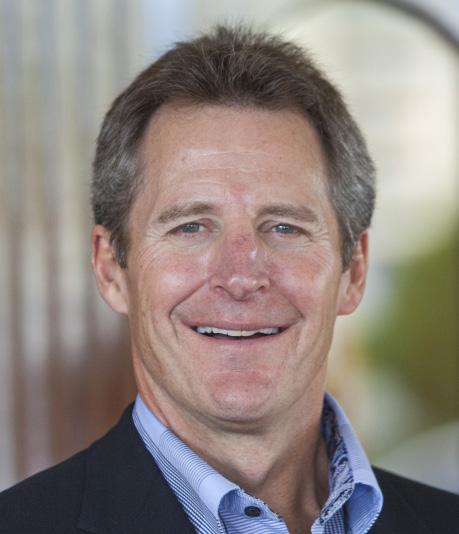



My first two years as the head cheerleader of our company were rugged (I guide managers on how to hot use my track record for inspection!). In early 2002, our leadership team met to define what we would stand for.

After a couple days of lively debate, we decided to go all in on People, and our formula for success was: L(PxC) =R:








































































































































































































• Develop and select awesome Leaders (L) . . .
• . . . they surround themselves with incredible People (P) . . .
• . . . together they choose the Customers
(C) to build powerful partnerships . . .
• . . . and world class Results (R) will show up!
From this point forward, I embraced People Centered Leadership. Despite lots of bumps in the road, when we get the L and P right, we bat 1,000!
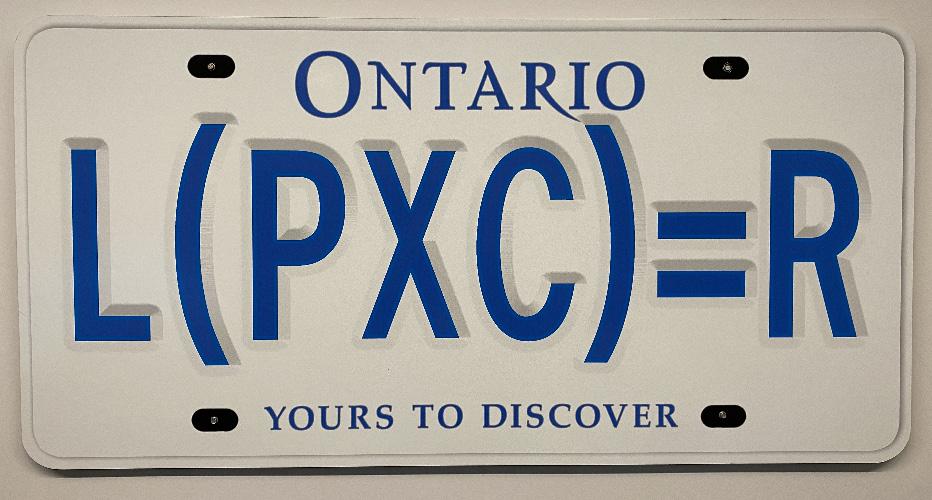


Number four has been a recurring theme in my career, not only for structuring communication but also as a framework for organizing my priorities and approach. In the spirit of the “power of four,” shown as L(PxC)=R, I would like to share with you the four most powerful lessons that I have learned as I continue to work hard to lead through our people.
My goal in sharing these lessons is to provide perspective as you navigate the moguls on your mountain. I will share with you some key lessons that have significantly impacted my thinking and acting in several roles throughout my career. I will share outcomes with you (both good and bad) to demonstrate how going “All In” on your teammates can impact your business, both in the long and short term.
Rick


































































































ideas
my ideas
















































Early in my career, I was driven to score touchdowns myself and appreciated the recognition that followed. The wholesale-distribution business is a people-intensive, hands-on business. As a result, I became an expert “do-er.” I enjoyed many new experiences and wore many hats, but over time, I felt that there was a natural constraint to this approach: time.

As I began to observe great leaders, they seemed to “do” less, and accomplish more. They were incredible students of human behavior and harnessed the power of self-determination. Over time, I learned that the secret to executing a successful vision for any organization is creating an environment where people are working for their ideas, not mine.



A breakthrough is when each teammate can see their fingerprints on the “What” and the “How.” Although my formal education was in finance and business, there’s no doubt in my mind that more courses in human psychology and behavior would’ve paid higher dividends!













Instead of being the penultimate “do-er,” I became comfortable letting go and empowering others to take ownership of challenges and finding solutions. With this empowerment came ownership, accountability, and pride–the magic of people working for their own ideas! Instead of being a master “do-er,” I became a catalyst for enabling and empowering others to achieve their definition of greatness within the context of a common purpose and aligned goals.
I believe in several core leadership qualities that help foster an environment to reinforce empowerment:

1. Creating an environment where it is okay to make and learn from mistakes so people get comfortable taking increased risks without fear of failure.

2. Being transparent in building alignment with a common purpose and goals.














































































3. Gently guiding and coaching. Leave the steering wheel in their hands and be “okay” with making some wrong turns!




















































































4. Being their accountability partner in delivering on commitments, clearing barriers, and celebrating milestones.






















Today, with three grown children and two grandchildren, I get so much more adrenaline by being an active advocate from the sidelines and being a catalyst for others to change their world by working for their ideas. I have found this to be particularly relevant for the current generation, where their own “How” is almost always more effective than my playbook.

1. Be clear and consistent about your vision and values . . .and use the power of inquiry and generous listening to understand their motivation.
2. Connect with your teammates from the heart on purpose and with the ultimate “What” trying to be accomplished.
3. Become a catalyst for others to change the world by working for their ideas and determining the “How” of getting the job done.
4. Become comfortable not being a control freak! Learn to let go.
My life would be so much simpler if solutions were universal. That said, one of my favorite dimensions of the plumbing wholesale business is that, for the most part, it’s still largely local. Because of this, I have embraced “Think Local and Act Local.” It may make leadership more complex, but it makes it much more fun and stimulating!
Within that local business ecosystem, I found that businesses and leaders are at different phases of evolution. As I began to understand the evolution of a business, I developed a framework for viewing our businesses through the lens of four phases, as follows:



































































Finding their way
Profitable






High-performing Market leader
































Underperforming Inconsistent Ready for stretch! Bold/Innovative
1. Foundation–an underperforming business.













































2. Quality–delivering strengthened profitability, but inconsistently or sporadically.
3. Quantity–a high-performing business that is ready to grow/stretch!
4. Franchise–becoming a market leader in all dimensions.
This framework can provide context for local leaders to build their playbook based on their positioning in their local market. Depending on their phase within this framework, there are different strategies to lead their business:
Foundation:















































Build a platform for finding daylight and creating business possibilities.



















1. Get the House in Order
Identify and fix any major problems up front (quality of leader, customer focus, expense base, working capital clean-up, the list goes on . . .).
2. Find the Right Leader
The most important decision a business can make. Never settle. The most important quality is “I care”. Look for a founder’s mentality, a commitment to world-class quality and a drive to succeed through people!
3. Build Your Dream Team
Demonstrate the power of high expectations in action. Recruit team members who demonstrate a spirit of ownership and commitment. Set expectations for employee-level engagement with clear business goals.
4. Do the Simple Stuff Right
Make it a daily obsession to be great at the blocking and tackling of customer service–right product, right time, right place, fair price, with a smile. After all, this is a PEOPLE business!



































































































































Build high-performing, repeatable, and consistent processes for success.
1. Developing Vision and Roadmap
As a leader, build a vision and co-invent a road map with the team’s buy-in and understanding. Determine your market focus, customer targets, value proposition, cultural expectations, and execution strategy.
2. People Development







Focus on building trust and a high-expectations culture. Be clear about what those expectations are. Demonstrate and demand integrity. Reinforce accountability, invest in your team, and provide training and resources to invite them to embrace excellence.
3. Customer Selection
Arguably one of the most underrated elements in the business. Determine the customers who hold special significance to you, then identify how you will add value to their business and start to build customer partnerships and relationships.
4. Vendor Selection
Harness the power of targeted vendor partnerships that will bring profitability and growth to your business. Practice your core values externally and embrace “stretch”!
Quantity:












































































































































Solidify a platform for growth: Be Bold and Smart.
1. Everyone is an Owner
Everyone on the team feels like an owner . . . they want to be part of building something special and enduring!
2. Differentiate Your Business
Invest in capabilities that add targeted value to your customers. In addition to the fundamentals, ask yourself: What services can you provide to differentiate yourself in the market?
3. Master Competing Priorities
Embrace the AND culture . . . market share AND GP% growth . . . find ways to master the paradox of competing priorities.
4. Embrace Challenges
Be a catalyst for Stretch . . . “Good is the enemy of Great!” Create a “Go for lit” environment and embrace the challenges that come with it!
Franchise:
Become a market leader/influencer and achieve status as an enduring world-class business.
1. Leading the Pack
After walking the walk for many years, the business leader is widely respected in the marketplace. Reputation becomes the best sales rep: word of mouth!










2. Becoming an Employer of Choice
Your business is a place where people aspire to be. Desirable candidates know and seek out your business due to the fidelity of the teammate experience and culture.
3. Elevating your Business for Customer Partnerships
Partnering with your customers helps them achieve their business and personal goals, which results in prosperity for all.
4. Build Powerful Vendor Partnerships
Continue to cultivate vendor partnerships and leverage your relationship credit to build lasting partnerships of mutual benefit . . . think and act boundaryless.
I’ve found you can apply these phases in many parts of the business world: with ourselves, our local leaders, our teams, our customers, our vendors, and even our investments and acquisitions!















1. When evaluating your business, round down . . . you are better to stay in a phase too long!


























2. Jump a phase at your peril! Recognize the drawbacks of leaping forward too quickly.
3. Even in Franchise, keep one foot on the ground in Foundation, focused on blocking and tackling.




4. Agree wholeheartedly with the statement, “Culture eats strategy every time.” You need the right people, expectations, spirit, and behavior to achieve a vision!

























































































































Early in my career, I was the manager of a big location that participated in multiple market and customer segments: Residential New Construction (RNC), both single-family and high-rise; Repair and Remodel (R&R), complete with showroom; commercial plumbing; waterworks; as well as industrial and fire protection.




































While we had the advantage of scale, we never achieved high performance. Why? The lack of focus and complexity of processes made it very difficult to achieve market leadership in one segment and led to the law of diminishing returns on the expense side. It felt like we worked very hard, for very little. Yet, as I traveled the country and saw our other businesses, I consistently found that the focused distributor was the highest-performing player in the market.
Ten years later, when I was in a position of greater influence, I made the unpopular decision to break this monolith into six independent businesses. People had grown comfortable with this big business structure because of its scale, even though it was a low performer. Complacency with the status quo is a risky place to be.

Despite opposition to my direction, we forged ahead on this path, exemplifying the importance of courage and conviction in leadership. Though it may not be popular, you were put in the role to lead, to chart your path and you need the conviction to stay true to your vision.

In spite of the challenges surrounding my decision, the outcome has been remarkable. Presently, five out of six of those independent businesses are delivering world-class performance, with five of them ranking among the top three players in their chosen segment within a large urban market. Today, we have applied this segmentation philosophy on a national scale.

As I reflect on this experience, I found that narrowing the scope can improve the business in several ways, as follows:



































1. Clarity and simplicity of purpose.


2. Support an obsession to be “the best and favorite” for targeted customer segments.
















































3. Smaller teams support greater ownership and pride!
4. Hands-on management supports agility.
How I apply this:





























































• High-performing businesses never have more than four priorities.
• In a turnaround business, start with two priorities.
1. Better to oversimplify . . . rounding down has power.
2. Scope creep is a trap for many . . . stick to your four top priorities.
3. Clear, concise, and consistent messages have power!
4. Focus on doing the “precious few” priorities extraordinarily well.

We’ve all heard the ubiquitous “under promise and over deliver” mantra at one point or another in our careers. One of the most celebrated business leaders of my era, Jack Welch, former CEO of GE, shaped the thinking of a generation using famous quote. But as I built confidence and started to understand the transactional nature of wholesale distribution, I rejected this concept and embraced “Stretch!”
Unlike other businesses that are capital intensive, where mistakes may have large negative consequences, distribution (for the most part) is a working capital business with high volume, low-value transactions, with repeatable processes and opportunities. Once a distributor achieves reasonable scale, local risk may be moderate, but enterprise risk tends to be low.


So, I embraced a spirit of “go for it,” with the key dimensions being:








































































































































































































1. Foster an ownership mindset to support risk-taking.
2. Encourage teammates to aspire for world-class status in the “precious few.”
3. We can learn from our mistakes with limited downside.
4. Every once in a while, great things happen!
I consistently find that anything is possible when I truly create a stretch environment. When people believe in themselves, feel your confidence in them, are focused on an inspirational goal, and enroll others, they find a way to win, sometimes big–through hard work, tenacity, resilience, and sometimes some luck.

1. You need to be authentic in your pursuit of true empowerment (versus simply delegation.

2. Sometimes “biting your tongue” is the right behavior the power of patience can reward you.
3. Commitment-based leadership includes checkpoints (and possible interventions) on progress versus abdication
4. Don’t forget celebrating is fun! (And necessary!)






























































































To win in business today, I believe everyone on the team needs to feel like an owner. They have their fingerprints on the vision; they co-invented the plan and they have the freedom to figure out the best way to achieve the goals. People-centered leadership can create a culture of ownership, accountability, high expectations, and pride.

I have often taken the scenic route (learned by making mistakes) in this fulfilling but complex world of human behavior, but I am confident it is worth jumping into the deep end of the pool.
Thanks for the opportunity to share some of my experiences.

Rick Fantham, President & CEO, Hajoca Corporation

Rick graduated from Queen’s University in Kingston, Ontario in 1980 with a Bachelor of Commerce and has his Chartered Professional Accounting (CPA) designation. Rick joined Emco Limited in 1988 as Vice President of Business Development for Emco Distribution. He has held progressive roles in the company, including purchasing, marketing, sales, and operations, and became the President of Emco Distribution in 2000 and the President and CEO of Emco Corporation in 2004. He was a member of the Canadian Institute of Plumbing and Heating (CIPH) Board of Directors for 10 years, culminating in being Chairman of the Board in 2001–02.
On January 1, 2006, Rick was appointed Executive Vice President of Hajoca Corporation, he became Chief Operating Officer of Hajoca in July 2007, and on January 1, 2009, Rick became President and Chief Executive Officer of Hajoca, in addition to his Emco responsibilities.




























Rick’s involvement with ASA began in 2011, and he has since volunteered on various ASA workgroups and committees, including: Chairman of ASA (2015); Executive Committee (2011-2016); Board of Directors (2011–2019 / 2021–2023); Plumbing Division Advisory Group (2014–2015); Vendor Member Division Advisory Board (2014–2015), ASA Education Foundation Trustees (2015), and the ASA Education Foundation Investment Advisory Group (2015).
























Rick lives in London, Ontario, Canada with Tina, his wife of 42 years. London is close enough to Toronto where their three children and two grandchildren reside.








































































































1. Rick identifies his formula for success as L(PxC)=R. What is your organization’s formula for success? Do you have your own personal formula for growth and success?
2. Empowering workers is a key tenant of people-centered leadership. List the ways that you actively empower workers, allowing them to run with ideas and actions without trying to drive their every move—letting go of the “control freak” in you.
3. Some organizations try to be “jacks of all trades, but a masters of none” stretching the limits of resource capabilities to keep things afloat but never achieving excellence. What complexities of structure or process exist within your organization holding it back from possibly greater growth and success?




4. Consider in what ways your organization is the “under promise and over deliver” mode. How can you apply the “Stretch” mentality to achieve greater organizational success?
5. People-centered leadership builds a stable and steady path, resulting in a strong culture and organizational success. How do you walk-the-walk, and not just talkthe-talk, when building a people-centered culture?
6. How can people-centered leadership contribute to success in today’s dynamic business environment?
• Ashkenas, Ron and Brook Manville. “You Don’t Have to Be CEO to Be a Visionary Leader.” Harvard Business Review 4 April 2019.
• Morgan, Blake. “The Power of Customer-Focused Leadership.” Forbes 11 May 2023.
• Jackson, Jarret. “How To Empower Your Team: It’s All About Leaning In, Not Stepping Away.” Forbes, 4 Aug. 2020.
• Velasquez, Luis and Kristin Gleitsman. “How to Equip Your Team to Problem Solve Without You.” Harvard Business Review, 1 March 2023.
• Sinek, Simon. Start with Why: How Great Leaders Inspire Everyone to Take Action.
• Collins, Jim. Good to Great: Why Some Companies Make the Leap and Others Don’t.
• Johnson, Mark W. and Josh Suskewicz. Lead from the Future: How to Turn Visionary Thinking into Breakthrough Growth.
• “The EntreLeadership Podcast.” Hosted by Ken Coleman.































































































• Frederiksen, Gitte. “Great leadership is a network, not a hierarchy.” TED Talk, Nov. 2022.























































































































































































































































































































































 Dirk Beveridge Owner, UnleashWD
Dirk Beveridge Owner, UnleashWD













In an ever-evolving business landscape characterized by rapidly changing markets, disruptive technologies, and increasing competition, strategic thinking and decision-making are not merely desirable skills–they are indispensable. In my more than three decades of experience as a leader and observer in the distribution industry, I have been privileged to witness, firsthand, the transformative power of these skills. It’s this knowledge and experience that I bring in my role as the founder of UnleashWD, a company dedicated to fostering strategic thinking and decision-making in the distribution industry.
Our work in this industry has offered us a front-row seat to the decision-making process and strategic thinking of various organizations and leaders, across all levels of distribution businesses. This immersive experience has been derived from numerous strategic planning workshops with leadership teams and distribution boards of directors, intimate Think Tank sessions with CEOs exploring the big issues of our time, the inspiring We Supply America tour, and the innovative HR Summit. Each of these platforms has served as a rich source of knowledge and insight, enabling us to gain a deeper understanding of the issues that matter most in the industry.
As a keynote speaker, I have had the opportunity to share this expertise, engaging with industry professionals to inspire and inform. Furthermore, our unique ability to design critical thinking skills has empowered leaders to methodically and collaboratively focus on and make decisions on critical and strategic issues impacting their businesses.
The aim of this chapter is to share this wealth of knowledge and experience to help future leaders develop their strategic thinking and decision-making skills. We’ll delve into the definitions and importance of strategic thinking and decision-making, explore their key elements, and discuss how to develop these crucial skills. By understanding and applying these concepts, future leaders can successfully navigate the complexities of the distribution industry, drive innovation, and lead their organizations towards sustained success.
The objectives of this chapter include, which focus on strategic thinking and decision-making, include:














































































































































• Defining and explaining their importance.
• Understanding their relationship and how they influence each other.
• Discussing their role when working with data.
• Identifying their challenges and suggesting strategies or overcome them.
• Offering guidance on how to develop these skills.
• Illustrating the application of these skills through a case study in distribution management. Throughout this chapter, I aim to provide you with practical insights and actionable strategies that can be used to enhance your strategic thinking and decision-making capabilities. These are the competencies that will ultimately equip you to lead effectively and efficiently in the distribution industry.

Strategic thinking is a process that defines the way people think about, assess, view, and create the future for themselves and others. It is not about being reactive to the present or the past; rather, it is about being proactive towards the future. It’s about being able to see the big picture, identifying patterns and trends, and then using that understanding to plan and achieve specific goals.
In essence, strategic thinking is not simply a box-checking exercise or a linear process that can be completed and set aside. Rather, it is an ongoing, iterative process that requires continuous reflection, assessment, and adjustment. It’s about asking the right questions and challenging assumptions, not just finding immediate answers. It’s not just about the “what” and the “how,” but also the “why.”
In a world characterized by disruption and a fog of uncertainty, the importance of strategic thinking cannot be overstated. As one former CEO I worked with in the past aptly put it, “I don’t think we have regular deep and strategic thinking. The depth of thought necessary proves difficult and seems to be unintentionally avoided.” Indeed, in today’s business environment, ambiguity is the enemy of achievement. It’s easy to become paralyzed by uncertainty, to lose sight of the path ahead, and to struggle with defining a clear strategic direction.





In this context, strategic thinking serves as the compass that guides businesses through this uncertainty. It is a leader’s responsibility to create clarity, and strategic thinking is the primary tool at their disposal to accomplish this task. Another CEO I collaborated with, “I struggle with this. I am not sure the path is as well defined as it should be or that it is clear enough.” Strategic thinking is what helps define this path and make it clear.
In the field of distribution management, strategic thinking is particularly crucial. This industry is a complex system with many moving parts–from supply chain logistics and inventory management to customer relationships and technological advancements. The ability to see the big picture, to understand the interplay of these various components, and to anticipate future trends and challenges is critical. Strategic thinking empowers leaders to navigate this complexity, make informed decisions, and drive their organizations forward.
Strategic thinking is not a luxury but a necessity for today’s leaders. It is a powerful tool that, when harnessed correctly, can provide a clear path through ambiguity, drive innovation, and lead to sustained success in the face of disruption and change.



Strategic thinking, while multifaceted and complex, can be distilled into four essential elements: vision, understanding the bigger picture, systems thinking, and creativity and innovation. Each of these elements plays a crucial role in the development of effective strategies and the achievement of business objectives.









































































































































































































Vision is a future reality we truly believe is possible with committed effort. It is the guiding star, the beacon that inspires and aligns all strategic efforts. It’s about thinking long-term, peering into the future, and imagining the potential of what can be achieved. Without vision, there is no change, transformation, or innovation. As I outlined in my book, “INNOVATE! How Successful Distributors Lead Change in Disruptive Times,” vision is a crucial part of the model of the innovative distributor. Leaders must continuously have sensors out, picking up signals of change, threats, and opportunities.
Tactical Steps for Developing a Vision
• Identify your organization’s core values and beliefs. What are the guiding principles that define who you are as a company?
• Consider your organization’s strengths and capabilities. What can you potentially achieve in the future?
• Engage your team in envisioning the future. Collaborative visioning can inspire shared commitment and ownership.
• Communicate the vision clearly and consistently. It should be the compass that guides all business decisions and actions.

Strategic thinking requires the ability to rise above the daily minutiae and comprehend the broader landscape. This involves recognizing trends, discerning patterns, and understanding how these interconnected elements shape the context in which your organization operates. It’s about fostering a holistic understanding that transcends the boundaries of departments or functions and extends to the entire industry and even beyond.
Tactical Steps for Understanding the Bigger Picture






• Regularly review industry reports and research to stay abreast of trends and changes.



















• Use data analytics to identify patterns and relationships within your organization’s performance.


• Encourage open dialogue and brainstorming sessions in your team to share insights and perspectives.
• Conduct regular SWOT (Strengths, Weaknesses, Opportunities, and Threats) analyses to understand your organization’s position within the larger market context.










































































































Systems thinking is an extension of understanding the bigger picture. It involves recognizing your organization as a system, a network of interrelated elements that influence one another. It’s about understanding the interplay between different parts of the system and how a change in one area can cascade through and affect the whole. This perspective enables leaders to anticipate potential impacts and manage change effectively.





















• Map out your organization’s system; identify the key components and their relationships.
• Analyze the potential impact of decisions on different parts of the system.
• Foster cross-functional collaboration and communication to break down silos.
• Regularly review and adjust the system based on feedback and results.

































































































































































Finally, strategic thinking isn’t complete without creativity and innovation. They are the engines that drive change and progress. It’s about challenging the status quo, thinking outside the box, and being open to new possibilities. As leaders, fostering an environment that encourages creative thinking and nurtures innovation is crucial to staying ahead in a rapidly evolving business landscape.










• Encourage a culture of curiosity and open-mindedness.
• Support risk-taking and tolerate failures as learning opportunities.
• Provide resources and time for idea generation and experimentation.






• Recognize and reward innovative thinking and solutions.


By understanding and leveraging these elements, leaders can develop a strategic mindset that will enable them to navigate the complexities of the distribution industry and guide their organizations toward a successful future.





Strategic decision-making is a process that involves making choices about the direction an organization will take to achieve its objectives. These are not routine decisions, but those with significant impacts that can shape the trajectory of an organization over the long term. They involve an element of risk, require a substantial commitment of resources, and are often interconnected with other decisions.
Strategic decision-making is not just about gathering and analyzing data, but it also involves a certain degree of intuition or instinct. This is where experience and understanding of the industry come into play, allowing leaders to make informed judgments even when not all the information is available. This concept is embodied in Colin Powell’s 40/70 rule. The former Secretary of State believed in making decisions when he had at least 40% of the necessary information but no more than 70%. His philosophy acknowledges that in a fast-paced world, waiting for 100% certainty can lead to missed opportunities or delays in action.
The importance of strategic decision-making in business, and specifically in distribution management, is paramount. The distribution industry is a dynamic and complex environment, where decisions about inventory management, supply chain logistics, relationships with suppliers and customers, and the adoption of new technologies can significantly influence a company’s success or failure.


In this context, strategic decision-making allows distribution leaders to navigate these complexities and guide their organizations effectively. It enables them to respond to changes in the market, seize opportunities, manage risks, and allocate resources efficiently. In essence, strategic decision-making is the mechanism through which the vision developed through strategic thinking is actualized.
It’s worth noting that strategic decision-making is not an isolated event but a continuous process that requires regular evaluation and adjustment. It requires leaders to balance data-driven analysis with instinct, to make timely decisions even in the face of uncertainty, and to learn and adapt as new information becomes available. In this way, strategic decision-making is a critical skill that enables leaders to drive their organizations toward long-term success.
The strategic decision-making process is a systematic approach used by leaders to address complex issues, seize opportunities, and steer their organizations towards their long-term goals. The process encompasses five key steps:

The first step in strategic decision-making is identifying and defining the problem or opportunity. This involves recognizing that a decision needs to be made and articulating the issue clearly, understanding the potential impact it can have on the organization. Albert Einstein once said, “If I were given one hour to save the planet, I would spend 59 minutes defining the problem and one minute resolving it.” This highlights the importance of properly framing the problem, since the rest of the decision-making process hinges on this understanding.


















































































































































Once the problem has been properly defined, the next step is to gather relevant information to fully understand the situation and identify potential solutions. This may involve conducting indepth research, consulting with industry experts, and analyzing pertinent data. The objective is to generate a comprehensive list of potential alternatives for addressing the problem or exploiting the opportunity.














































































































Armed with a list of potential solutions, the task is then to evaluate each one. This involves weighing the pros and cons, considering the associated risks and rewards, and assessing how well each option aligns with the organization’s strategic goals. Using this evaluation, leaders can then decide on the best course of action. As per former Secretary of State Colin Powell’s 40/70 rule, aim to make the decision with at least 40% but no more than 70% of the necessary information.
































































Once a decision has been made, the next step is implementation. This involves formulating an action plan, allocating resources, assigning responsibilities, and effectively communicating the decision and the rationale behind it to all relevant stakeholders. Ensuring everyone understands the decision, the reasons for making it, and their role in its implementation is vital.
The final step in the strategic decision-making process is to review the decision and its outcomes. This includes monitoring the results, comparing them with the expected outcomes, and analyzing any discrepancies. Regardless of the outcome, each decision provides a learning opportunity to improve future decision-making processes. Whether the decision yields the expected results or not, valuable insights can be gained to inform future strategic decisions.
By adhering to this structured five-step process, leaders can ensure their decisions are wellinformed, strategically aligned, and effectively implemented, propelling their organizations toward their envisioned future.




























Strategic thinking and decisionmaking are closely intertwined, each informing and influencing the other in a continuous, dynamic interplay. Together, they form the bedrock of effective leadership and are crucial for guiding organizations towards their longterm objectives.











































































































































Strategic thinking can be seen as a precursor to strategic decision-making. It is the process by which leaders envison the future, understand the broader context in which their organization operates, and identify key trends, opportunities, and threats. It involves thinking creatively, understanding complex systems, and connecting disparate pieces of information to form a cohesive whole.
This process of strategic thinking sets the stage for strategic decision-making. The insights gleaned and the vision formed during strategic-thinking sessions guide leaders as they make decisions about the direction their organization should take. These decisions, in turn, serve as the mechanism through which the vision is brought to life.






Strategic thinking informs decision-making by providing a clear vision and a deep understanding of the organization’s context. It helps leaders identify the key issues they need to address and the opportunities they could seize. It gives them the foresight to anticipate future trends and challenges, allowing them to make proactive decisions that position their organization for success.
On the flip side, decision-making also feeds back into strategic thinking. The outcomes of decisions, whether they lead to success or failure, provide valuable lessons that can inform future strategic thinking. They can highlight gaps in understanding, challenge assumptions, and reveal new possibilities, thereby enriching the strategic thinking process.
In essence, strategic thinking and decision-making are two sides of the same coin. Strategic thinking provides the vision and understanding that guide decision-making, while decision-making actualizes the vision and generates insights that enhance strategic thinking. Together, they enable leaders to navigate complexity, seize opportunities, and steer their organizations toward a successful future.





In the era of digital transformation, data has become a fundamental resource for strategic thinking and decision-making. The ability to harness data effectively can significantly improve the quality of decisions, enable proactive strategic moves, and drive an organization’s success.

































































































Data and analytics play a pivotal role in modern strategic decision-making. They provide the evidence and insights that leaders need to understand their organization’s current performance, identify trends, and make informed predictions about the future. In the dynamic and complex world of distribution management, data can reveal patterns and relationships that might otherwise go unnoticed, offering valuable guidance for strategic decisions.
For instance, data can help leaders identify inefficiencies in their supply chain, understand shifts in customer behavior, assess the performance of different product lines, and track the impact of their decisions. By analyzing this data, leaders can make evidence-based decisions that drive efficiency, improve customer satisfaction, and boost profitability.


































While data is a powerful tool, it’s crucial to use it effectively. Here are a few key points on how to do so:
• Identify the right data: Not all data is equally useful. Leaders should identify what data is most relevant to their strategic objectives and focus their resources on collecting and analyzing this data.
• Use analytics tools: There are many powerful analytical tools available today that can help leaders make sense of their data. These tools can reveal trends, patterns, and insights that can inform strategic thinking and decision-making.














• Combine data with intuition: While data can provide valuable insights, it’s not a substitute for human judgment. Leaders should combine data-driven insights with their intuition and industry knowledge to make balanced, well-informed decisions.
• Ensure data quality: Bad data can lead to bad decisions. It’s crucial to ensure the data you’re using is accurate, up-to-date, and reliable.




























































• Promote a data-driven culture: To fully leverage the power of data, organizations should promote a data-driven culture. This involves encouraging everyone in the organization to use data in their decision-making and providing the necessary training and resources.
In conclusion, data is a key ingredient in strategic thinking and decision-making. By harnessing data effectively, leaders can make better-informed decisions, anticipate future trends, and guide their organizations to success.



Effective strategic thinking and decision-making are not without their hurdles. Leaders frequently face a variety of challenges that can impede these processes. Recognizing these obstacles and implementing strategies to overcome them can significantly enhance an organization’s strategic capabilities.



































































































































Short-term focus: Many leaders struggle with balancing short-term pressures with long-term strategic thinking. The urgency of immediate problems can overshadow strategic considerations, leading to decisions that may solve current issues but fail to align with long-term goals.
Information overload: In the age of big data, leaders often face the challenge of too much information. Sorting through a deluge of data to identify useful insights can be daunting and time-consuming.
Confirmation bias: This is a cognitive bias where individuals favor information that confirms their pre-existing beliefs and disregard information that contradicts them. It can hinder objective strategic thinking and lead to poor decision-making.
Risk aversion: Fear of failure or the unknown can stifle innovation and prevent leaders from making bold strategic decisions, potentially missing out on significant opportunities.
Groupthink: This phenomenon occurs when a group prioritizes consensus over critical evaluation of alternatives. It can lead to suboptimal decisions and hinder innovative strategic thinking.













































































































































































Develop a long-term perspective: Leaders should consistently remind themselves and their teams of their long-term goals and ensure that short-term decisions align with these objectives.
Leverage data analytics tools: Utilizing appropriate data analytics tools can help leaders manage vast amounts of data and extract meaningful insights effectively.
























Encourage diverse perspectives: To combat confirmation bias and groupthink, encourage a culture that values diverse opinions, constructive criticism, and healthy debate.
Foster a culture of calculated risk-taking: Encourage teams to innovate and take calculated risks. Ensure that failures are seen as opportunities for learning and growth, not just setbacks.
Continuous learning and development: Leaders should invest in their own and their team’s continuous learning and development to enhance strategic-thinking capabilities and decisionmaking skills.
Navigating these challenges is part of the journey to becoming a strategic leader. By acknowledging and tackling these obstacles head-on, leaders can cultivate robust strategic thinking and decisionmaking abilities, guiding their organizations towards a successful future.






Cultivating strategic thinking and decision-making skills is a critical aspect of leadership development. These skills are not innate; they can be nurtured and refined over time with intention, practice, and feedback.
Continuous Learning: Future leaders should commit to a process of lifelong learning. This involves staying updated with industry trends, developing a deep understanding of the business environment, and consistently seeking knowledge and insights to inform strategic thinking.
Practice and Experience: Future leaders should seize opportunities to engage in strategic projects and initiatives, allowing them to apply and refine these skills in real-world situations.
Develop a Broad View: Leaders should strive to understand their organization and its environment holistically. This includes understanding different functions within the organization, the industry landscape, and broader economic and social trends.

Engage in Scenario Planning: Scenario planning is a powerful tool since it involves imagining a range of future scenarios and developing strategies to address them, which enhances foresight and flexibility.















































Continuous learning, feedback, and practice are the cornerstones of skill development. Leaders should constantly seek feedback on their decisions to understand their impact and to identify areas for improvement. Regular practice making strategic decisions, even in low-stakes situations, can enhance decision-making skills over time.
Experienced leaders can provide mentorship via insights, advice, and guidance based on their experiences, helping future leaders avoid common pitfalls and accelerate their development. Furthermore, observing and learning from how experienced leaders think strategically and make decisions can provide invaluable lessons for future leaders.







Through this journey, future leaders can equip themselves with the critical skills they need to navigate the complexities of the business world and steer their organizations towards success.




























































































Analyzing real-world case studies can provide valuable insights. Below are two such cases - one illustrating successful strategic thinking and decision-making, and the other showing the potential pitfalls when these processes are not properly executed.



Berlin Packaging, a leading supplier of packaging products and services, provides a noteworthy successful example. Recognizing the evolving landscape of the packaging industry and the need to differentiate itself in a saturated market, Berlin Packaging made the decision to brand itself as a hybrid packaging supplier, rather than a traditional distributor.



This decision resulted in Berlin Packaging identifying a gap in the market for a supplier that could provide a comprehensive suite of services beyond just product distribution, including design, financing, and consulting services. By rebranding itself as a hybrid packaging supplier, Berlin Packaging positioned itself as a one-stop solution provider, differentiating itself from its competitors and adding significant value for its customers.







This strategic decision has been a key driver of Berlin Packaging’s success. It has helped the company to attract a wide range of customers, achieve robust growth, and establish itself as a leader in the packaging industry.
Launched in the late 1990s, Motorola’s Iridium project was a satellite-based wireless personal communications network aimed at providing phone coverage anywhere in the world.
While the concept was innovative, Motorola failed to consider several key strategic factors. The company underestimated the rapid advancements in terrestrial cell phone technology and overestimated the demand for global satellite phone coverage. Furthermore, the cost of using the Iridium network was significantly higher than traditional cell phone services, making it unattractive for most potential customers.
Despite investing billions of dollars in the project, Iridium failed to gain traction and was eventually discontinued due to lack of funding. This case underscores the importance of thorough strategic thinking in decision-making, including understanding market trends, customer needs, and competitive dynamics.






Both of these case studies highlight the potential impact these skills can make on an organization’s success. They underscore the importance of a thorough understanding of the business landscape, customer needs, and competitive dynamics in guiding strategic decisions.



























































































































































































In this increasingly complex and dynamic business environment, strategic thinking and decisionmaking are indispensable skills for leaders, especially those in the field of distribution management. These skills empower leaders to navigate through uncertainty, identify and seize opportunities, and steer their organizations toward a successful future.



We started our exploration by defining strategic thinking and decision-making as well as highlighting their critical importance in business and distribution management. We unpacked the elements of strategic thinking, including the importance of vision, understanding the bigger picture, systems thinking, and the role of creativity and innovation. We also explained the definition of strategic decision-making and the significant role of data and instinct in this process.

The step-by-step process of strategic decision-making was presented, emphasizing the importance of identifying and defining the problem, gathering information, evaluating options, and learning from the decision. We then discussed the interplay between the two, showing how each informs and strengthens the other.
We highlighted the importance of data in informing this process while also acknowledging the common challenges leaders face in these processes. Strategies to overcome these challenges were provided to help future leaders navigate these hurdles effectively.
Two case studies were examined to illustrate the real-world application and impact. These examples underscore the significant role of strategic decisions in shaping an organization’s trajectory.
Finally, we shared ways for developing these essential skills, emphasizing the importance of continuous learning, feedback, practice, and the role of mentorship.
As leaders in the field of distribution management, it’s essential to acknowledge that in this age of disruption, clarity is crucial for achievement. It is the responsibility of leaders to pierce the fog of uncertainty and guide their organizations forward with strategic vision and well-informed decisions.









As you embark on your journey as a future leader, I encourage you to embrace these skills as vital tools in your leadership toolkit. Remember the words of Albert Einstein: “If I were given one hour to save the planet, I would spend 59 minutes defining the problem and one minute resolving it.” So, spend your time wisely, and continue to cultivate these skills for the success of your organization and your career.












































































































































 Dirk Beveridge Founder of UnleashWD Executive Producer of We Supply America
Dirk Beveridge Founder of UnleashWD Executive Producer of We Supply America
Dirk Beveridge is a visionary entrepreneur and the founder of UnleashWD, an innovative firm that creates transformative learning experiences and connections for growth oriented distributors. With his one-of-a-kind perspective on the future of wholesale distribution, Dirk has been leading major change for more than 35 years to advance growth, relevance, and transformation. In 2021 and 2022 Dirk produced the We Supply America tour including a sixteen film docuseries highlighting and championing the noble calling of distribution. At publication, Dirk was in the midst of season three. Dirk has authored four books including the best selling INNOVATE! How Successful Distributors Lead Change in Disruptive Times.




















































































































































































1. How does the concept of strategic thinking differ from a reactive approach to problem-solving? Why is being proactive toward the future important for leaders, especially in today’s business environment?
2. How does strategic thinking empower leaders to navigate the complexities of the distribution industry? Can you provide specific examples of how strategic thinking might have helped organizations overcome challenges or seize opportunities?
3. What are the key elements of strategic thinking, as outlined in this chapter?























4. This chapter emphasizes the importance of vision in strategic thinking. Why is a long-term and forward-thinking vision crucial for an organization’s success? How can leaders develop and communicate a compelling vision for their teams?
5. What is systems thinking, and how does it go beyond understanding the bigger picture?

6. In what ways do creativity and innovation contribute to strategic thinking? How can leaders create an environment that encourages and nurtures creative thinking and innovative solutions?
7. How do strategic thinking and decision-making influence each other? How does strategic thinking provide the foundation for effective decision-making, and how does decision-making provide feedback to enhance strategic thinking?
8. This chapter emphasizes the role of data in the process. How does data analytics contribute to making informed decisions? Provide examples of how data has been used to guide strategic decisions in your own industry or context.
9. What are some common challenges faced by leaders in these roles? How might these challenges impact an organization’s ability to achieve its long-term goals?
10. How can leaders overcome challenges such as short-term focus, information overload, confirmation bias, risk aversion, and groupthink? Share strategies or examples of how these challenges have been successfully addressed.

• “Good Strategy Bad Strategy: The Difference and Why It Matters” by Richard Rumelt
• “Thinking, Fast and Slow” by Daniel Kahneman.



• “Blue Ocean Strategy: How to Create Uncontested Market Space and Make the Competition Irrelevant” by W. Chan Kim and Renée Mauborgne



• “Decision Making for Dummies” by Dawna Jones.
• HBR IdeaCast”—A podcast from Harvard Business Review.














































































































































• “The Knowledge Project” by Farnam Street.

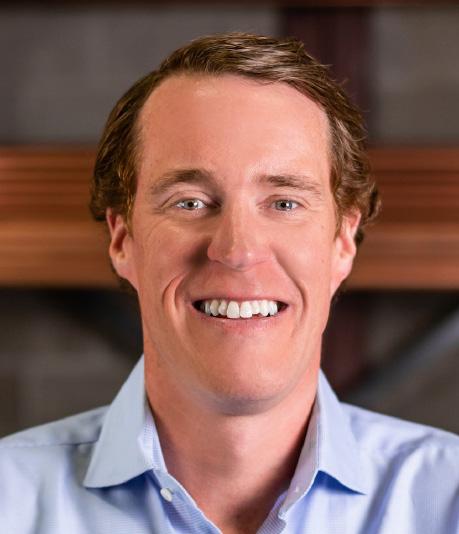
“Culture” is a word we hear often in and around the workplace. We hear it when people tout their favorite parts of their jobs. We also hear it, when people describe challenges in their current work environments. It seems the one thing people are always looking for is a better culture. But what does that really mean?








We all struggle to attract and hire talented people for our teams. According to a 2021 report by the recruiting site, Jobvite, 86% of job seekers state that company culture is somewhat or very important. And it’s not just important for job seekers—company culture is also important for your bottom line. According to Forbes, companies with a good culture have four times higher revenues. Clearly, culture matters.














When I sat down to write this chapter to help define a company culture, I tried to focus on how we embrace it at The Granite Group and how we try to live our culture in a way that supports our people and our team. It is not perfect, but it works for us.
















































































































































































Culture can mean different things to different people. For me, culture is all about a set of values shared by a team. It boils down to how we treat each other and is the pact we share as a team.
Sometimes it is spoken, often it is just lived. And by that, I mean we talk about our culture a lot and try to be very intentional about it. But at its essence, culture is what you do when no one is watching. It is a shared belief amongst team members that says, no matter the circumstance, we share a common mindset on how we treat each other and how we want to be treated.
A more elaborate definition would include words such as values, attitudes, traditions, and beliefs. But in its simplest form, culture is the thing that makes you feel inspired to get up in the morning and go to work. I know what you are thinking—you go to work every day for a paycheck. To be clear, so do I. We all have families to provide for and responsibilities to meet. Compensation matters—full stop.
However, we can also agree that there is something beyond the paycheck that can make you want to go to work each day. Or, in its absence, can make you apathetic—or worse, loathsome about heading into work each day. That thing, that differentiator between inspiration and apathy is your company’s culture.




































































I was fortunate to inherit a culture that was collaborative and welcoming when I joined The Granite Group in 2001. My father, Kevin, was doing the “people-first” thing before there was a term for it. He spent 30 years building a company that people wanted to be a part of before I ever stepped through the warehouse door into my first job.
From day one, I saw the value of the culture at our company, but I also saw the business case for it. In the plumbing, heating, and cooling distribution business, just about everything we sell can be purchased somewhere else, occasionally for less money, often within a 10-mile radius of our shop. If that is your business model—and it is ours in the distribution business—then the only competitive differentiator we have is our people. Our people deliver service, and great service is what keeps our customers coming back. That is the secret to success.


Therefore, as a business, we need to recruit and train the best people possible and then support them with programs and opportunities that will fulfill their needs. Take care of your people and treat them the right way, and they will take care of your customers. It sounds simple, and it is. But we all know too many companies that seem to miss this simple, but crucial, approach.
Like many organizations, we have a list of core values that we think define us and our culture. I was part of the team that first helped codify these values more than twenty years ago. And, like many companies, we overloaded on flowery words and thesaurus-fueled paragraphs when trying to properly define our values. Finally (and mercifully), we scrapped that, boiled our core values down to their essence, and described them in the language we speak.
The core values of The Granite Group’s people-first culture are defined through the acronym PRAISE:






















P rofessionalism—We hold ourselves to the highest standards.
R elationships—We value them. With our customers, with our partners, and with each other.
A ggressiveness—We move fast, and we get things done.
I ntegrity—We do the right thing. Always.
S ervice—We do all we can, every day, to service our customers.
































































E ntrepreneurialism—We are empowered to take the initiative and act on opportunities.
We talk about PRAISE often and use it in our daily conversations. We feel it really represents who we are and what we value. And while we feel these six words encapsulate our culture, sometimes it can be said in an even more straightforward way.
Spoiler alert here—I like to swear. My wife might even say I like to swear a lot. But I do swear, and so do our people, and so do our customers. So, when I described The Granite Group’s Golden Rule as “No Assholes Allowed,” it resonated. Because it is simple. Because it is authentic. And because it is easily understood by all.
It translates cultural theory into relatable language. As you read this, you may be thinking about that asshole you once worked with, or unfortunately, possibly still do. Great people do not want to work for or with assholes. Assholes are culture killers. Don’t allow them into the club.




































































































There is a misperception that a great culture just happens. It does not. You need to actively work to grow it. Because, like a plant, your culture needs to be fed and nourished. If you consistently tend to it, you will see your culture grow stronger by the day. However, if you shove it in a drawer somewhere and only speak of it at some annual awards dinner, your culture will wither and die.
You need to work on it every day as deliberately as you work on any other part of your business. Culture is not a soft, nebulous HR term. It is the central piece of any company’s DNA. You need to work on it as deliberately as you focus on increasing your inventory turns. There may not be as many metrics to track company culture, but if you do not attend to it, it will affect you far more than any GMROI score.











Leaders must first know what they want their company to stand for and then take action to cultivate that vision. It does not happen overnight. A few holiday parties and a free lunch for your people on a Friday alone are not going to do it. Culture-building requires time and commitment. And leaders must embrace their central role in developing their own culture.
As the adage goes, people don’t leave companies; they leave managers. And though we have one culture at The Granite Group, we really have nearly 60 individual cultures, with our entrepreneurial branch managers responsible for growing and developing not just their team, but their branch culture.
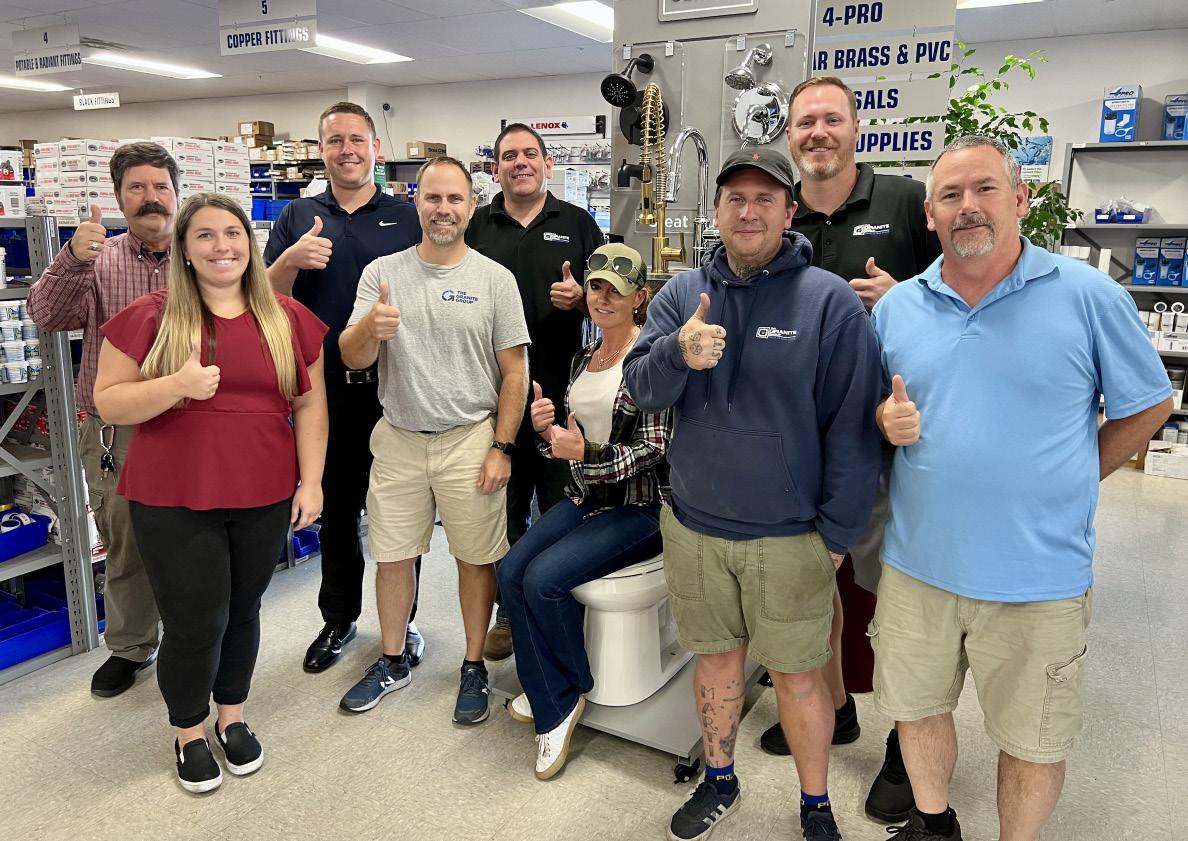
Once the main tenants of a culture are built in an organization, talented local leaders can and should put their own personal stamp on it that reflects their local norms and beliefs. We are incredibly fortunate to have some amazing managers throughout our branches and departments, and we encourage them to add their own entrepreneurial spin to our overall culture in a way that resonates with them and their local teams.



















































































As a company, we have embraced a group of programs and traditions that have helped us codify and strengthen our culture. We have added a few new ones through the years and thoughtfully retired others if, over time, their purpose and usefulness wanted. We cannot be static. We spend a lot of time with our people talking about what they like and do not like about our initiatives and actively change things up based on their feedback.







Below are a few examples of how we try to authentically live our culture in a way that—at its best—provides recognition, shows appreciation, drives engagement, and invests in the professional growth and personal well-being of our people.





















• Every year at The Granite Group’s Annual Meeting, we recognize two individuals, a team member, and a manager, with a CORE Award. Every team member can submit a candidate for who best lives our core values daily. The submissions are then reviewed by a volunteer group of peers who choose the winners. Small aside—we think it’s important that team members choose the award winners—they live it every day, so they should choose who amongst them deserves the recognition. The winners each receive a cash prize and an invitation to travel with us on our next big customer trip. The prizes are great, but at the heart of this award is the pride of being recognized by your colleagues for the way you do your job and the way you live our core values every day.















































• Also at our Annual Meeting, we celebrate commitment and tenure through Service Awards, taking the time to recognize each person who has hit a new 5-year milestone (5 years of service, 10 years, etc.). At the recent 2023 meeting, more than 100 names were announced and applauded, including two people who had been with the company for more than 50 years. This is my favorite part of the entire evening—the chance to recognize so many people who have chosen to dedicate their careers to our company. And to be able to recognize people who have been in the company longer than I have been alive is an incredible honor!
• Our Quarter Century Club celebrates retirees and current associates who have dedicated 25 years or more to the company. This club comes with a lifetime membership—retirees are all welcome to come back and celebrate with current, longtenured team members. We gather that group for dinner once a year and it is fantastic way to celebrate these people who quite literally built the company we are today.
• The Granite Group University (TGGU) has now graduated its second class of emerging leaders. Colleagues nominate participants, and 12 are selected to join a year-long program that includes a leadership development curriculum and team projects rooted in our business. Each participant is paired up with a mentor from the senior team who provides coaching in leadership and business















































































development. Several graduates have already gone on to become branch managers or assume director roles in key functional areas of our business. This has become a great training ground for our future leaders, and we are fortunate to have so many people interested in volunteering for this program.
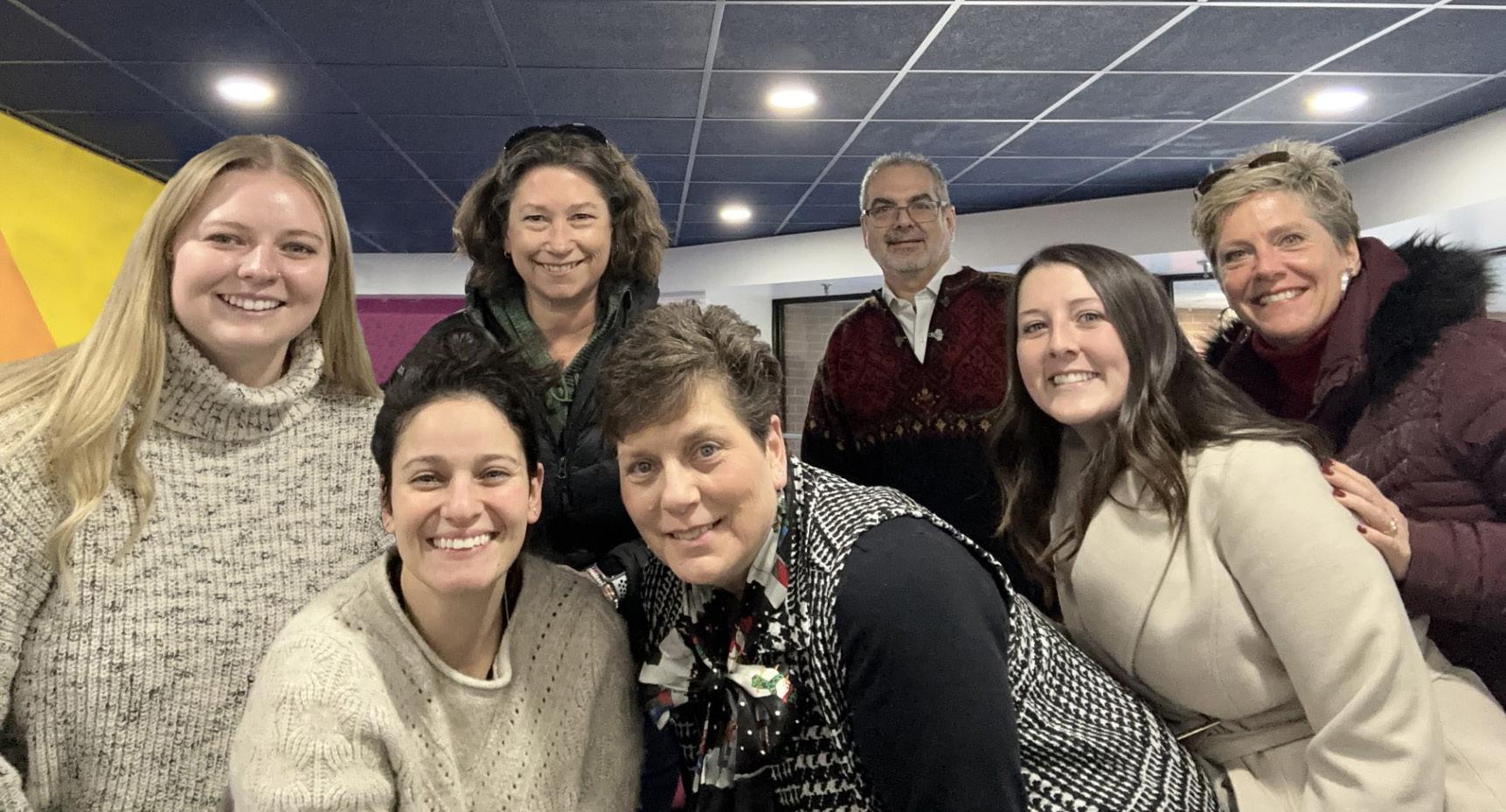
• We feel strongly that our Sales Management Trainee Program has helped fuel our recent growth. We hire as many as 10 young people a year and put them through a comprehensive 18-month training program. We don’t require any experience or expertise in the plumbing and HVAC trades. Instead, we focus on finding the right type of young person who has the drive, willingness, and personality that we think fits best in our company and industry overall. We give them the support and on-the-job training needed to successfully build their careers. Trainees eventually “graduate” into new roles, and many are now are leaders for us in various sales and operations positions throughout the company.
• As the name suggests, we conduct “Quarterlies” four times each year. I and a few other company leaders visit each of our more than 55 branches every quarter to sit down with the local teams. We open the books and share the numbers so that everyone, from managers to truck drivers, knows what we are trying to achieve, how we are doing as a company overall, and how their specific branch is performing. We are a results-driven company. Sharing performance metrics creates a stronger connection to the business for our people. We all have a stake in our success. This is a great example of how your culture—so often misperceived as something “soft”—can help drive the real, tangible results that every business needs to produce to succeed.








































































































































































































• Listening to team members’ ideas, concerns, and suggestions shows that every voice matters. “Town Hall” meetings are also vital to our success. We hold about 1–2 meetings per month where we go into a branch at the end of the day, provide dinner, and pay people for their time as we discuss their issues and concerns with our company. Whereas our Quarterly meetings are more about information sharing, our Town Hall meetings offer the opportunity for a much deeper dialogue and conversation between team members and senior leaders. Before the meeting, we send an email to everyone in the branch with some questions that feed the discussion, such as, “If you owned the company tomorrow, what would you change?” Over dinner, we discuss their thoughts and ideas, and everyone gets a chance to share their perspectives. We take notes and send those notes to the broader leadership team to be sure the constructive criticism from all our people is being heard across the company. It can create a powerful feedback loop for our team members. And it certainly helps us hear and respond to our people’s thoughts and suggestions as we work together to build our business.




























































Our culture also plays out in more subtle ways. We do not have a Human Resources department; we have a People Team. Humans are not Resources, so a few years ago we renamed our HR team to the People Team—a team that is not the reactive, administrative, siloed, and hierarchical team of old. Instead, our People Team focuses 100% on our team members through proactive, strategic partnership with a focus on technology and data—all with care for not only our people, but their families.













Our People Team are coaches, consultants, and guides, with the purpose of “co-creating an incredible, individual People Experience with our People.” We are incredibly lucky to have a strong and dynamic People Team and those who are a part of it do the work, often quietly and behind the scenes, to truly help our people feel valued and supported. A quick text or a quiet call with a spouse in need of some guidance as they navigate a difficult health or insurance issue can offer the kind of relief and support that never shows up in a job description but can mean more than any bonus or benefit.
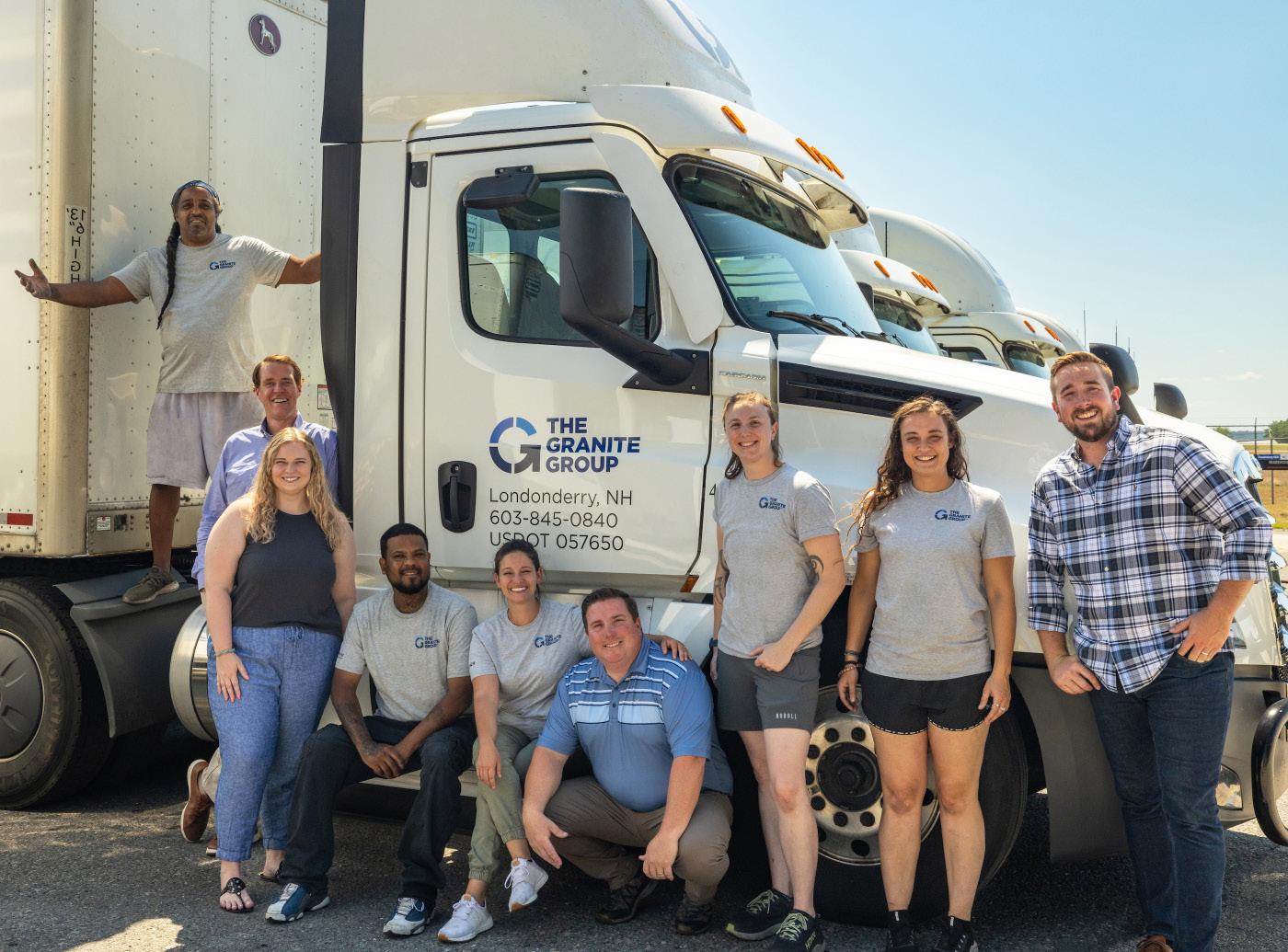










One way we see this care play out is in our company’s revised approach to wellness—or, as we now call it, wellbeing. Years ago, wellness meant going to the clinic to get blood drawn. If you passed, you got a discount on health insurance. We, like many companies, equated wellness with physical wellness. As the world and workforce changed, so did we. While we can’t make people change, we can offer resources—and we offer them for not only physical wellbeing but mental, financial, social, and community wellbeing as well. We now meet people where they are at, offering a large suite of wellbeing offerings from EAP to LifeGuides partnerships to reimbursements for fitness and 5Ks or other activities to our extremely popular TGG Cares Committee, which gets our people involved in giving back to their local community in many wonderful ways.













































The final example to share relates to our company identity. In 2022, we modernized our company branding. We unveiled a new logo and a tagline that reflect the company we have become over the past 50+ years. We wanted the new logo to be friendly and approachable just like we try to be with each other. The new tagline, “Great people. Great products.,” puts our people first and recognizes our team’s commitment to both each other and to the customers we serve. Again, it’s simple, but















we think it quickly captures who we are and what we stand for. As an aside, I was overruled but thought we should just go with a tagline of “No Assholes Allowed.” I think it would have made for some great T-shirts and swag!











I wanted to openly share some of the things we are doing at The Granite Group to attend to our culture. We certainly pride ourselves on having an inclusive culture, where all are welcome, and everyone is treated equally as we all work together to service our customers and drive our company forward. Again, we are far from perfect, but we feel strongly that these shared values that are the building blocks of our culture matter to our people and help drive our success together as a company.



















































































































































































Am I sharing the secret sauce? I don’t view it that way because a great culture does not happen overnight. It takes time—years even—and it must be authentic to each company. We could read countless books on culture and try to implement any one of many different initiatives to try to grow and improve our culture. But if it isn’t real—if it isn’t truly embraced up and down the line in your company—it will fall short. It must sound and feel real. If it does not, people will know.
We have created a group of norms and programs, many of them mentioned above, that work for us and our team. Many other amazing companies in our industry and beyond have embraced wholly different ways of growing and cultivating their cultures in incredibly successful ways that work specifically for their company. There is no cookie cutter approach, and no list of initiatives will sustain a durable culture.












Ultimately, you need to invest the time and effort into the programs and norms that resonate most with your people and your team. It is the longer putt and certainly the more difficult path. Cutting and pasting will not get you there. Listening to your people and building a culture that reflects your shared values will. It takes time, work, and commitment. But the payoff is real, durable, and powerful.
We all want and need great people to join our teams. Great people want to work in a great culture. It will not build itself. But if you make the effort to build a sustainable culture—your sustainable culture— great people will take notice and want to join your team. Assholes need not apply.



 Bill Condron, CEO and President The Granite Group
Bill Condron, CEO and President The Granite Group
Bill Condron is the Chief Executive Officer of The Granite Group Wholesalers, LLC and the third generation of his family to lead the business. The Granite Group is an HVAC and plumbing distributor with more than 55 locations throughout New England. Ranked as one of the 25 largest wholesalers in the United States, the company distributes plumbing, PVF, HVAC, propane, and industrial products to a diverse customer group of mechanical contractors, tradespeople, and builders. The company also operates 15 showrooms under its Sink & Spout brand name and has a burgeoning e-business component at www.thegranitegroup.com.
Prior to joining The Granite Group, Bill worked at UBS in New York City in equity research sales. He holds a BA from Georgetown University and participated in the OPM program at Harvard University. He sits on the board of G2 Capital Advisors and is Chair of the board of the Nativity School of Worcester.












































































































































1. What role does company culture play in attracting and retaining talented employees?
2. How does The Granite Group’s culture contribute to its competitive advantage in the PHCP distribution business?

3. How can a company create a culture of recognition and appreciation to motivate employees and foster a sense of pride in their work?
4. What initiatives and programs does The Granite Group implement to strengthen and live its culture? Which ones do you find most effective, and why?
5. How does The Granite Group involve its employees in shaping and improving the company culture, and why is this important for maintaining a strong culture?
6. What are some key elements of a strong company culture that contribute to employee satisfaction and overall success?







7. How does a positive company culture impact the recruitment and retention of talented individuals?
8. What role do leaders play in shaping and nurturing a company’s culture? How can they actively work towards cultivating a strong culture?
9. In what ways can a company effectively communicate and reinforce its core values to ensure they are understood and embraced by all team members?
10. What strategies and initiatives can organizations implement to support the well-being and holistic development of their employees beyond traditional wellness programs?
• “The Culture Code: The Secrets of Highly Successful Groups” by Daniel Coyle
• “Radical Candor: Be a Kick-Ass Boss Without Losing Your Humanity” by Kim Scott
• “Delivering Happiness: A Path to Profits, Passion, and Purpose” by Tony Hsieh
• Harvard Business Review’s “The Culture Factor,” Jan.–Feb. 2018.
• “How to Create a Remote Team Culture” by Trello.

















• “WorkLife with Adam Grant” podcast, by Adam Grant.
























































































































































































• “Culture Amp’s People Geekly” newsletter; www.cultureamp.com



• “The Culture Blueprint” podcast by Robert Richman.
• “Scaling Up Excellence: Getting to More Without Settling for Less” by Robert I. Sutton and Huggy Rao.




























































































































































 Bill Glockner President and CEO, Hirsch Pipe & Supply
Bill Glockner President and CEO, Hirsch Pipe & Supply

In today’s fast-paced and competitive business environment, emotional intelligence (EI) has become an increasingly essential skill for success. EI refers to the ability to understand, use, and manage emotions in positive ways, all of which can help individuals relieve stress, communicate effectively, overcome challenges, and defuse conflict in the workplace. In a distribution business where employees often face high levels of stress and pressure, emotional intelligence plays a critical role in improving job performance and building stronger relationships with customers and suppliers, ultimately driving business success.
In this chapter, we will explore the concept of emotional intelligence and its four core components: self-awareness, self-management, social awareness, and relationship management. We will also examine the importance of EI in a distribution business and provide practical examples of how it can make a difference in the workplace.
Emotional intelligence is a crucial skill in the modern business world, involving the ability to understand, use, and manage emotions effectively. In a distribution business, EI can significantly impact how employees interact with each other, customers, and suppliers, leading to improved relationships and better outcomes.

























































































































































































Emotional intelligence is a set of skills that enable individuals to understand, use, and manage emotions effectively. The concept was first introduced in the 1990s by psychologists Peter Salovey and John Mayer, who defined it as “the ability to perceive emotion, integrate emotion to facilitate thought, understand emotions, and to regulate emotions to promote personal growth” (Salovey & Mayer, 1990).











Since then, researchers and practitioners have expanded on this definition and identified four core components of emotional intelligence: self-awareness, self-management, social awareness, and relationship management.

• Self-awareness refers to the ability to recognize one’s own emotions and how they affect behavior, performance, and relationships. Self-aware individuals can accurately identify their emotions, strengths, and weaknesses, using this information to guide their actions and decisions.






















• Self-management involves the ability to control emotions and impulses and adapt to changing circumstances. Individuals skilled in self-management can regulate their emotions effectively, remain calm under pressure, and make good decisions even in difficult situations.
• Social awareness is the perception and understanding of the emotions of others as well as the dynamics of different social situations. Individuals who are socially aware can read social cues, accurately interpret the emotions of others, and respond appropriately.


• Relationship management involves the ability to build and maintain positive relationships with others, navigate conflicts, and effectively handle difficult conversations. Individuals skilled in relationship management can communicate effectively, resolve conflicts constructively, and build strong relationships with customers, suppliers, and colleagues.

With EI, people can monitor their emotions as well as those of others, discriminate between different emotions, label them appropriately, and use emotional information to guide thinking and behavior. EI is crucial for effective communication, teamwork, leadership, and conflict resolution in the workplace. Employees with high emotional intelligence are better equipped to handle stress and maintain a positive attitude, leading to increased job satisfaction and productivity. Furthermore, organizations with emotionally intelligent leaders tend to have higher levels of employee engagement and retention.
































EI is critical in a distribution business for several reasons. First, it helps employees manage the stress and pressure that come with working in a fast-paced, high-demand industry. By understanding and managing their emotions, employees can stay calm and focused, even in challenging situations, which can improve job performance and reduce the risk of burnout.





























































































Second, EI can help employees communicate effectively with each other as well as with customers and suppliers. By understanding the emotions and perspectives of others, employees can tailor their communication styles to be more effective and impactful. This can help build stronger relationships and lead to better outcomes in negotiations, sales, and customer service.
Third, EI can help employees overcome challenges and navigate conflicts in the workplace. By recognizing and managing their emotions, as well as understanding the emotions of others, employees can find common ground and work together to find solutions to problems. This can lead to more effective problem-solving and decision-making, as well as improved morale and job satisfaction.





























































EI helps individuals recognize and manage stress, contributing to a healthier and more productive work environment. In a distribution business, employees skilled in self-awareness and selfmanagement can effectively manage their stress and pressure, remain calm under pressure, and make good decisions even in difficult situations. For example, encouraging an employee who is feeling overwhelmed with a large workload to take a break, practice deep breathing, or engage in some other stress-reducing activity will help them stay focused and productive.
One of the most beneficial ways to manage stress is to find laughter in the workplace. At Hirsch, we emphasize the value of having fun in the workplace, and we like to sponsor employee lunches, customer and employee events, and other activities to bring more fun into the workplace. These activities reduce stress and increase the emotional bond between the employees and customers.




















































































































EI enables individuals to understand and convey emotions effectively, resulting in clear and efficient communication. In a distribution business, effective communication between colleagues is essential for success. Employees who are skilled in social awareness and self-management can tailor their communication styles to be more effective and impactful.























For example, an employee who is communicating with a stressed and agitated colleague can use active listening skills to validate their feelings, offer support and encouragement, and work together to find a solution to the problem at hand. One practice we have found useful involves reflective listening, which uses the phrase, “If I.” When a customer complains about something that upset them, we don’t like to argue about whether we agree with their viewpoint. Instead, we just respond with “If I [put their viewpoint here on how the expectations were not met], then I am truly sorry.” In this way, we are acknowledging their viewpoint without necessarily expressing agreement with it.
Recently, a customer Tony who works for one of our clients returned to one of our stores and he stated that was upset about a purchase. He had brought a hot and cold replacement stem for a shower value, and he received two hot stems, which he installed to make the customer happy for the moment. Tony now wanted the cold stem for free so he could return and complete the job to the client’s satisfaction. Tony was upset about the mistake as well as his lost time and expressed his frustration.

Our salesperson, Brandon, did a good job of staying calm despite Tony’s heated demeanor. Brandon reminded himself of the value of understanding the customer’s emotions and perspectives. Instead of reacting defensively or brushing off the complaint, Brandon practiced active listening, allowing Tony to fully express his frustrations.


With empathy, Brandon responded to Tony, “If I provided you with the wrong material and made it impossible for you to complete the client’s job successfully, then I am truly sorry,” thus acknowledging the inconvenience Tony experienced from this error to his order. Brandon assured Tony that he genuinely understood his concerns and would do everything possible to resolve the issue promptly.
























































As the conversation continued, they both exhibited a calm and compassionate demeanor, and Brandon worked to provide the part Tony needed so that he felt heard and valued as a customer. Tony appreciated the respectful treatment and genuine concern shown by Brandon and his frustration subsided. In the end, Tony expressed gratitude for the personal attention he received.




























































































Leaders with high EI inspire team members to work efficiently, ultimately contributing to organizational success. Leadership has a direct influence on the culture of the work environment, and studies have found that the impact of the leader on the behavior of employees is significant. Leaders who possess high levels of EI can inspire team members to work efficiently to achieve organizational goals. They can create a positive work environment by exhibiting empathy, understanding, and managing their emotions effectively. This can lead to better employee engagement, productivity, and overall organizational effectiveness.
It is important for leaders to help their team understand that differences between team members are normal and are, in fact, often necessary due to of the different kinds of work being performed. For example, at our management retreat one year, we did a Meyers-Briggs personality assessment. We asked managers to line up based on their different personality traits from the test, such as extroverts vs introverts, sensors vs. intuitives, judgers vs. perceivers and thinkers vs feelers. Then we discussed how sometimes it is easier to relate to and support people who have the same personality traits that we have, and that we are often challenged when someone has different traits than we do. We discussed how we may not always have the understanding and patience we should have with each other. The group discussed how individuals may not be as well suited for certain types of work because, of their personality traits, and we all should be appreciative of others who are doing that work because by being different than us, they are good at their jobs. In the end, it takes many different personalities and job roles to make an organization work, and we all should practice understanding, patience, and mutual respect to work well together.
As a result of these types of interactions at our manager retreats, Hirsch experienced improved internal communication among our team members and enhanced external interactions with customers and suppliers. We believe our emphasis on emotional intelligence drives the company’s success, helping it stand out in a competitive market and building lasting relationships with its team members, customers, and suppliers.





















































































































































































Emotionally intelligent individuals can identify, address, and resolve conflicts in a constructive manner. EI allows people to adapt to challenges, face adversity, and find solutions. EI also helps in identify talents, delegate roles accordingly, and resolve conflicts amicably, thus overall improving team performance and efficiency.








In the distribution business, challenges and conflicts are inevitable. Employees who are skilled in self-awareness, social awareness, and relationship management can effectively navigate these challenges and conflicts, find common ground, and work together to find solutions. For example, two employees who have different opinions on how to approach a particular problem can use their emotional intelligence to listen to each other’s perspectives, validate each other’s feelings, and come up with a mutually acceptable solution.

EI is a vital skill for achieving success in the workplace, as it helps individuals understand and manage their own emotions and those of their colleagues. The importance of EI in the workplace can be further expanded by incorporating concepts from the book “Your Brain at Work” by David Rock.
One concept from the book is the SCARF model, which stands for Status, Certainty, Autonomy, Relatedness, and Fairness. These are the five social domains that humans instinctively react to in social situations. Understanding the SCARF model can help employees navigate social interactions more effectively and contribute to a positive work environment.
When emotionally intelligent employees understand these social domains, they can recognize and respond to the needs and concerns of their colleagues. For instance, by providing employees with opportunities for growth (Status), clear communication (Certainty), choices in their work (Autonomy), a sense of belonging (Relatedness), and fair treatment (Fairness), leaders can create a positive work environment and enhance overall organizational effectiveness.














Another concept from “Your Brain at Work” includes is the notion of “minimizing the threat response.” Emotional intelligence helps individuals recognize when they or their colleagues are experiencing a threat response, which is a natural reaction to perceived threats. By managing emotions and using empathy to understand others’ perspectives, emotionally intelligent individuals can minimize the threat response and create a more positive atmosphere.
Lastly, “Your Brain at Work” emphasizes the importance of reflection and learning from experience. Emotionally intelligent employees can use their self-awareness to reflect on their actions and emotions, learning from past experiences to improve future performance. This continuous learning process helps individuals develop their emotional intelligence skills and become more effective leaders, team members, and problem solvers.
At Hirsch, we actively use the SCARF model to moderate conflicts in our workplace, often referring to it in meetings to help our people see where a conversation started to become a conflict. Frequently, when we see tensions start to rise, we will ask that we take a meeting break to allow people to cool off. During the break, we talk with those having the disagreement separately about how their comments might have set off a SCARF response. Often, just recognizing what triggered the threat response allows people to regain control of their emotions and allows the conversation to resume more productively.
Also, during our meetings to point out or acknowledge where there may be SCARF pitfalls from a certain decision or communication. For example, recognizing how a decision may reduce a team member’s autonomy might be perceived as a threat if we do not take the time to communicate effectively why this change is necessary and how it will benefit the team member.
Another technique we try to incorporate in our meetings is to ask for a celebration of wins or a statement of appreciation around a business challenge. We do this before digging into the analysis of what went wrong instead of just starting off a discussion about the business challenge by offering prescriptions for a change. This helps to reduce the threat response because the people involved in the business challenge maintain a sense of relatedness and fairness from being supported in what they did well and not feeling attacked immediately as if they did something wrong.















































































































































Effective use of EI can create a positive service environment, contributing to customer satisfaction and future loyalty. In a distribution business, strong relationships with customers are essential for success. Employees who are skilled in social awareness and relationship management can effectively communicate with customers, understand their needs and perspectives, and build strong relationships based on trust and respect. For example, a sales representative who can read a customer’s body language and tone of voice can tailor his or her sales pitch to address the customer’s concerns and needs, ultimately leading to a successful sale.

Emotionally intelligent employees can also empathize with customers’ concerns, manage their emotions, and provide effective solutions. By recognizing the emotions of the customers, employees can address issues promptly, create an empathetic response, and build trust with customers. This approach reduces the chances of escalating conflicts and encourages repeat business.





One instance we encountered involves a customer who came in and demanded a credit because he believed he had ordered a 50-gallon water heater, but the branch had delivered a 75-gallon water heater. Instead, the customer, who was a plumber’s technician, went ahead and installed the larger water heater. The customer had quoted his client for a 50-gallon water heater, but now could not increase his price. The manager asked his salesperson what happened, and he clearly remembered the customer’s ordering a 75-gallon water heater.

The manager engaged with the customer and explained that there seemed to be some question about whether the mistake was our fault. Setting that aside, the manager asked the customer what he felt would be a fair outcome. The customer said that he thought they should at least split the cost difference 50/50. The manager said immediately, “Done.” The customer expressed surprise that he would accept that so quickly, to which the manager said, “Our relationship is so important, I would have covered the whole thing, but since you proposed 50/50, I will go with that.” The customer and manager laughed about it together and went on to do additional business over the next several years always enjoying referring back to this interaction. By using EI, our manager secured a customer for life.









































































































































































Employees with high self-awareness can recognize their emotions and understand how they affect their work performance. They can then use selfregulation techniques, such as deep breathing or taking a break, to manage their emotions effectively. This leads to improved job performance by preventing emotional outbursts and impulsive decision-making.




One of our practices is to take breaks during manager meetings where we do a stretching exercise or walk around the building to help our minds reset. We have done some group breathing exercises to make sure the group feels refreshed. Although it might seem to like a waste of time to some, we have found the remaining time to be much more productive, making these EI breaks worth it.

























Emotionally intelligent team members can effectively understand and manage their own emotions and those of their colleagues. By recognizing the emotional states of their coworkers, they can adapt their communication styles to foster a positive work environment. This leads to increased collaboration and higher productivity among team members.



As previously mentioned, we have found it critically helpful to have our managers understand their differences using tools such as Meyers-Briggs or other personality tests. We have also had great success building a more collaborative management team by having manager retreats offsite where, in addition to strategy sessions, we devote sessions to team building and fun activities such as bowling or lip sync challenges. These EI sessions increase the team’s commitment to each other.















Emotionally intelligent individuals can use their emotional awareness to make informed decisions. They can assess the emotional implications of different options and consider how their decisions may impact others. This leads to well-rounded decision-making processes that consider the needs and feelings of the stakeholders involved.




We try to understand the feelings that team members might have around a decisions so that we can plan on change management and communication strategies that will make the decisions go more smoothly. Often, we will involve team members to the greatest extent possible to make sure that there is buy-in on a particular decision. Understanding that there is an emotional impact to every decision that can affect its eventual outcome as a success or failure.





























































































































Emotional intelligence is a critical skill for success in a distribution business. By understanding, using, and managing emotions in positive ways, employees can manage stress and pressure, communicate effectively with others, overcome challenges and defuse conflicts, and build strong relationships with customers, suppliers, and colleagues. Through the four core components of emotional intelligence–self-awareness, self-management, social awareness, and relationship management–employees can develop the skills they need to succeed in a fast-paced and demanding industry. By prioritizing emotional intelligence, distribution businesses can create a more positive and productive work environment, leading to improved job performance, customer satisfaction, and ultimately, business success.
The ability to recognize and manage emotions is essential for effective communication, leadership, and conflict resolution in the workplace. Organizations should prioritize emotional intelligence training for their leaders and EI as a key hiring criterion for employees. By doing so, organizations can improve overall performance and cultivate a positive work culture.





Bill Glockner is Hirsch Pipe & Supply’s president and CEO since 2000 and was the American Supply Association’s (ASA) president in 2020. Bill has been in the industry since he joined Hirsch Pipe & Supply in 1991. Bill has grown Hirsch Supply into a Southern Californian mainstay that now has 23 branch locations stretching as far south as the U.S.-Mexico border in Chula Vista to as far north as Valencia, north of the valley in the Los Angeles area.
Bill’s wife, Susan, is a family physician, and his daughter, Katie, is an epidemiologist with Sutter Health in San Franscisco. Katie’s husband, Bill’s son-in-law Mike, is an engineer at a robotics start-up in Berkeley, CA. His son, Will, is completing his Master of Landscape Architecture degree at the University of Arizona in 2024.











































































































































































































1. How does EI contribute to the success of individuals working in a fast-paced and competitive distribution business? Share specific examples to support your answer.
2. Reflecting on the four core components of EI (self-awareness, self-management, social awareness, and relationship management), which component do you believe is the most crucial for effective communication within a distribution business? Why?
3. In your opinion, how can EI help employees in a distribution business relieve stress and manage high-pressure situations? Share practical strategies that individuals can employ to enhance their EI in such circumstances.
4. Discuss the impact of EI on customer satisfaction in a distribution business. How can EI employees build strong relationships with customers and suppliers, leading to better outcomes and increased loyalty?
5. In what ways can leaders with high EI inspire and motivate team members in a distribution business? How does EI contribute to creating a positive work environment and enhancing overall organizational effectiveness?
6. Share an example of a challenging situation or conflict that could arise in a distribution business. How can employees with high EI effectively navigate and resolve this conflict, ensuring a positive outcome for all parties involved?







• “Emotional Intelligence 2.0” by Travis Bradberry and Jean Greaves.

• “The Science of Happiness” Podcast by Greater Good Science Center




















































• “Emotional Intelligence and Leadership: A Review” by Ronald E. Riggio.
• TED Talk: “The Power of Emotional Intelligence” by Travis Bradberry.










• “Emotional Intelligence in the Workplace” (whitepaper) by TalentSmart.
















































































 Interim Associate Dean for Research, Professor
Interim Associate Dean for Research, Professor

















































































































































Purdue University
Matthew L . Schnell
Ph.D. Student, Engineering Technology























































Purdue University
Healthy wholesale-distribution businesses intentionally focus on key performance indicators (KPIs) that help managers improve daily operations and monitor financial indicators. These KPIs are a selection of financial ratios that provide managers with the information needed to keep their businesses running at their best.

There are many recommendations for the “best” KPIs to use in distribution, although the truth is they may be different depending on the nature of the business, or the position held or whether you’re a top-level executive or mid-level manager. For example, it wouldn’t make sense for a distributor selling to contractors to focus on the same KPIs as one that sells to manufacturers (although there would certainly be overlap). It also wouldn’t make sense for a purchasing manager to regularly focus on the same KPIs that the sales manager does. Without clear direction from the top, their targets might even be in conflict with one another!
The very best wholesalers have top managers that are financially savvy and provide guidance to their managers about the various KPI targets used in the organization. In doing so, they must communicate how those can and should support all operations to benefit the organization, and ensure employees have the training to use them wisely.


This chapter provides recommendations for KPIs, both financial and operational, and teaches you about the key financial statements needed to calculate them. KPIs track and manage an organization’s financial performance over time. Learn as much as you can about this subject with an eye

toward optimizing your organization’s performance and financial success. Over time, this information can be used to identify your company’s strong and weak points, and aid in strategic decisionmaking for the company’s future directions.






Know that you live in an era where more data is available to gather than you could possibly use in a practical way. Using too many KPIs will not automatically mean you will be more successful and may not be worth the extra time to gather and interpret. This chapter includes the “essential” KPIs that any wholesale-distributor manager must know.



















































































When about KPIs, knowing the general categories of financial ratios can help you understand the nature of the KPIs measured. You likely use some of these on a regular basis without necessarily knowing how they are calculated or why they are important. Some common examples include gross margin, inventory turnover, sales per employee, etc. These are measured annually, but some may also be tracked throughout the year.




























































It’s also valuable to observe these indicators by using multi-year trend analysis in a side-by-side chart, or to compare your company’s performance against those reported in the ASA’s Annual Operating Performance Report (OPR).

1. Sales per Employee
2. Gross Profit per Employee





































































































































































3. Personnel Productivity Ratio
You may not be familiar with some of these, but you will learn more about them in detail. The goal is to help you interpret each KPI and understand what potential options you have to improve to positively impact your business.

The first step is to learn about three common financial statements: the Income Statement (also known as the Profit and Loss Statement or P&L), the Balance Sheet, and the Cash Flow Statement. Each of these is calculated annually for the company and carefully analyzed. Information may also be placed side-by-side with prior years’ numbers to conduct a trend analysis. This is done to determine whether performance is improving or declining during certain years. These can also be used to compare performance with other similarity sized companies in your trade group.
The first statement we will examine is the Income Statement (or P/L) which contains a summary of a company’s operations (income and expenses) over one year. Some companies examine them quarterly to track progress during the year, but the yearly one is used for financial analysis and tax reporting, as well as multi-year analysis.
















A income statement equation comprises the income statement looks like any budget: revenue represents the money coming into the business that is available to spend, and business expenses are subtracted from that to calculate net income, or (net loss).
Sales Revenue

• Assets (cash or AR) created through business operations.
Minus Expenses
• Assets (cash or AP) consumed through business operations.
Equals Net Profit or (Net Loss) Generated From:




















• Revenue – Expenses

The purpose of the income statement is to record the main financial categories in a way that illustrates the multiple calculations used to get to the “net profit” or “bottom line.”
Below is a multi-step view of the income statement commonly used and includes several steps to illustrate how net income is calculated. This is a very condensed view for illustrating basic components; in real business situations there can be many items listed.
Example ASA Corp .






Income Statement






For Year Ended December 31, 2023














































Revenue

– Cost of Goods sold

+ Rebates*





















































































= Gross Profit
– Total Operating Expenses
= Operating Profit or Earnings before Interest and Tax (EBIT)




– Interest
= Earnings before Tax (EBT)
– Tax

= Net Profit or Net Income or Bottom Line
* Please note that this example includes the addition of rebates which may come to businesses at the end of the year as shown in the latest ASA OPR. This addition to total revenue is common for many wholesalers, but that varies widely across the U.S. depending on location, product lines, and volume size of the business. Most examples in this chapter will not include rebates.
Here are definitions of the items used in the income statement outlined above:
• Revenue (Sales)—revenue is the first item on the income statement, or the “top line.” Also known as sales, net sales, total sales, or total revenue; it consists of all incoming funds from direct sales, rebates, investments, rent, royalties, services, etc. Net sales (made after all returns and adjustments needed for the year) are used in the examples.
• Cost of Goods Sold (COGS)—the total cost your business has paid that is directly related to the sale of products. These costs may include products purchased for resale, raw materials or parts used on product, packaging, and labor. COGS is the largest cost that must be paid between revenue and net profit and must be managed carefully.
• Gross Profit—calculated by subtracting COGS from sales revenue. You can use single-item transaction or purchase order. Gross profit can also be calculated for the sales of a product line and or total branch. Gross profit (gross margin if expressed as a percentage) is a very important measure that is used by managers to assess overall profitability. This is the starting point to achieving a healthy net profit.
Sales Received ($200)
– Cost of Goods Sold ($150)


























































= Gross Profit ($50)











































































































































• Operating Expenses: These are expenses that a business incurred through normal business operations . However, they don’t include the costs of goods sold or capital expenditures(larger expenses such as buildings or machines) Some examples include:
• Selling, general, and administrative expenses (SG&A)—costs associated with operation of the business entity not directly related to the cost of goods sold. SG&A expenses include costs such as advertising/promotions, commission paid to sales representatives, insurance, office supplies, utilities, salaries of administrators, etc.






• Depreciation expense—the allocation of the cost of a tangible asset over its useful life. Depreciation is a way of spreading out the costs associated with large item purchases over the period of time when you will use them. For example, if a $10,000.00 machine is purchased that will be usable over 10 years, depreciation allows the asset to be expensed over those 10 years at $1,000.00 per year. By depreciating this machine over 10 years, the net income will not be as heavily impacted by the purchase. Otherwise, the large expenditure might lower profit in a way that suggests the company is not performing as well as it had in prior years.

• Operating Profit—a profit made from core business operations before deducting interest and taxes. It is calculated by subtracting the operating expenses from the gross profit. Operating profit is commonly referred to as EBIT: earnings before interest and tax.
Gross Profit ($50)






































































































– Operating Expenses (EBIT) ($35)
= Operating Profit ($15)



• Interest Expense—the costs associated with borrowing money. To finance operations, it may be necessary to borrow funds. As long as the profit from those operations is greater than the interest incurred in the loan, the firm has generated a profit by borrowing this money. This profit generated by using borrowed funds is referred to as financial leverage.
• Earnings Before Tax—this is simply pretax income that is calculated by subtracting the interest expenses from EBIT.
Operating Profit (EBIT) ($15)
– Operating Expenses ($5)


















= Pretax Income (EBT) ($10)
• Taxes—the amount owed to the government computed by multiplying the tax rate by the pretax income. The tax rate varies based on several factors, such as the type of organization, the amount of taxable income, and applicable tax laws based on the company’s location.
• Net Income—also referred to as net profit, earnings after tax, or bottom line, is the amount the business has earned after all expenses have been paid. It is computed by subtracting the taxes from the pretax income. For all income statements in this chapter, we will only report to earnings before taxes.





Pretax Income (EBT) ($10)
– Taxes @ 35% ($3 .5)





















= Net Income (EAT) ($6 .5)

Below is an example of an Income Statement for a company selling $15,000,000. This statement was constructed with a starting point of $15,000,000 sales and was completed based on averages found in ASA’s 2023 Operating Performance Report for small firms with sales of $15 million in volume and under.

Example ASA Corp . (Based on ASA 2023 OPR, All Respondents) Income Statement



For Year Ended December 31, 2023




















































































































































































Net Sales $ 15,000,000

Cost of Goods Sold $ 10,605,000
Gross Profit before Rebates $ 4,395,000
Purchase Rebates $ 615,000
Gross Profit after Rebates $ 5,010,000






Total Operating Expenses $ 4,170,000
Net Operating Profit $ 840,000













Interest Expense $ 60,000
EBT $ 780,000
Here is another view of that income statement put into a “common-size” format for the period ending December 31, 2023. A common size income statement is computed by computing each item as a percentage of total sales (the top line). It is often used to compare companies of different sizes or to compare between different years for the same firm. This example provides you with the average numbers for each line item in the statement based on those reported for all responding firms in the ASA 2023 Operating Performance Report. For example, the average COGS for ASA firms in the $15 million and under category was 70.7% of sales and the average gross profit before rebates was 29.3% of sales. Likewise, the net operating profit was 5.6% of sales and the earnings before taxes was 5.2%. The OPR did not report after tax numbers because they are so variable.
Statement

For Year Ended December 31, 2023














































































































































The Balance Sheet is a document that lists all the business accounts in their corresponding categories including assets, liabilities, and equity in a firm at one point in time–just like a taking a snapshot of each balance on one day a year (typically December 31, although fiduciary (legal) years may not always match the calendar). These three accounts are always placed in order so that Assets are equal to Liabilities plus Owner’s Equity; the illustration below accurately represents those three categories and illustrates that those two sides must always balance. This is a generic example of a Balance Sheet for the purposes of demonstration.


After completion of this chapter, the reader is encouraged to look at the financial statements from the annual report of a public U.S. company of your choice. Googling “[Company name] annual report” should direct you to such a report. Annual reports are required for every publicly traded company in the U.S.





Even though the numbers on the balance sheet are reported for a single day of the year, the account balances never go away. Instead, they continue to accrue, decline, or defer:
• Assets: Anything that has current or future economic value to a business is assets. These are listed in order of liquidity and recorded at historical costs (liquidity is how quickly an asset can be converted to cash without affecting its value). Assets can be either short-term or long-term. Short-term assets are used for up to a year, such as cash, accounts receivable and inventory, while long-term assets may benefit the company for many years, and includes plant, property, equipment, investments, and software.



















• Cash: Actual cash in the business.




• Liabilities: Defined as claims against the assets of the firm. They should be listed in decreasing order of liquidity (with most liquid first).









































• Owner(s)’ Equity: Owner’s total investment in the firm.

• Net Worth or Total Equity: Assets minus Liabilities











































































































































Another way to think about a balance sheet is to consider it as an illustration where company assets on the left side (resources used to run the business) can only come from one of two sources illustrated on the right side of the balance sheet; they are either “borrowed” or “owned.” Therefore, those two sides must balance.

Assets: Uses of Funding
Liabilities + Equity: Sources of Funding Resources


It might be easier still to view the next chart that shows the same financial categories with the key accounts listed, but this time those assets listed on the left are labeled as everything the business owns, and on the right side, it labels those as dollars owed for those assets, or those that are equity (the owners’ shares of the business).
Assets: (everything the business OWNS)
Current Assets
Cash Stock
Fixed Assets
Equipment
Premises
Total Assets
Liabilities/Debt: (Everything the business OWES)
Current Liabilities














































Creditors
Short-term loans


Long-term Liabilities
Loans
Total Liabilities

















































Equity: Value of Owners’ Share(s) of the business
Owners’ initial Investments


















































Retained profits/Loss (not same as cash!)
Total Owners’ Equity & Retained Earnings
There is one more piece of the balance sheet: retained earnings (or earnings surplus). Retained earnings are often listed on the balance sheet in the equity section (you can see $600,000 in the balance sheet example previously). They are the accumulated net profits of a company that are “left over” after dividend payments (assuming the owners take a share of the profits). Although this earning “surplus” is retained in the business, it is not considered a separate asset but becomes part of the operating funds that can be used to purchase assets such as inventory, equipment, etc.























As implied by the title, the statement of cash flows is used to track the movement of cash as it flows through the organization in three major categories: operations, investments, and financing. It provides a detailed picture of what happened to a firm’s business cash during a specified time (the accounting year). It may help demonstrate a firm’s ability to operate in the short and long term based on how much cash is flowing into and out of the firm.
Opening Cash Balance























































































+/- Cash Flow from Operations





































+/- Cash Flow from Investing Activities






+/- Cash Flow from Financing Activities
































= Ending Cash Balance



















Operating Activities
Investing Activities
Company Cash
Operating Activities
Investing Activities
Financing Activities
Financing Activities
At first glance this illustration looks complicated, the activity within each of them is largely common sense. For example, operating activities have inflows from sales and interest revenue, and outflows from payments for inventory, wages, taxes, etc. By examining them carefully, each will become familiar.
Cash Inflows
• Sale of goods or services
• Sale of investments in trading securities
• Interest revenue
• Dividend revenue



Cash Inflows
• Sale of plant assets
• Sale of securities, other than trading securities
• Collection of principals on loans
Cash Inflows
• Issuance of own stock
• Borrowing
Cash Outflows
• Inventory payments
• Interest payments
• Wages
• Commissions
• Utilities and rent
• Taxes
Cash Outflows
• Purchase of plant assets
• Purchase of securities, other than trading securities




























• Making of loans to other entities
Cash Outflows
• Dividend payments























































































































• Repaying principal on borrowing
• Treasury stock purchase
Here is an example of a Statement of Cash Flows illustrated in millions of dollars:



For the Year Ended December 31, 2023










































































































































Cash Flows from Operating Activities:
Receipts $ 48

Payments $ (43) $ 5












































Cash Flows from Investing Activities:
Receipts 0
Payments $ (4) $ (4)
Cash Flows Used by Financing Activities:
Receipts $ 10
Payments $ (6) $ 4
Net Cash Flow = $ 5
In the statement, you see that cash flows from operating activities equaled $5 million, cash flows from investing activities were a negative (outflow) of $4 million, and the cash flows used by financing activities turned out to be $4 million. The final calculation for all of the cash flows ended up being a net cash flow of $5 million for the year.
You have seen that both the income statement and balance sheet provide details of business accounts at an overall level of analysis, yet they also provide the very important details needed to calculate those important financial ratios considered KPIs. The statement of cash flows is also important because it tells you where you may be spending cash too fast in the business, versus where you are generating cash. Knowing those details is critical to keeping the business operating.

















While savvy owner/managers can learn a great deal by looking only at financial statements, the important information to be gleaned from them requires managers to use two or more items on an income statement/or balance sheet to develop a financial ratio to evaluate a company’s operating and financial performance. Start with the most important measure: Profits! Obviously, this is a function of sales, costs of goods and services, and the resulting margins and profit performance. These also help you determine how “efficiently” you are using your assets and equity to generate income. All of these provide information about the business performance, especially when you can compare it to your own as well as other companies.

Profitability is typically not well understood by employees in the distribution business. I have often asked distributor employees what the percentage of the sales of the business they work for was “profit” for the owner(s). Answers vary a great deal, but most of the time the answers range from 10% - 50%. That guess is far from the truth–and they are often shocked when I tell them that on average companies in 2022 made 8% net profit of sales before taxes! Companies operating at $15,000 and under made an average of 5.2%. And there have been many years when it was lower.





































































Let’s take a simple look at an illustration of the sales and profit relationship based on sales at 100%. In the chart below, total sales revenue is the bar on the left and it is divided into 2 sections which represent cost of goods sold (COGS) and Gross Margin Percent. As you can see, for all ASA firms, Sales Revenue (100%)–Cost of Goods Sold (69.4%) = Gross Margin (30.6%).
On average, the dollars represented in that 30.6% gross margin cover everything that a company has in that year to pay for the business to fully operate and make a profit! Obviously, COGS is where the lion’s share of the total sales dollars are spent. If we go to the column on the right, we can see a simple breakout of how the dollars remaining in the gross margin are broken out. Out of the 30.6% Gross Margin, we can see that operating expenses take up 22.5% of sales revenue, and the net profit takes up 8.1%. Out of the 100% Sales Revenue represented on the left, only 8.1% net profit is left before taxes. This simple illustration should help you understand that management must be very watchful of both cost of goods sold and operating expenses to have a healthy net profit.




























































With knowledge of the financial statements in mind, calculate each KPI. Use the example income statement and balance sheet for December 31, 2023, of a mid-size company with $40,000,000 in sales. Include KPI listed at the beginning of the chapter.
































































































































































































































For
For

A. Profitability: Sales and Revenue Performance . Tracking sales and profits is important to identify trends such as growth or decline in sales. There are many potential reasons for such trends; sometimes increases are simply a byproduct of inflation (price increases appear to be increased sales), a good economy, or cyclical or seasonal trends. It could also be due to the launch of a new product line that is having a positive impact. Knowing how to calculate a percent increase or decrease between two numbers is necessary for quantifying or understanding such changes.
Below is an example of an increase in sales from $37,900,000 to $40,000,000. This is easily done by calculating the difference between the two numbers (sales period 2–sales period 1) and dividing the increase by the original number and multiplying the answer by 100. So: percentage increase = amount of increase / original number x 100. Similarly, calculating a percentage decrease is = amount of decrease / original number x 100.



a. Sales growth —the overall growth in revenue from one period (typically yearly or monthly) compared to another period.



We will consider the previous year with sales of $37,950,000.


b. Gross profit and gross margin performance–the percentage of income remaining after COGS have been expensed. This can be expressed as gross profit dollars or gross margin percent. The gross margin is a critical measure for wholesalers because it tells them whether they are selling at a price high enough above their own cost of goods to cover operating expenses and make a profit.
Gross profit dollars = Sales – Cost of Goods Sold =




Example: = $40,000,000 – $30,000,000 = $10,000,000























































































Gross profit margin = Gross Profit Total Revenue X 100%































Example: Gross margin = $10,000,000 $40,000,000 X 100% = 25.00%















Keep in mind that it is easy to confuse the gross profit margin with a mark-up. To find the gross profit margin, divide the gross profit by the total revenue. A “mark-up” is calculated by dividing the gross profit by the cost of goods sold. What’s the difference? If a wholesaler buys a widget at $150 and sells it for $200, it makes a profit of $50, which was 25%





of the selling price and a 25% Gross Margin. What if that same $50 profit was divided by the cost of goods sold of $150.? The result would be a 33% mark-up, which looks higher but is a disaster for profitability. Setting a price based on a mark-up of 25% will yield a margin of only 20%, not 25%. Here’s an example of why confusing margin and mark-up costs money.
25% GM from a 33% MU 25% MU Yields 20% GM






















*Marked up 33 1/3%




















































































**Marked up at 25%
Pricing decisions are also critical to protecting your bottom line. Your managers and salespeople must understand that constantly lowering prices kills profits! Here’s an example of why:
• Distributor charges $100 for an item they paid $75 for . . .







• $100 selling price - $75 cost = $25 gross profit
• To be competitive, they offer 10% off the price.
• $90 selling price - $75 cost = $15 gross profit
End result: $15 gross profit

























$25 gross profit = 60%, or 40% less profit!
TAKE NOTE!! A 10% price reduction results in 40% LESS PROFIT!!!






























c. Net Profit margin—the percentage of income remaining after all expenses have been paid before taxes are taken out.




































d. Return on Assets (ROA)—the percentage of income generated in each period with the given total asset investment. It measures how efficiently a company’s management is generating profit from the assets on its balance sheet. The higher the percentage, the more efficiently the company is managers its balance sheet to generate profits.
Type 2:



























































































Example: Using *Profit Margin from above and **Total Asset ROA = 6.9% X 2.5 times = 17 .25 Turnover from below:





















































e. Return on Equity (ROE)–the amount of income generated in each period with a certain level of investment by stockholders. This is a good gauge of a firm’s profitability and how efficiently it generates those profits. The higher the ROE, the better a company is at converting its equity financing into profits. While it can vary quite a bit, an ROE between 15% - 20% is usually considered good. Here are two ways to calculate it.






f. Strategic Profit Model–One of the best measures of a company’s overall performance is often called return on investment (or return on net worth). This is another name for the DuPont model you may have seen in a finance class. This measures the effectiveness of a business in turning assets and investments into profit. This model uses three key components that you will recognize: profit margin, asset turnover, and financial leverage. Some key points about this model are that it is used to illustrate that:




• A satisfactory return on assets can be derived from:








• High profit margin.

• Rapid asset turnover (generating more sales per dollar of assets).


















• Combination of both.
• And a satisfactory return on equity can be derived from:

• High return on total assets.
• Generous utilization of debt.






• Combination of both.
As the following diagram illustrates, both are needed to calculate the strategic profit model.






































































































































































The example below is from the ASA Operating Performance Report.







Profit Margin: Asset Turnover: Return on Assets: Financial Leverage: Return on Net Worth:

































Using the mid-sized company example with some numbers already calculated elsewhere, you get the financial leverage:
Margin: Asset Turnover: Return on Assets: Financial Leverage: Return on Net Worth:
A.c above From B.f below From A.d above $16,000,000








B. Asset Management and Utilization. Asset utilization ratios reflect how well a company manages its assets in comparison with another firm within the same industry.
a. Accounts Receivable (A/R) Turnover—a measure of how many times the full A/R balance has been collected in a period (usually a year). This is a good measure of how effective a firm is at extending credit and collecting debt. The higher the ratio, the better the company is at managing credit.



b. Average Collection Period—a measure of how many days, on average, it takes to collect the accounts receivable balance. This is an important measure used to determine short-term liquidity. A shorter average collection period means a company’s clients take less time to pay their bills, and therefore the company has higher liquidity. Most businesses require payment in about 30 days. Many wholesalers have an average collection period of 38-45 days, although that varies a great deal depending on the industry and how tight collection practices are. Keep an eye on your average collection days. When receivables stretch out, it usually signals business difficulties. Good billing practices and prudent credit policies can help. Likewise, training on ways to minimize communication errors in the ordering process can help. Confusion and resulting errors delay payments.
First calculate Average daily credit sales = Sales Revenue on Credit 360 days













































































Example: $40,000,000 360 days = $111,111 per day






















c. Inventory Turnover—a measure of how many times the total inventory has been sold in a period; this reflects how fast a company sells its inventory. A good turnover ratio would be between 5 and 10–meaning the company will sell and restock inventory on average every one to two months. It is not uncommon to see very low turnover rates of 3 or 4. A great strategy for increasing profits is to train employees about the high costs of inventory. Encourage them to protect those important assets and provide training for good inventory management.
*Inventory turnover ratio may also be calculated by using “credit sales” in the numerator, although wholesalers typically use COGS.





















































































































































d. Percent of Dead Stock—a measure of how much inventory has not been sold in a year. This number is typically underestimated by wholesalers and if not understood, may be costing you a lot more money than you thought. Consultant Jon Schreibfeder, founder of Effective Inventory Management, states that most wholesalers he consults with have from 20–35% dead stock. Why is that important? Because carrying costs on that dead stock is often from 20% - 30% of the cost of that inventory annually. So, for this example company, at 20% carrying costs, that $740,000 in dead stock could be costing them a whopping $148,000 per year out of pocket! Carrying costs include storage costs, taxes, insurance, shrinkage, and opportunity costs. That $148,000 could earn your company a nice return if invested wisely.























































e. Total Asset Turnover—a measure of how efficient a firm is at using its assets to produce sales. An asset turnover ratio over 1 is good because it means the company is generating enough sales revenue using its own resources.
Total Asset Turnover = Total Sales Total Assets
Example: **Total Asset Turnover = $40,000,000 $16,000,000 = 2 .5
C. Liquidity—liquidity refers to the speed at which an asset may be converted into cash. Liquidity is generally used to gauge a firm’s ability to pay off its short-term debt.

a. Current Ratio—a simple ratio of current assets divided by current liabilities. A ratio over 1 implies that a firm will have sufficient funds to cover its current liabilities, assuming the assets can be sold at book value. Current ratios of 1.5 or more are considered good and suggest the firm has good liquidity.





Current Ratio = Current assets

Current liabilities
Example: Current Ratio = $8,000,000 $3,000,000 = 2 .67 times

































































































































b. Quick Ratio—like the current ratio, but the quick ratio removes inventory from current since inventory has lower liquidity than most other current assets. It’s a good measure to determine how well a company will be able to pay short-term debts using the most liquid assets. A number between 1.5 and 2 is good for most industries. Again, higher is better from a liquidity perspective.


Quick Ratio = Current assets – Inventory
Current liabilities











Example: Quick Ratio = $8,000,000 – $3,700,000 $300,000 = 1 .43 times

D. Debt Utilization and Solvency—debt utilization ratios are a way of measuring the financial leverage of a firm. Solvency refers to the ability of a firm to pay off its long-term debt.




































a. Debt to total assets—a measure of the firm’s liabilities as a percentage of its total assets. Lower percentages for the debt ratio are better because this is a measure of how much debt the company has used to finance its assets. A debt ratio of 30% or lower is best, while one above 40% could prevent you from getting a loan.



b. Times interest earned (TIE)—this is another measure of solvency and determining how many times earnings (EBIT) can cover the company’s interest expense. A times interest earned greater than 2.5 is considered acceptable, although higher is always better.




































































































































































a. Sales Per Employee—a simple ratio used to evaluate the contribution of each employee to the company’s total revenue. It’s a great ratio to determine how your sales production per employee compares with other companies.

b. Gross Profit Per Employee—like sales per employee, net income per employee is a simple ratio used to evaluate the contribution of each employee to the company’s net income. It’s also a great tool for tracking trends over time and making comparisons with other companies in the ASA OPR to see how your company compares. Gross






Example: Assume a firm has 80 employees
Gross Profit Per Employee = $10,000,000 80 = $125,000












































































































































c. Personnel Productivity Ratio (PPR)–PPR is calculated by determining total payroll costs (all direct compensation and fringe benefits) as a percentage of gross profit dollars. Productivity measures are used to compare the goods and services produced (output) with the inputs. In this case, we are using gross margin as output and the payroll and fringe benefits as inputs. In this example, PPR is 57.5%. This measure of performance states that for every dollar of gross margin generated, 57.5 cents must be spent on payroll and fringe benefits. Obviously, a lower number would be better because you want to minimize the costs needed to generate gross margin dollars. A typical “average” known target in the distribution industry for PPR is 50%. However, this varies a great deal by line of trade. Note that the average PPR for ASA high profit firms is 54.2%. Knowing that is an average, aim for a number closer to 50.
This is often used along with sales per employee and allows a manager to better assess if the number of employees is optimum.

Example: Assume our payroll costs plus fringes are $5,640,000.

Personal Productivity Ratio = $5,640,000 $10,000,000 = 56 .4%





































































The next step is to examine KPIs in comparison to average ASA company numbers found in the Operating Performance Report. The following chart contains each KPI calculated and is placed next to the average corresponding ASA industry average. The final column lists a conclusion about each of them. The conclusions that you see are mixed, with some showing that the ASA example company performed below the ASA industry average, while others are better.
For example, all KPIs are lower in the profitability section including sales change from the prior year, net profit margin, as well as return on assets, and return on equity. The gross margin and the strategic profit model were very close, although the strategic profit model was a bit lower.
In the asset management and utilization section, you see almost the opposite, with A/R turnover and collection period being better than average, as well as inventory turnover and total asset turnover. Their percent dead stock is much worse than the industry average of a whopping 20%.


The Liquidity section is mixed with the current ratio, for the example company being below the industry average, and the quick ratio being just a bit better.



































































































































The debt utilization section shows that the example company has a lower debt utilization ratio, although times interest earned is much lower than the ASA average. Still, the example company is in pretty good shape.
The last section of people management is a mixed bag. While the example company is not performing as well in terms of their sales per employee or gross profit per employee, the Personnel Productivity Ratio shows that the example company is using less of their Gross Margin on employee wages and fringe benefits than the average ASA company.




You may be wondering why so much attention is paid to all these ratios. They truly are the best way for any manager to understand what is happening in business, and the gold standard for making comparisons so that you can strategize on how to best improve your business. These are not to be compared only with your industry averages, but also with your own company, and your supply chain partners. The health of their company is very important to your own because you are dependent on them. Here is a list of the people who use these ratios and what they will be most interested in—essentially the key stakeholders in your business:
• Short-term creditors: liquidity.







• Existing and potential lenders: debt and liquidity.
• Key managers of company, potential supply chain partners: activity.









































































































































• Existing and potential investors in the company: profitability, liquidity, and debt.





• Long-term creditors: debt utilization (debt to total assets) and profitability.

Throughout this chapter, you have learned a lot about finances. The following diagram illustrates the key foundations for building a healthy business. Keep these in mind in all financial decisions, as well as how each strategic change you make in the company may have an impact on these building blocks.


Ability to meet shortterm obligations and to efficiently generate revenues













Ability to provide financial rewards sufficient to attract and retain financing
Ability to generate future revenues and meet longterm obligations
Ability to generate positive market expectations






Remember that ratios are not always what they seem. They may be symptomatic of a unique situation rather than a trend that is truly affecting your business long-term. It takes experience to know how these ratios work, and they sometimes don’t work well in different situations. Here are some basic things to remember when you are using them:



• Evaluating the financial health of any company requires knowledge of the company’s industry and the structure and size of the company.
• For B2B distribution channels, what is considered “normal” for a manufacturer is typically different than that of intermediaries in the channel, such as wholesalers, agents, dealers, and/or retailers.
• Ratios may vary greatly by company location, size of company, line of trade, and sophistication of operations.
• There are often significant differences between a company’s ratios and the “average” in the industry.
• Don’t depend too much on any single ratio.
• Be certain to calculate ratio exactly as the industry average is calculated.


























































• Companies may use different fiscal years.
• Accounting practices may vary considerably.
• Use audited financial statements.


























































































































You might wonder what the best strategy to increase your profitability might be. First, start with a question and see how you answer it:
• Which of the following actions will result in a higher percent increase in net profits?
• a 1% increase in pricing?























































• a 1% increase in sales?






















• a 1% decrease in the cost of goods sold?

























• a 1% reduction in operations?



Answers are typically all over the board. You may be surprised to learn the answer in the following chart.









































Results of a 1% improvement in a wholesale supply house in the following areas:
The answer is clear: Increasing your pricing by just 1% will increase your profit by 47.5%. How is that possible? Easy when you consider that that 1% will go straight to the bottom line: net profit (which is already a small percent of sales). Reducing the cost of goods sold is also a high priority, as well as the others. It all adds up. Still not sure? Here are some charts that will help.


















































































































































































































































































































































































































































































































































































1. What are the key financial ratios commonly used in wholesale distribution, and how do they impact the overall financial health of a business?
2. Why is it important for businesses in wholesale distribution to analyze their financial statements, including the income statement, balance sheet, and statement of cash flows, on an annual basis? How can these statements be used for decision-making?
3. What is the significance of profitability ratios such as gross margin, profit margin, and return on assets (ROA) in the wholesale distribution industry? How are these ratios calculated, and what do they reveal about a company’s financial performance?
4. How can asset management and utilization ratios, such as accounts receivable turnover and inventory turnover, help businesses in wholesale distribution manage their working capital and improve efficiency?
5. What is liquidity, and why is it important for wholesale distributors to maintain adequate liquidity ratios, such as the current ratio and quick ratio? How do these ratios impact a company’s ability to meet short-term obligations?
6. Discuss the role of debt and debt utilization ratios, such as debt to total assets and times interest earned, in assessing a company’s financial risk and leverage in the wholesale distribution sector.
7. In what ways can people management ratios like sales per employee and gross profit per employee reflect the efficiency and productivity of a wholesale distribution workforce? How can businesses optimize these ratios?
8. Why is it essential for wholesale distribution companies to compare their financial performance with industry benchmarks and peer companies? What insights can be gained from such comparisons?
9. What are some practical strategies that wholesale distribution businesses can implement to improve their financial ratios and overall financial health based on the insights from these ratios?
10. How can multi-year trend analysis and benchmarking against industry reports like the ASA’s Annual Operating Performance Report (OPR) help wholesale distributors make informed financial decisions and set realistic financial goals?
11. Can you provide real-world examples or case studies of wholesale distribution businesses that effectively used financial ratio analysis to drive growth and profitability?
12. What are the potential challenges and limitations of relying solely on financial ratios for assessing a company’s financial performance, and how can these challenges be mitigated?








Dr. Newton is a Professor, Supply Chain and Sales Engineering Technology and Associate Dean for Graduate Programs and Faculty Success, Purdue Polytechnic Institute at Purdue University. Dr. Newton has responsibility for the M.S. and Ph.D. Programs in the Polytechnic, as well as the College’s online MS and Doctoral programs, and workshops and certificate programs for industry.
She also works on faculty development. and serves as Advisor for the University of Innovative Distribution (UID) Executive Management Conference, appointed September, 2005.
• “Key Financial Metrics for Wholesale Distribution Companies” - RKL.










• ASA’s 2023 Operating Performance Report; https://www.asa.net/Industry-Intelligence/ Data-Reports.


















• “Distribution Planning and Control: Managing in the Era of Supply Chain Management” by David Frederick Ross.










• “Distribution Channels: Understanding and Managing Channels to Market” by Julian Dent.







































































































• The Wholesale Change Show (Podcast): Hosted by Ian Heller.



Working together is essential for success and innovation in today’s constantly changing business world. As teams become more diverse and interconnected, collaborating effectively is crucial. Collaboration promotes creativity, shared problem-solving, and a sense of unity among team members.
However, conflicts can arise due to differing perspectives, work styles, and interests. While disputes can be disruptive, they can also provide opportunities for growth and learning. Managing conflicts in collaborative situations is crucial to turning disagreements into options for creating comprehensive solutions and achieving organizational objectives.

This chapter will explore five primary objectives that strive to establish and cultivate an environment of collaboration and effective conflict management.














• Objective 1: Identify potential sources of conflict in the workplace and proactively pursue solutions that enable sharing of viewpoints and new perspectives for growth.
• Objective 2: Acknowledge others’ viewpoints of to find wellrounded solutions that align with strategic business goals.



































































• Objective 3: Leverage the expertise of colleagues to bridge skill gaps and bring projects to successful conclusion.
• Objective 4: Foster an environment for critical thinking and productive debate.

























































































































CHAPTER 6: CREATING AND FOSTERING AN ATMOSPHERE OF COLLABORATION AND CONFLICT MANAGEMENT

• Objective 5: Facilitate productive conversations during times of organizational conflict using respect and an understanding of others’ perspectives and values.






































































































































Conflicts in the workplace can originate from a myriad of sources due to the diverse personalities, perspectives, and work styles of team members. Some common sources of workplace conflict in teams include:

• Communication Issues: Miscommunication, misunderstandings, and lack of clarity in conveying information can lead to conflicts within the team. Differences in communication styles, language barriers, or inconsistent information sharing can create confusion and tension among team members.
• Differences in Work Approaches: Team members may have varying approaches to problem-solving, decision-making, or task execution. Conflicts may emerge when individuals with different work styles clash or find it challenging to align their strategies, leading to disagreements regarding the best course of action.








• Conflicting Interests and Priorities: Team members might have individual goals or priorities that diverge from the team’s overall objectives. When conflicting interests arise, disagreements may occur over resource allocation, task prioritization, or the project’s direction.
• Personality Clashes: Differences in personalities and interpersonal dynamics can lead to conflicts within the team. Personal biases, misunderstandings, or perceived favoritism can create friction among team members, impacting teamwork and collaboration.
• Lack of Role Clarity: Unclear or overlapping roles and responsibilities within the team can cause frustration and conflict. When team members need clarification on their specific tasks or are overburdened due to role ambiguity conflicts can arise.
• Competing Egos: Strong personalities or individuals seeking recognition and authority within the team can create power struggles and conflicts. Competing egos may hinder effective decision-making and compromise.
• Scarce Resources: Limited resources, such as budget, time, or access to necessary tools, can create conflict when team members vie for these resources to support their tasks or projects.

• Diversity and Cultural Differences: In diverse teams, conflicts may arise due to cultural differences, values, or approaches to work. Misunderstandings related to cultural norms and communication styles can create tensions.


• Workload Imbalance: When there is an unequal distribution of workload among team members, resentment and conflicts may emerge, impacting team cohesion and productivity.
• Past Resentments: Unresolved conflicts from previous projects or interactions may carry over to new team settings, leading to ongoing tensions and hindering effective collaboration.
There are so many reasons for conflict to arise that it is no wonder organizations need help fostering collaboration! Despite these challenges, collaboration is possible when we set our teams up for success.







While Collaborating:
































































































































































































Create a shared vision. Ensure all team members understand organizational goals and the reason for the project or task. Help them recognize how the project or task fits into that big picture and identify what’s in it for them. You may be surprised at how easy it is to gain cooperation when a team truly understands the goal they’re working toward.
At DSG, our purpose is to build futures, one job at a time. This commitment carries profound significance within our organization. DSG stands proudly as an ESOP (Employee Stock Ownership Program) organization, a distinction that transforms each member into a vested co-owner. In contrast to many businesses dedicated to enhancing the future of a single owner or external stakeholders, we empower our employees to forge their own futures with every step taken at DSG.
However, our aspirations extend beyond the empowerment of our employee owners alone. We are steadfastly dedicated to partnering with our valued customers to foster brighter futures, not only for their businesses but also for the communities we mutually serve. To guide us in the decisions we make, we ground ourselves in our unwavering values: integrity, commitment, teamwork, respect, and excellence. These principles underpin every facet of our operations, including our collaborative efforts and communication.
Living by these values can elevate any team. Practice active listening. During meetings and discussions, encourage team members to give others their full attention, seek to understand different perspectives, and validate others’ input. Practice paraphrasing by repeating key points to ensure comprehension.


Create a shared vision. Ensure all team members understand organizational goals and the reason for the project or task. Help them recognize how the project or task fits into that big picture and identify what’s in it for them. You may be surprised at how easy it is to gain cooperation when members truly understand the goal they’re working toward.
Foster a culture of respect and empathy within your team. Even if they don’t see eye to eye, everyone should respect each other’s opinions, experiences, and backgrounds, regardless of the issue. While disagreements are natural and will inevitably arise, how your team handles these instances makes all the difference. Can your team “agree to disagree” and still find a path forward?
CHAPTER 6: CREATING AND FOSTERING AN ATMOSPHERE OF COLLABORATION

Apply mutual respect in any situation is bound to smooth collaboration (and communication). Also, ensure team members understand that all positions are essential to the organization; no one group, team, or department is more important than another.
Organize team-building activities and events that allow team members to get to know each other personally. Strengthening interpersonal bonds can improve communication and trust within a group.
DSG employs a crucial strategy when tackling substantial organizational initiatives that demand extensive change management. We harness the power of project committees and subcommittees, allowing employee owners with differing roles, expertise, and backgrounds to actively participate and have a meaningful impact on pivotal decisions that directly influence them. These committees serve as a structured forum for open discussions, enabling the exploration of varying perspectives and facilitating the discovery of mutually agreeable solutions.
This approach significantly diminishes the potential for resistance and conflicts in the future, promoting smoother transitions and more effective change management, in an extremely collaborative environment. This approach creates better solutions, an opportunity for collaboration, buy-in on organizational change, and truly gives our employee owners a voice.


















































































































































Conflict based on different viewpoints will likely arise even when you’ve done everything possible to prepare your team for better collaboration. Tensions may rise, and important decisions that must be made often come to a standstill. In these moments, you can encourage your team to revisit organizational goals as a leader.

Insight into personality differences can also be gained by using personality or behavioral assessments. One example of a tool used at DSG is the Predictive Index (PI) behavioral assessment. PI helps employee owners gain a better perspective on how others’ ways of thinking may differ from their own. This tool also provides tips on how to improve communication and collaboration between two individuals or even amongst a group, based on their results.
By centering around a common language that describes the goals of the business, team members have a clear objective, which allows extemporaneous considerations (or emotions) to be put to the
side. What is relevant and irrelevant to accomplishing the goal becomes clear once attention and focus are brought back to the common ground. By seeking buy-in at the strategic level, leaders pre-emptively answer the natural pushback question, “why?”.
As a leader, consider making it routine to review and talk about organizational goals at all levels of the business. Many organizations have deeply thought-out strategic plans, vision, and mission. Utilize these resources to solidify the underpinnings of purpose at your organization. Make sure that these goals and resources are available across all levels of the organization and encourage your team leaders to revisit these goals from time to time with their team.

























































































Identifying individual strengths (and gaps!) can be a useful place to start. Conduct a comprehensive assessment of each team member’s skills, knowledge, and expertise to get a lay of the land when it comes to the existing skill sets at your organization. Identify the internal subject matter experts and call on them when needed. A clear picture of your workforce’s skill set at the macro level will help you identify areas where they can contribute most effectively to the project.
There are several tools that can help with skills assessments; a quick online search reveals several out-of-the-box solutions to surveying your team’s skills. It can also be useful to reference an individual job role requirements as related to their skill set to uncover areas of growth that could benefit the entire organization.


















































































































Delegation can also be used as a key tactic for successful collaboration. Assign tasks based on individual strengths and expertise—match team members with jobs that align with their skills to ensure optimal performance and productivity. Create an environment that encourages collaboration and teamwork. When team members pool their expertise, they can collectively overcome skill gaps and challenges, leading to more successful project outcomes.
Encourage a culture of knowledge-sharing within the team. Provide opportunities for team members to share their expertise, insights, and best practices. This could be through regular team meetings, workshops, or informal knowledge-sharing sessions. If you have a company intranet, this can be a great way to share messages, timely announcements, or recent wins.

One of the ways we share knowledge and learn from others at DSG is through our Leader Resource Groups. Small groups of leaders throughout the company gather once a quarter to discuss recent successes, report on lessons learned, and problem-solve together regarding their challenges. In between these meetings they have access to a virtual platform to connect and problem-solve as needed.
Guard against knowledge hoarding. No team member should hold knowledge hostage. Although sometimes knowledge swaps can be threatening to team members who worry about their “secret recipe” to success, tackling this attitude head-on provides an opportunity to reframe the conversation toward a culture of knowledge-sharing and diffuse any perceived threat.
In tandem with cross-training employees to share knowledge wealth, make sure to clearly acknowledge and appreciate their expertise and the value they bring to the project’s success. Providing recognition and rewards for outstanding contributions can motivate colleagues to develop and apply their skills. Speak up about team members who exemplify the culture of collaboration you are trying to cultivate.
Mentorship can also be a great way to foster regular collaboration among team members. Pair team members with complementary skills and experience to foster mentorship opportunities. Mentors can guide less-experienced colleagues, share valuable knowledge, and help them develop their skills.
DSG utilizes peer mentors in their year-long leadership development program. Two leaders are paired up at the onset of the program based on complementary skills and personality traits. They get the chance to truly get to know one another through various activities during the program’s onset and meet monthly to discuss their progress and challenges. Though the two are technically peers, they get a chance to see a unique perspective from a trusted colleague who challenges their way of thinking.
Regularly solicit feedback from team members about their skill development needs. Encourage open communication where team members feel comfortable expressing their skill-related concerns and aspirations. An “open-door” policy can be a simple start to enhancing communication and breaking down barriers in collaboration with other functional teams at the business.
















































































































































Sometimes pushing employees out of their comfort zones can expand the pool of skills in your organization. Offer team members stretch assignments or projects that challenge them to develop new skills and expand their capabilities. These opportunities can be instrumental in bridging skill gaps and building a more well-rounded team.






DSG’s leadership development program employs this approach by grouping participants into groups of four, deliberately composed of individuals from various regions and corporate departments. Throughout the program, these teams collaborate intensively to plan and present an organizational improvement project. These projects represent entirely new challenges for team members. By collaborating and engaging with internal stakeholders and vendors, they acquire a more holistic understanding of DSG and gain knowledge on previously unfamiliar subject matters.
Finally, consider your role as a leader in your organization. As a leader, demonstrate a commitment to continuous learning and skill development. Show enthusiasm for expanding your expertise, and lead by example to inspire and motivate your team members to do the same.
A leader can build a strong and capable team by utilizing the expertise of colleagues and filling any skill gaps. Encouraging continuous learning and knowledge-sharing creates a collaborative environment that leads to collective growth and successful project outcomes. This ultimately advances the organization as a collective team.



































Leaders should encourage team members to ask questions and challenge assumptions. Create a safe space where curiosity is welcomed, and individuals can inquire about the rationale behind decisions or propose alternative viewpoints. Lead by example and demonstrate critical thinking in decision-making. Be open to feedback and willing to revise your approach based on evidence and thoughtful analysis. This sets the tone for the team to do the same.
DSG places a strong emphasis on seeking feedback from our employee owners through regular employee engagement surveys. These surveys are a key part of our commitment to open communication and continuous improvement. Our executive leadership team reviews scores and comments from these surveys to gain valuable insights into the real impact of recent decisions and change initiatives on our employees and customers. This helps us fine-tune our strategies and foster a more responsive and people-centric environment.

Emphasize learning and growth. Instill a culture that values continuous learning and personal development. Encourage team members to seek new knowledge, skills, and perspectives, fostering a mindset of curiosity and self-improvement. Support team members’ growth by providing access to training, workshops, and resources to enhance their skills. Investing in professional development not only benefits individuals but also contributes to the overall competency of the team.
Recognize the importance of diversity in the team’s perspectives. Encourage the participation of individuals with different backgrounds, experiences, and expertise to bring forth a variety of viewpoints. Recognize and celebrate instances where critical thinking and productive debate lead to innovative solutions or breakthrough ideas. Acknowledge team members for their intellectual contributions and positive impact on the team’s performance.



Create space for debate. Arrange meetings or discussions that are specifically






























































































































































intended for critical thinking and debate. Establish guidelines for respectful communication and create an environment where team members can openly express their viewpoints without any apprehension of being judged.
At DSG, we send out a company-wide pulse survey three times a year, and a bi-annual comprehensive survey. Once the survey results are in, we arrange townhalls with the leader and the employees. This provides an open forum to review the results and talk about the why. These meetings have ground rules to provide an open forum with our core values at the forefront.






























Make it a point to value dissent. Encourage team members to express opposing opinions and alternate viewpoints. Avoid punishing or dismissing those who challenge the status quo, as dissent can lead to improved decision-making and uncover blind spots. That said, dissenting opinions or viewpoints need to be expressed respectfully, with a spirit of compromise at the heart of the exchange. Consistent nay-saying or pushback for the sake of contrariness is behavior to be nipped in the bud.
Much like focusing your team on common organizational missions and goals, also focus on evidence-based reasoning during collaborative discussions. Encourage team members to support their arguments with evidence and data, rather than speaking from an emotional or anecdotal perspective. Emphasize the importance of relying on logical reasoning to solve a problem or challenge.
Don’t forget to provide constructive feedback to team members after discussions or debates. Offer guidance on how they can strengthen their critical thinking skills and refine their arguments. Use critical questioning, and employ questioning techniques to prompt deeper thinking and reflection. Ask thought-provoking questions and encourage team members to explore their assumptions and arrive at well-reasoned conclusions.
By fostering an environment of critical thinking and productive debate, a leader nurtures a team capable of tackling complex challenges with a well-rounded and evidence-based approach. Doing so creates a team more adept at problem-solving, making informed decisions, and driving continuous organizational improvement. Moreover, an environment that values critical thinking empowers team members, enhances collaboration, and fuels a culture of intellectual growth and success.











































































































As much as we might wish that productive conversations during conflict isn’t this wasn’t part of the “leadership hat” you wear, conflict is inevitable. Knowing how to deal with it is paramount to success.
There are numerous strategies a leader can use to create a constructive environment for resolving disputes, many of which provide a brief framework for structuring your next contentious conversation.












Creating a safe space for conflict to be expressed is extremely important. Establish a safe and neutral environment where team members feel comfortable expressing their concerns and viewpoints without fear of judgment or retaliation. Assure confidentiality and emphasize that the purpose of the conversation is to find a resolution, not to assign blame.

Active listening is an acquired skill–not all individuals naturally gravitate towards active listening. Active listening is not simply waiting for your turn to talk—demonstrate a genuine interest in understanding the perspectives of all parties involved. Avoid interrupting and refrain from formulating responses before fully hearing what each person has to say. An adage that comes to mind in situations like these is “seek first to understand, then to be understood”.
As a leader, you are responsible for staying neutral and objective during the conversation. Your role is to guide the conversation to ensure it stays on track, shut down any aggressive or disrespectful behavior between colleagues, or intervene in other ways to smooth communication. This may include things such as taking a “time out” to let tempers cool, or helping to reframe the conversation. Avoid taking sides and ensure that all parties feel heard and respected, regardless of their position within the organization.














































Probably one of the most important steps in managing organizational conflict is to establish ground rules for the conversation. This ensures a productive and respectful exchange of ideas. Ground rules may include speaking one at a time, refraining from personal attacks, and focusing on finding solutions rather than dwelling on past conflicts. Your role as a leader is to make sure that these rules of engagement are followed and respected across the organization.


























When handling difficult situations, encourage participants to identify the underlying issues that have contributed to the conflict. Ask open-ended questions to uncover the root causes of the disagreement, helping team members gain insight into each other’s concerns. Continue to ask “why” as the discussion continues until you’ve reached the core of the issue or concern. Again, be sure that each individual feels that their input is valued and that digging deep to find the “why” is not a personal attack.
















































































































You should also focus on interests, not positions on a particular issue, when having these conversations. Shift the conversation from fixed positions to underlying interests. Encourage team members to express their needs and motivations behind their stances. This approach can lead to discovering common ground and potential win-win solutions.

As a neutral observer, you should periodically summarize and reflect on the key points raised during the conversation. Check-ins along the way, such as, “what I’m hearing is . . .” will identify misconceptions and validate that everyone’s true message is heard. This also ensures everyone is on the same page and promotes clarity and understanding.
























































































































Encouraging empathy within your team can be a secret weapon. Help team members see the situation from each other’s perspectives; ask them to take a look from another’s viewpoint. Encouraging empathy can lead to a deeper understanding of one another’s feelings and concerns, fostering a sense of connection and a common purpose. Although not always readily evident, individuals usually have reasons for their beliefs and convictions, and for the behaviors they engage in. Typically, individuals have a clear idea of why they feel a certain way about a particular topic, and understanding the why behind what they do and say can bring understanding.
Facilitate a brainstorming session to explore various solutions to the conflict. Encourage creativity and out-of-the-box thinking while considering the potential consequences of each proposed solution. Guide the conversation toward reaching a resolution and developing actionable steps to address the conflict. Ensure that all parties agree on the proposed solutions and the implementation responsibilities.
After the conversation, follow up with the involved parties to check on progress and offer support if needed. Demonstrating an ongoing commitment to resolving the conflict reinforces the importance of open communication and teamwork.
Facilitation strategies are a must for leaders who want to create a secure and conducive environment for constructive conflict resolution. This approach fosters collaboration, enhances working relationships, and encourages understanding within the organization.
With effective facilitation skills, a leader can strengthen their team’s ability to handle future challenges with respect and empathy. By facilitating productive conversations during conflicts, a leader can resolve immediate issues while promoting long-term team success. So, as a leader, make sure to utilize facilitation strategies to achieve these benefits for your team.




























Encouraging collaboration and effective conflict management is essential for promoting growth and success in organizations. Teams can unleash their full potential by recognizing potential sources of conflict, valuing diverse perspectives, utilizing colleagues’ expertise, promoting critical thinking and productive debates, and facilitating respectful conversations during times of conflict.

Collaboration and conflict resolution can work hand in hand, empowering organizations to achieve common objectives and drive continuous improvement. Incorporating these fundamental principles creates a culture of innovation, fosters positive relationships, and ensures collective success in the organization’s journey.












































































































































































































Paul is a highly experienced executive with over 30 years of expertise in Plumbing, Electrical, HVAC/R, and Waterworks distribution. He holds the designation of President and Chief Executive Officer of DSG. He has previously held executive positions, including the President and COO of a Midwestbased wholesale distributor specializing in HVAC/R, plumbing, and waterworks products. Before that, he had spent 19 years serving in senior management roles in the United States and Canada for a large global plumbing distributor. Additionally, Paul serves as a director on the American Supply Association (ASA) and the National Association of Electrical Distributors (NAED) boards.
Melissa Lunak is a dedicated advocate for Dakota Supply Group’s most valuable asset - its employee owners. With her extensive executive experience, she has successfully built and nurtured DSG’s workforce over the past nine years, contributing to the company’s growth. Before joining DSG, Lunak served as the director of human resources for the Detroit Lakes, Minnesota public school system. She also worked as a systems operations supervisor at a large electrical cooperative in North Dakota. She obtained her undergraduate degree from the University of North Dakota and her MBA from the University of Mary.














1. What are some common sources of conflict in the workplace, and how do they impact team dynamics and productivity?
2. How can miscommunication and differences in communication styles be resolved to prevent conflicts?
3. What strategies can be used to address conflicts arising from personality clashes within a team?
4. How does a lack of role clarity contribute to workplace conflicts, and how can it be mitigated?
5. How can leaders foster a culture that values the alignment of individual perspectives with organizational objectives?

6. How can delegation based on individual strengths and expertise lead to more successful project outcomes?
7. How can leaders promote curiosity and open questioning within their teams?
8. How can diversity of perspectives enhance critical thinking within a team?
9. What are the key elements of active listening, and how can it be practiced effectively during conflict resolution?
10. What are some ground rules that can be established to ensure productive and respectful conflict discussions?
11. How can leaders encourage empathy and perspective-taking during conflict resolution?
12. What steps can be taken to brainstorm and reach a resolution during conflict discussions?
• Crucial Conversations: Tools for Talking When Stakes Are High” by Al Switzler, Joseph Grenny, and Ron McMillan.
• “Difficult Conversations: How to Discuss What Matters Most” by Douglas Stone, Bruce Patton, and Sheila Heen.
• “The Five Dysfunctions of a Team: A Leadership Fable” by Patrick Lencioni.
• “Leaders Eat Last: Why Some Teams Pull Together and Others Don’t” by Simon Sinek



• Harvard Business Review - “The Five Competitive Forces That Shape Strategy” by Michael E. Porter

• “The Conflict Resolution Podcast” by Tammy Lenski
• Coursera - “Conflict Transformation”; online course offered by Emory University

































































































































• edX - “Collaborative Leadership”; online course offered by the University of California, Irvine


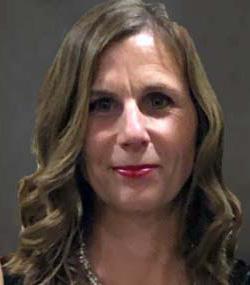





































































































































































































 Brian Tuohey
Brian Tuohey







Wholesale-distribution companies face unique challenges that require efficient and effective management strategies to thrive. These organizations must navigate complex supply chains, handle diverse product portfolios, and satisfy the ever-changing demands of customers. In such a dynamic environment, project management emerges as a critical discipline that enables wholesale-distribution businesses to stay competitive, drive growth, and maximize operational excellence.
This chapter delves into the realm of project management specifically tailored for the wholesale-distribution industry. It explores the fundamental principles, methodologies, and best practices that underpin successful project execution in this context. Project management serves as the compass that guides organizations through the complexities of undertaking strategic initiatives, such as market expansion, process improvement, and digital transformation. By applying structured project management methodologies, wholesale-distribution companies can effectively plan, execute, and control projects, ensuring they are delivered on time, within budget, and with the desired outcomes.
Effective project management enables companies to respond swiftly to market changes, capitalize on emerging opportunities, and navigate industry disruptions. It fosters collaboration among diverse stakeholders, aligns business goals, and enhances cross-functional coordination. Furthermore, project management brings clarity, transparency, and accountability to complex initiatives, mitigating risks and improving decision-making.
Whether you are a wholesale-distribution professional seeking to enhance your project management skills or an executive looking to optimize your organization’s project execution capabilities, this chapter will equip you with the knowledge and tools necessary to succeed. By embracing
project management as a strategic discipline, wholesale-distribution companies can effectively navigate the challenges of an ever-evolving business landscape and seize opportunities to achieve sustainable growth and a competitive advantage.
As an emerging leader in a wholesale-distribution business, you likely face with complex challenges that require effective project management and process improvement skills. These skills are essential to achieve the goals of your organization and can help increase profitability, enhance customer satisfaction, and drive organizational growth.






The role and responsibilities of a Project Manager are as vast as the industries that assemble our economic system. Whether you are a catering director, app developer or sell industrial valves, a Project Manager is essentially the leader and most important person on a project and is responsible for overseeing the success of that project from start to finish.
Responsibilities of a Project Manager:
















































































































































• Project Managers are the liaison between the customer and the company. They are responsible and held accountable, for all aspects of the project running efficiently and effectively, while staying on time and on budget.
• Project Managers must be effective communicators, both written and verbally. They are responsible for communicating all developments to the customer and in return their team.
• Project Managers defines the roles and responsibilities of the members of the project team and ensure that all members are held accountable for their section
• Project Managers define and lead the project planning activities.
• At the end of the project, the Project Managers assess the strengths and weaknesses that occurred during the project, while sharing tips on how to improve the process.
Many people do not think twice when they turn a light switch on once they enter a room, but at some point, a power plant that generates electricity had to be built. Many of our distributor partners are an integral part of making that happen. Project work can be lucrative, complex, and price sensitive. Pairing up with the correct vendors can make or break the success of a construction project. Our customers ask us frequently why they should not just order their industrial valves directly from the manufacturer. They believe that going direct will result in a better price without having to incur the middle-man’s charge. Speaking from the “middle-man’s” perspective, this is not the case. Distributors can offer competitive pricing, but also overall cost savings that affect a project.
Project Management is why both our engineer/end-user customers and our vendor partners come to us, the distributor, for these elaborate projects. Our clients’ project teams count on us to manage the flow of information. With our knowledge and experience with various manufacturers, we offer solutions to meet the construction demands. We strive to provide the best value without sacrificing schedule, quality, or price.
Our company is very fortunate to be a key supplier to the largest Engineering, Procurement, and Construction (EPC) company in the world and we have partnered with them on some of the largest worldwide PVF projects during the past 30 years. We developed and fostered very lucrative relationship was developed and fostered totally through the expertise and talent of one of our project management teams. This EPC company trusted our team so much that it asked our team to review and rewrite their valve specifications for its new power plant builds.



















































































































































































A distributor represents multiple manufacturers and has become an expert in recommending the best technology for the application. Why use Stainless Steel when Carbon Steel will meet code requirements? A good distributor is there to represent the best interests of the end-user.




Many distributors also have their own degreed engineers on staff to help select, size, and automate the valve before it shows up on site. We all know that there are unforeseeable slip-ups that happen on a project. A distributor’s staff engineer could find a quick alternative to a problem, that would minimize downtime on the job. Imagine a positioner or actuator already installed on your control valve when it shows up to the site. It allows for ease of installation to the plant and allows your contractor to move along to the next challenge of the building process.

When you specify the correct or best alternative for the application, the owner can reap considerable savings. The distributor also fosters a long-term relationship with the manufacturer and buys more valves in a year than most large EPCs or contractors can do for one project. Why wouldn’t the distributor’s multiplier be just as competitive as what a manufacturer would sell it for directly to the end-user? Actually, for the most part, the manufacturer is thankful to have a distributor deal with the paperwork and logistics, as those requirements are not a “core competency” for the manufacturer.








A project manager would be responsible for the entirety of the project (see steps below), which is incredibly elaborate, and our end-user customers are paying us to manage that for them. Why deal with six valve manufacturers when you can deal with one distributor?













































































































































In this section, we will explain a typical project cycle that a distributor in the industrial pipe division may experience.














The journey begins with your business development manager establishing a relationship with the EPC (Engineering, Procurement & Construction) companies and tracking the projects that are available. This process is known as a long sales cycle, where some projects are tracked for multiple years, change scope, and sometimes do not pass local or environmental approval. However, once a job has come to fruition a bid package will be emailed out.
The Project Manager must make sure to review the AML (Approved Manufacturer’s List) and determine that the vendors represented are on that list. It is very exciting to see how large these jobs can be; however, to be realistic, management will need to choose packages where the organization can be competitive, because the bidding procedure can be lengthy and highly time consuming.










































































































































































One of the most pivotal changes that we have made to our company, happened 25 years ago when we hired our first mechanical engineer. This was a suggestion from a very large customer, who was downsizing its engineering department and asking or ordering us to increase our level of expertise in this area, as it would now be depending on us to deliver these services. That initial engineering hire (25 years ago) has now grown to a full department staffed with eight degreed engineers and has been the catalyst for our company to be widely recognized as technical specialists and problem solvers for our industry.
If your organization has an engineering team, the project manager will want to consult with them on the best valves for the application and whether additional engineering may be required if the bid is won. Your engineering department will know how much extra time or service may be needed if the project is won, so factor that cost into the bid.
With these large projects come complex bid packages. The documents need to be reviewed and questioned for optimal understanding. Look for better ways or more cost-effective alternatives. It is important to ask clarifying questions since our customers count on us to catch any mistakes or deletions that need to be fixed.
Along with price and lead time, the project manager will need to submit drawings or cut sheets for each product specified in the bid and any technical exceptions for review.




















It is the Project Managers responsibility to read and review this lengthy document that will describe myriad other legally binding details, which can include but are not limited to delivery dates, technical submittals, and additional shipping paperwork. The most important part is to understand what may happen if you fail to deliver on time. This happens, especially when you are relying on a separate company (your vendor) to custom manufacture and deliver on-time and to specification.

One of the most costly conditions is known as Liquidated Damages (LDs). Since construction crews can become sidelined if the building material does not arrive on time, the EPC wants to be able to recoup the monies paid to employees that show up to work but don’t have material due to your company’s shortfall or lost monies for a missed system completion milestone with the end user. These LDs can cost your company tens of thousands of dollars, so negotiate when LDs would take effect or if they would only be applied if the EPC experiences a hardship due to a breach of contract.















































































Details matter! The PM should review each line of the Purchase Order and discuss with the customer any discrepancies found between the PO and quote. This includes quantities and lead times for both submittals, as well as lead times after approvals.



The Project Manager should ensure that they know what will be required of the company based on the purchase order and contract signed. A detailed list and procedure should be put in place to ensure that submittals are not missed. Drawings may need to be submitted for specific valves or instrumentation to the engineering department for compliance.



































































Based on the previously mentioned steps, deletions and additions should appear on a change order. A customer acknowledgement should also be emailed to the customer and a signed acceptance should be sent back. This is imperative so that your company does not get stuck with extra products or the incorrect products. Change orders will happen as a project develops and the contractor begins the layout. It is important that any changes are swiftly communicated to the manufacturer to avoid delays and that the customer understands what they are responsible for when changes are made.
Entering the sales order into your ERP will be a massive task. Multiple sets of eyes should review and confirm all the details.
Simply put, once the purchase order for your vendors is placed, the process begins. This would be a good time to start thinking about what type of system you will have in place once the material is received. Shared spreadsheets or custom software where multiple people in a variety of locations can access the data are most useful. Establishing this procedure ahead of time is key.
• Who and how will it be received?

• How will you know what has been received and when?
• If it must be sent to a fabricator before it comes back to you, how will you keep track of this?













As you receive products in, especially valves and actuators, depending on your commitments, these may need to be assembled by a valve specialist. This process takes time and experience. The PM can help by ensuring that all components of the package have been received and that specialists and space will be available to complete this task. Some projects can have hundreds of assemblies that need to be completed by a specific deadline.
Clear communication with the entire team is imperative to the success of your project. The warehouse staff can arguably be your most important asset on this team. Their organization, ability to properly receive material, tag necessary valves, order and pack crates, complete the necessary export documentation for overseas shipments, and the list goes on. Staying close to the warehouse staff and offering any organizational help that may be needed is the Project Manager’s responsibility.















































































































































































Everything has been shipped, and you’re breathing a sigh of relief; however, your job is not done. This is when you need to go back over your list and make sure all drawings or cut sheets were received along with any warranty programs the manufacturer offers. This is also when the Project Manager should meet with sales and accounting to ensure that all invoices were sent and are correct. You might need to send invoices with legal waivers, depending on the EPC’s requirements.













Never settle for the phrase “this is how we’ve always done it.” Seek to fine-tune your process every day.
Now that you know what Project Management is and how your skills would best fit the role, the question remains: what tools or skills do you need to be an effective manager?
Organizational skills are the most important skills to have. Some companies have dedicated Project Management software to help breakdown the project into chunks, assign those chunks, and communicate amongst each other. However, here are some other tools that are very useful:

• If you have a CRM accessible to all team members, use it. Here you can share documents, notes, conversations with the customer and task lists.
• Slack has a free team chat option, where conversations can be stored.















































































































• Learn and become efficient in Excel. Many engineering companies in our industry use massive Excel documents to share information about the details of a valve, including brand, material specifications, tag numbers, where to ship the valve, and operating conditions. The basic level is understanding how to filter data; however if you can link tables, create pivot tables, etc, then it helps to have a document.
• Find a system that works for your company while also conforming to the requirements set forth by the customer.
The first and most important skill is to understand that problems or mishaps will always happen, but you need to identify the problem early on, and swiftly develop a solution to combat it before the problem builds. Ignoring a situation and hoping it sorts itself out is not proper project management. Make sure to communicate that same message to avoid apprehension amongst your team.
We had a project several years ago where our customer had a $500,000 a day late delivery penalty fee (which would have been passed along to our company). Our specialty valve manufacturer in Italy was suddenly taken over by its bank and closed down - pretty alarming! Our solution was to send our lead project manager over to Italy with our customer’s project manager. They bought the valve drawings and molds that we needed to supply at a bankruptcy auction and then found a European company to pour and machine the castings. Then they found another company to actually build the valves for us. Crisis averted, no penalties assessed, and the two project managers got a three month all-expenses-paid vacation in Europe. Necessity is the mother of invention!






Communicate often, but do not micromanage. Create your team, delegate the task at hand and trust and verify what needs to be done. Hold a kick-off meeting to ensure all of the project team members understand their responsibilitie’s understand the timelines, and adhere to commitments that have been made to the customer. One on one informal check-ins are very useful, but avoid having meetings, just for the sake of meeting since this slows down progress.

































Project management is a dynamic field with multiple approaches, and selecting the right strategy depends on various factors. Recognizing that different projects have unique requirements and constraints, project managers must consider factors such as project size, complexity, team composition, industry norms, and organizational culture. It is essential to assess the project’s objectives, stakeholder expectations, and the team’s capabilities when choosing a project management approach.
Additionally, understanding the project’s scope, timeline, and resource availability is crucial. By carefully evaluating these elements and consulting with stakeholders, project managers can determine the most suitable project management strategy that aligns with the project’s specific needs, optimizing the chances of successful execution and achieving desired outcomes. Flexibility and adaptability in selecting and tailoring project management methodologies are key to effectively managing a wide range of projects
• Waterfall Methodology: The waterfall approach follows a linear, sequential project management model. It involves dividing the project into distinct phases, such as initiation, planning, execution, monitoring, and closure. The key characteristic of this strategy is that each phase must be completed before moving on to the next. Resources to learn more about the waterfall methodology include:



Book: “A Guide to the Project Management Body of Knowledge (PMBOK Guide)” by Project Management Institute (PMI).
Online Resource: “Everything You Need to Know About Waterfall Project Management” by Asana.



















































































• Agile Methodology: Agile is an iterative and collaborative project management approach that focuses on flexibility and adaptability. It emphasizes continuous improvement, frequent feedback, and delivering value in short iterations called sprints. Agile methodologies, such as Scrum and Kanban, are widely used in software development but can be applied to various industries. Resources to learn more about agile methodologies include:
Book: “Agile Project Management with Scrum” by Ken Schwaber.
Online Resource: “Scrum Guide” by Scrum.org.




































































































• Lean Methodology: Lean project management aims to eliminate waste and maximize value by applying lean principles and practices. It focuses on identifying and eliminating non-value-added activities while streamlining processes. continuous improvement, and value delivery.


Book: “The Lean Startup: How Today’s Entrepreneurs Use Continuous Innovation to Create Radically Successful Businesses” by Eric Ries.
Online Resource: “Lean Project Management: Principles and Techniques” by the Association for Project Management (APM).








• Critical Chain Project Management (CCPM): CCPM is a project management strategy that aims to optimize resource utilization and improve project schedule performance. It involves identifying and managing project dependencies, focusing on the critical chain of tasks, and protecting project buffers. CCPM is particularly useful for projects with limited resources or aggressive timelines. Resources to learn more about CCPM include:
Book: “Critical Chain” by Eliyahu M. Goldratt.
Online Resource: “Critical Chain Project Management” by Project Management Institute (PMI).







































































































































• PRINCE2 (Projects in Controlled Environments): PRINCE2 is a structured project management methodology widely used in the United Kingdom and internationally. It provides a comprehensive framework for managing projects, including well-defined processes, roles, and responsibilities. PRINCE2 focuses on business justification, controlled stages, and project governance. Resources to learn more about PRINCE2 include:

Book: “Managing Successful Projects with PRINCE2” by Axelos.
Online Resource: “PRINCE2 Official Website” by Axelos.




Project management plays a pivotal role in the success of wholesale-distribution companies by enabling them to effectively execute strategic initiatives, drive growth, and overcome industry challenges. Wholesale-distribution professionals can leverage the knowledge gained from this chapter to enhance their project management skills and successfully lead projects within their organizations. Executives and managers can utilize the insights provided to optimize their project execution capabilities, aligning projects with business goals and driving operational excellence.
As the wholesale-distribution landscape continues to evolve, project management will remain a critical discipline for companies seeking to stay competitive and achieve sustainable growth. By embracing project management as a strategic function, wholesale-distribution organizations can adapt to market changes, capitalize on emerging opportunities, and navigate industry disruptions effectively.

The integration of project management principles and methodologies into the wholesale-distribution sector is not only essential but also transformative. By emphasizing the importance of project management throughout the organization, wholesale-distribution companies can foster a culture of efficiency, innovation, and collaboration, setting the stage for long-term success in a rapidly changing business environment.








The Collins Companies is an industrial distributor of pipe, valves, and engineered products, headquartered in Connecticut with nine locations scattered throughout New England and New York.




















Toni Wall collaborates with her fellow staff and engineers to create compelling content to educate their customers on industry best practices. Similarly to many small companies, Toni wears many hats at Collins, from leading the marketing department to training and recruiting to and spearheading new initiatives. With her well-rounded experience, Toni brings enthusiasm, expertise, and critical thinking skills that result in improved business functions and processes across the organization.
Brian Tuohey, is an industry veteran and has been involved with ASA leadership for many years. Serving as ASA President in 2018, Brian’s strategic thinking and vision has shaped many ASA programs as they exist today. He continues to be involved with ASA’s volunteer leadership, including the MDM Task Group. He said, “I joined this industry 40 years ago as a bonafide rookie and it was the first time in my life that I “said yes” to an unknown challenge. But, I will also tell you that it was the BEST decision that I have ever made. Since then, I have “said yes” to every opportunity that this business has presented to me and I have been rewarded with the greatest group of friends/mentors and life experiences that any man could ever hope for.”

















































































































































































1. What are the key challenges faced by wholesale-distribution companies in managing projects and improving processes? How can project management address these challenges?
2. How can effective project management contribute to the growth and success of wholesale-distribution businesses in a dynamic and competitive market?
3. In what ways can project management foster collaboration among stakeholders and enhance cross-functional coordination in a wholesale-distribution context?
4. What are the benefits of applying structured project management methodologies, such as planning, execution, and control, in wholesale-distribution companies? How can these methodologies ensure project success?
5. How does project management enable wholesale-distribution companies to respond swiftly to market changes, capitalize on emerging opportunities, and navigate industry disruptions? Provide examples to support your answer.






• “The Project Management Podcast”, hosted by: Cornelius Fichtner






















































































































• Project Management Institute (PMI) - www.pmi.org - PMI is a globally recognized organization for project management professionals.





• “Project Management for Business Professionals: A Comprehensive Guide” by Joan Knutson.

• “Supply Chain Project Management: A Structured Collaborative and Measurable Approach” by James B. Ayers.



















• “Project Management for Small Business: A Streamlined Approach from Planning to Completion” by Joseph Phillips.


















 Norm Clark, Ph .D . Associate Instructional Professor Industrial Distribution Program, Texas A&M University
Norm Clark, Ph .D . Associate Instructional Professor Industrial Distribution Program, Texas A&M University

In today’s fast-paced and interconnected world, effective communication has become the lifeblood of any successful organization. From the boardroom to the show floor, the ability to transmit ideas, share knowledge, and collaborate across departments has become paramount.
However, despite the advancements in technology and the emphasis on teamwork, many organizations still struggle to bridge the communication divide that hinders productivity and stifles innovation.
The absence of effective communication within an organization can have profound repercussions. Misunderstandings and misinterpretations can proliferate, leading to conflicts, delays, and costly mistakes. Without clear and concise communication channels, vital information can get lost in the shuffle, resulting in decreased efficiency, and missed opportunities.




In this pivotal chapter, delve into the art and science of communicating across the organization, exploring strategies, tools, and best practices that will empower you to break down silos, foster meaningful connections, and create a culture of open dialogue and collaboration. You’ll also explore the consequences of poor communication and provide valuable insights on how to overcome these challenges.


























































































































To emphasize the significance of this topic, we’ll start by bringing transparency to the startling realities of the importance of communication. In a 2013 Harris Interactive Poll Survey, 23,000 U.S. residents who were employed full-time within key industries responded (Covey, 2013).


Here are the findings:






















































• 37% had a clear understanding of what their organization was trying to achieve and why.
• One in five was enthusiastic about their team’s and organization’s goals.




• One in five had a clear “line of sight” between their tasks and their team’s and organization’s goals.
• 15% felt their organization fully enabled them to execute key goals



• 20% fully trusted the organization they worked for.




This indicates a serious communication issue throughout the organizations.





























































































































Understanding the four basic principles of communication can help you understand how to enhance your company’s communication team. Explore some ways to apply these principles to create a culture of trust and empowerment towards a collective competitive advantage.














Over the past twenty-five years, as I’ve seen students come and go in my role as a professor at Texas A&M University, I have discovered four basic principles of communication that standout as the cornerstones of effective communication.
In my undergraduate Sales Engineering class, I teach my students these four basic principles. They apply not only to sales but also to effective communication in all aspects of our lives.
When you approach someone with an idea you need to realize that you are probably intruding on their time. To be able to effectively communicate your message, you must first get their mind off what it’s currently occupied with and instead get it focused on you. Give them a reason to listen. You may have heard the phrase, “what’s in it for me?” (WIIFM). To get our your message across, you need to pre-empt this question and be ready to turn the attention back to your own messaging. You need to pique their curiosity to hear your message. This is the focus of people who sell advertising. Think of a time you saw a television ad that piqued your curiosity to the extent that you stopped doing what you were doing and totally focused your attention on the ad to see what was being sold and by whom. Maybe it elicited an emotional reaction. Maybe it’s a product that you think you might like. Regardless, something pulled you to this message.



Piquing curiosity happens when you begin conversations with benefit statements. Benefit statements are designed to catch someone’s attention to the extent that they think (or possibly respond): “How would you do that?” Here are a couple of examples:

• We may be able to reduce the number of vendors you are having to deal with due to supply chain issues.
• It’s possible we can help you improve the efficiency of this process and reduce your labor costs.
Benefit statements need to be concise. If they are too wordy, people may get lost in the rhetoric, or miss the “How would you do that?”. Avoid talking over the head of your listener, and consider how jargon, acronyms, or informal language may distract or derail the listener.
Here is a comparison using the first example above:


















































































• Wordy: Logistical issues resulting from global supply chain issues have extended lead times causing uncertainty in scheduling which has caused many distributors to have to depend on too many vendors to get the products they need.
• Concise: We may be able to reduce the number of vendors you are having to deal with due to supply chain issues.
























































































































In his book “Five Dysfunctions of a Team,” Patrick Lencioni writes that conflict is necessary within an organization to get commitment from team members. If the team leader is putting forth an initiative and some members of the team do not think that the initiative will work or feel they will be disadvantaged by it, the chances of these folks buying into the initiative are slim to none.
However, if the team leader is willing to listen to the concerns of the team members, address the concerns, and offer assurances, the likelihood of the team buying-in is much greater. Even though some may still not be fully convinced the initiative will work, the fact that the leader listened to them and addressed their concerns makes them much more accepting of the initiative. Using a benefit statement that includes “What’s in it for the team members” during the introduction of a new initiative will enhance the chances of the team being more receptive to the message.
You need to learn to think like a doctor and diagnose before you prescribe. How many times do you see people offer solutions before they fully understand the problem? You have likely experienced run-ins with those individuals who talk over others in their hurry to explain how they’ve found the solution to your problem.

By asking questions and listening to the answers, you can get the other person emotionally involved in the conversation. The emotional tie-in means they care about the outcome of the conversation and are invested.

To fully understand an issue and the importance of that issue to the other person, you need to ask questions for clarification. Here are some examples:
• Help me understand what’s going on with _____________?














































































































• How is this impacting the overall operation?
























• How is this impacting you personally?
• How can I help?

As you show a genuine interest in how the issue is impacting the other person and demonstrate that you are trying to better understand the issue before offering a solution, the other person is more likely to perceive you as a resource and seek you advice.
Listening to the answers is as important, sometimes more important, than asking the right questions. Consider these three levels of listening.
Marginal Listening—This is pretend listening. Think of a time you were at a social event having a conversation with someone and you could tell they were so preoccupied with looking around the room to see who was there that they were pretending to listen to you. This is easy to detect. Most of the time, you can tell when someone is not listening to us by their lack of interest and eye contact. Have you ever had someone come in and start talking to you when you were watching a game on TV and your favorite team was about to score? You were likely engaged in marginal listening.
Evaluative Listening—This is when you ask someone a question, and when he or she begins to answer, you think, “Oh yeah, I know where you are going with that,” and you stop actively listening. Sometimes we even finish the sentence. This is the trap into which most people fall. I can remember
several times when I responded to someone’s question, and later during the conversation I realized I misunderstood the question. I answered the wrong question because I assumed I knew what the question was, and I quit actively listening to what the person was saying and began formulating my answer. Listening is not waiting for our turn to talk .
Active Listening—This is the level of listening to which we should all aspire. This is being fully attentive and listening with empathy, where you see the situation form the other person’s point of view. This is hearing not only what the person says but also what the person is saying. This is much like reading between the lines. My wife and I were on the freeway, returning home after having dinner one evening. As we approached the exit to the mall, she asked me, “Would you like to stop by the mall for a few minutes?” My response was, “No, not really.”
As we passed the exit to the mall, she said, “I can’t believe you wouldn’t take me to the mall!” I remember actively thinking, “Oh, I get it! She was asking me to take her to the mall. I thought she was asking me if I wanted to go to the mall.” I heard what she said, not what she was “saying.”
Author Stephen Covey said it very well, “Seek first to understand, then to be understood.”
Industry conversations can often become very technical. You must consider other people’s level of expertise concerning a subject to avoid talking over their heads. You cannot that assume because you tell anyone something, they will understand how they will benefit from what you tell them.
Imagine the perception of these two phrases:












































































































































































• “We’re going to go to a flex schedule.”
• “We’re going to offer employees their choice of start time and end time each day they work.”















In the first statement, there’s no context. What is a “flex schedule”? What does that mean for the listener? Will this mean extra hours on the job, or is this a cut in hours? Much like the emotional responses you tell mentioned previously, this can already get your communication off to a shaky start. Don’t leave room for nebulous interpretation; instead clearly spell out why they should care about what you are telling them.
















The second statement, while not including every single detail, gives the listener context and begins to relate it back to how it will impact or benefit them. While there may still be questions such as, “does it have to be the same start and end time each week?”, it at least tells the listener that this will have an impact, and what that impact might be.

As in this example, it is critical that when communicating your ideas to others, you Include their benefits . Some phrases you can use to begin these benefits are:
• The benefit to you is . . .
• This assures you . . .
































• What this means to you is . . .
Including the benefit is no guarantee that the other person will perceive or buy-in to the benefit. There will be times when you must provide assurance and additional information. The fact that you have suggested a benefit provides you with an opportunity to ask questions for clarification and address your concerns.























Have you noticed how very good communicators ask questions for confirmation? Examples are:
• How does that sound?








































































• Does this make sense?







• Will that work for you?
• Is that what you’re looking for?
Communication involves a sender and a receiver. For effective communication to happen, it is the sender’s responsibility to ensure that the intended message is received. You can do this by asking confirmation questions.
Think about who controls the direction or flow of a conversation. Is it the person who asks the questions or the person who provides the answers? Even though the person providing the answers to the questions may be doing most of the talking, the person asking the questions is controlling what is being talked about.


Prior to my academic years, I spent time as a consultant designing sales training programs. At the conclusion of conversations where I was gathering information for the design of a training program, I had people comment, “Have we been here for an hour and a half?” They seemed surprised at how much time had passed.














By asking relevant questions and actively listening to the answers, I found that people get so engaged in the conversation that they lose track of time. When you ask questions about things people have not previously considered, you establish credibility much more quickly than when you try to impress people with how smart you are.
Make sense? Excellent communicators can control conversations while being perceived as excellent listeners. These principles can be used effectively in all aspects of communication, across all levels within an organization.
When communicating across organizational levels it is important to remember that people at different levels have different things that they care about .
Executive Level—At the top of an organization people care about the strategic direction in which the company is moving. The decisions they make will impact their organizations three to five years down the road.
Here’s what an executive-level message might look like:


“As an executive team, the new Customer Relationship Management (CRM) system will help us to identify trends in customer buying behavior and service requirements so that we can better allocate our resources to sustain a competitive advantage in the marketplace.”
Middle Management Level—Those at this level care about implementation, processes and results. The decisions they make improve the efficiency and profitability of their operations with a focus on an exceptional customer experience.
This message might be:






































































































































































































“As profit center managers, the new Customer Relationship Management (CRM) system will help you better direct the activities of your sales and service organizations to identify additional profitable business opportunities and provide value-added services meaningful to our customers.”
Operations and Purchasing—These people are the ones doing the work. They care about finding the most effective and expedient means of accomplishing their tasks. Once they get things figured out, they are resistant to change.
This statement might sound like:
“For those of you on our operations and purchasing team, the new Customer Relationship Management (CRM) system will allow us, based on your input, to improve the efficiencies of our processes you use to provide excellent customer experiences and make your jobs less stressful.”
It is important that everyone in the organization understands these different frames of reference and unique concerns . This is a critical consideration when communicating a new initiative through the organization for two reasons:
• To be sure everyone involved will know how they will be impacted.
• To get buy-in for the initiative throughout the organization.
When you are having conversations with people at various levels of the organization, it is easy to see the necessity of asking clarifying questions to better understand a person’s position and concerns prior to delivering information or providing solutions. Confirmation questions are also important to ensure you communicate the intended message.





Improved communication across an organization can create a culture of trust. For this to happen, the initiative needs to have a champion or Architect of Trust (The A&R Brown Business Group). The person who takes responsibility for building trust throughout an organization should be able to demonstrate these traits:






































• Authenticity: Find a consistent voice, be genuine, be approachable, be willing to share information, and be willing to listen.
• Emotional Intelligence: See the human side of things and be able to hone in on his or her own emotions and those of others.
• Climate Building: Create an environment in which people can comfortably bring forth their own ideas, without killing candor.

















• Walk the Talk: Actions speak louder than words, so he or she should be consistent with what they are asking others to do.
By doing these things, you develop an organization comprised of employees who:



• Trust their management team.
• Are willing to speak up and challenge processes to improve the way things are done.
• Bring commitment, energy, and innovation to their work.



These are the things that create a competitive advantage .








































































































































































































As you create a culture of trust, you must learn to empower your employees to do the jobs we are you ask them to do. Author Lee J. Colan states, “A leader’s power alone yields no results until it is exchanged with his team.” Colan explains that leaders empower others by giving up some power. In return, they get commitment and productivity.
The most impactful source of power that can be given up or shared by a leader is information . Leaders find that by sharing information, they create a much more open and transparent relationship in which information begins to flow both ways. As people begin to trust each other and communicate more candidly and effectively, it is easier for everyone to consider themselves part of the same team. People begin working together toward the same goals and looking out for each other.
It is obvious from the findings of the survey referenced at the beginning of this chapter that there is a huge issue with communication across organizations. To change anything, becoming fully aware of the situation is the first step. You need to know about something before you can fix it. Then, you identify a champion to take on the responsibility of fixing or improving the issue. It helps if the champion can create a culture of trust in which employees feel comfortable speaking up to challenge processes for the purpose improving the way things are done. In this type culture employees bring commitment, energy, and motivation to their work.
The champion must assess the situation to identify areas in which communication is breaking down and then develop an educational process to help members of the organization understand the key principles of effective communication and how they can be used effectively. Program implementation should be done in a way to get the buy-in and commitment of key players first to ensure there is support for the initiative throughout the organization.


Considering the referenced survey, companies do not have to be perfect. They just need to be aware of the communication issues and develop and implement a plan that will make them better than most to achieve a competitive advantage .











































































Norm Clark joined the Industrial Distribution Program at Texas A&M University in the fall of 2001. He has a BBA in Accounting, an MBA in Management, and a Ph.D. in Educational Human Resource Development.
Since joining the Industrial Distribution Program, he has taught courses in Sales Engineering, Purchasing Applications in Distribution, Manufacturer-Distributor Relationships, and Leading People and Managing Performance.
As an associate of the Thomas and Joan Read Center for Distribution Research and Education at Texas A&M, he is responsible for developing and delivering professional development programs to distributors and manufacturers globally.
As co-founder of the Talent Development Council at Texas A&M, Norm works with industry partners to identify best practices that focus on talent planning, acquisition, management, development, and retention.
Norm’s use of interactive teaching methods and his ability to encourage discussion in classroom situations help to create memorable learning experiences in both industry and academia.




















































































































































1. How does effective communication contribute to the success of an organization? Discuss the consequences of poor communication in terms of conflicts, delays, and missed opportunities.
2. According to the principles outlined in the chapter, why is it important to provide a reason for others to listen before conveying your message? Share examples of benefit statements that can pique curiosity and engage listeners.
3. How can active listening and asking questions for clarification help establish a connection with the other person during a conversation? Discuss the levels of listening and the significance of understanding before providing solutions.
4. Explain the importance of including the benefit to the listener when communicating ideas. Provide examples of phrases or statements that help relate the information to their concerns or interests.
5. Discuss the considerations that need to be taken into account when communicating across different levels within an organization (executive level, middle management level, operations, and purchasing). How can understanding their perspectives and concerns improve communication and facilitate buy-in for initiatives?


6. How can improved communication across an organization contribute to creating a culture of trust? Discuss the traits of an “Architect of Trust” and the actions they can take to foster trust, openness, and innovation within the organization.
7. Explain the concept of empowerment in communication. How can leaders empower their employees by sharing information? Discuss the benefits of information flow, trust, and collaboration within a team.
8. Based on the principles and insights shared in the chapter, what steps would you recommend an organization take to improve communication across departments and levels? Share your suggestions for developing and implementing a communication improvement plan.

























































































































• Architects of Trust: Building Trust in the Workplace. A&R Brown Business Group. Slideplayer. com/slide/2301162



















• Colan, Lee J. (2005). PowerExchange. Cornerstone Leadership Group.























• Covey, Stephen R. (2013). “The 8th Habit: From Effectiveness to Greatness.” Simon and Schuster.



































• Covey, Stephen R. (2020). “The 7 Habits of Highly Effective People.” Simon & Schuster.


• Lencioni, P. M. (2012). “The Five Dysfunctions of a Team: Team Assessment.” John Wiley & Sons.


• Richardson, Michelle and Sharer, Russ, (2022). “Agile & Resilient: Sales Leadership for the New Normal.” The Brooks Group.
























































































































































 Program, Texas A&M University
Program, Texas A&M University

































































































































































Diversity— Who do you Employ? People of various genders, races, physical abilities, religions, ages, and socioeconomic status, and other characteristics.



















Equity—How are they treated? Use fairness, access, opportunity, advancement, and participation.
Inclusion—How do they feel? They sould feel safe, welcomed, valued, respected, accepted, and encouraged. Their ideas, voices, and opinions all matter.
Belonging—How do you create a culture? Employees are welcome as they are, can be themselves, and are celebrated.
In today’s rapidly evolving global marketplace, the wholesale distribution industry finds itself at a pivotal crossroads. Amidst the constant waves of technological advancements, changing consumer preferences, and increasingly diverse markets, one critical factor stands out as a key driver of success and sustainable growth: Diversity, Equity, Inclusion, and Belonging (DEIB).
As we embark on this transformative journey, it becomes evident that DEIB is not merely a buzzword or a fleeting trend, but a profound paradigm shift that touches the very core of wholesale distribution. This chapter aims to shed light on the multifaceted facets of DEIB and its undeniable significance in shaping the future of this vital industry.
























Embracing DEIB goes far beyond meeting quotas or fulfilling regulatory requirements; it encapsulates a fundamental shift in organizational culture, values, and practices. By fostering an environment that values diverse perspectives, nurtures equitable opportunities, promotes inclusion, and fosters a sense of belonging for all, wholesale distributors can harness the full potential of their workforce and stay attuned to the dynamic needs of their diverse customer base.
In this chapter, you will explore the multifaceted dimensions of DEIB and its practical implications. From understanding the strategic advantages of diversity to dismantling systemic barriers that hinder equitable progress, you will delve into the key components that underpin a successful DEIB framework. Drawing from real-world case studies and industry best practices, you this chapter will equip wholesale distribution leaders with the tools and insights necessary to cultivate a culture that empowers every individual, irrespective of their background, to thrive and contribute to the organization’s collective success.
You will also read about and discuss the role of leadership in championing DEIB initiatives, guiding organizations toward genuine cultural transformation and making DEIB a central tenet of their business strategies.
In a world where customers seek to align with brands that mirror their values and support their aspirations, wholesale distributors must recognize that DEIB is not just a moral imperative but a strategic necessity. Organizations that embrace DEIB as a core driver of their business will unlock a wealth of untapped potential, enabling them to navigate uncertainty with resilience, attract top talent, and build lasting relationships with diverse clientele.

As you embark on this transformative exploration of DEIB in wholesale distribution, rise to the challenge together, seeking not only to adapt to change but to actively shape it. By prioritizing diversity, equity, inclusion, and belonging, wholesale distributors can forge a path toward a more empowered, empathetic, and prosperous future for themselves and the communities they serve.
















































































































































Distributors are facing margin pressure and growth challenges. Technology adoption, supply chain disruptions, and the pandemic have all accelerated the pace of change in the distribution business. Consolidations will continue, the labor market will tighten, and customer demands will increase.





Distributors need to create a competitive advantage to grow and succeed. The speed at which your company can grow depends on its people. Business strategies are just plans on paper. Talent is the secret sauce to your growth. The pandemic and subsequent economic swings have created intense competition for talent . Those who control the talent, control the future . Recruiting, developing, managing, and retaining next-generation talent is crucial for sustained growth.
To attract and retain top talent, distributors should diversify their workforce and attract employees from various backgrounds, perspecives, and life experiences. The ability to work across generations is key to successful knowledge transfer and succession planning. DEIB should be one of the elements of your overall talent strategy. This chapter focuses on how you can systematically create processes, programs, and culture to improve your talent sources, expand your pipeline, recruit
and engage a diverse workforce. Participating in DEIB initiatives with industry associations such as American Supply Association’s Women in Industry special interest division can also help bring awareness, ideas, and examples for your organization to adopt.
Diversity is any dimension used to differentiate groups of people. Diversity can be both visible and invisible. Visible traits include gender, race, ethnicity, and age, while invisible traits include nationality, disability, veteran status, sexual orientation, and religion.



While we think of diversity as people who look different, what matters are people who think differently. Diversity of thought equals innovation and creativity. Being a diverse company is not about establishing initiatives or programs; it is about creating a mindset and culture that understands and adopts the strengths and benefits of a diverse workforce.

Some of the benefits of hiring and retaining a diverse workforce include:






















































































• Diverse employees bring new ideas to your company.
• Diversity brings different voices and different perspectives to the table.
• Different backgrounds and perspectives of employees contribute to innovation, problemsolving, and the thought process.



• Diverse employees can relate to diverse customer groups.













































































































Three key reasons are driving the need for distributor’s workforce to become diverse.
1. The U.S population is becoming diverse. According to the 2020 census, about 42% of the population identify their race as Hispanic, Black, Asian, American Indian, or other races. About 10.2% identify as two or more races. It is important for your workforce to reflect national demographics.
2. Consequently, your customer base has also become more diverse. Millennials and Gen-Z are moving into decision-making roles. The Gen-Z generation is close to a 50% minority race. It is key for you to recruit a diverse group of employees to serve a diverse group of customers.
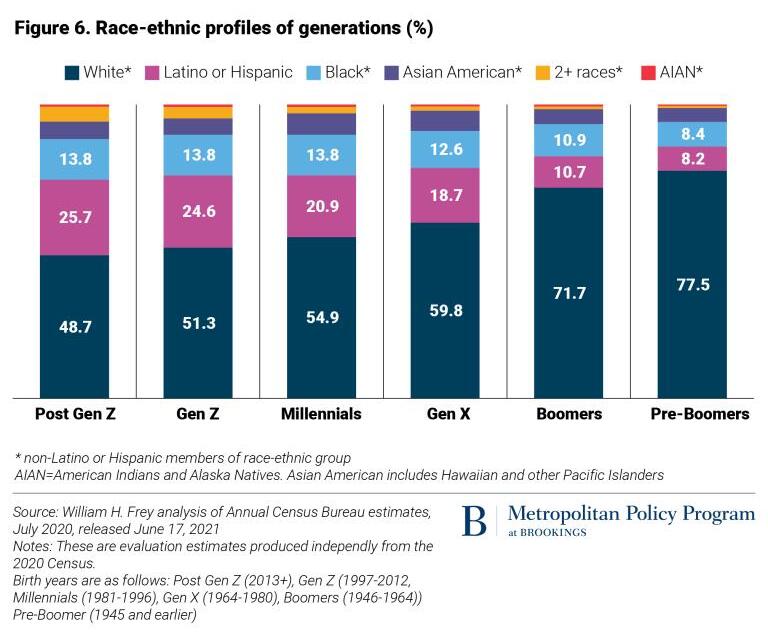
3. In addition to demographic changes, a large percentage of the population has a multicultural background. If you want to be successful in serving them, it is important for your workforce to understand their needs, preferences, and cultural nuances.




In addition, some of your customers expect their suppliers to include DEI and ESG information in their RFPs. Supplier audits, ethics, and business practices are factors in selection and sometimes a requirement for doing business. Corporate social responsibility has become an important cornerstone for sustainable businesses.


























































































































The business case for diversity is stronger than ever. Diversity equals profitability and is good for business. A diverse workforce also sets up the business for long-term sustained growth and stability.
Several studies have shown the impact of a diverse workforce on the bottom line:
• For diverse companies, the likelihood of outperforming industry peers on profitability has increased over time, while the penalties are getting steeper for those lacking diversity.–McKinsey, 2020.
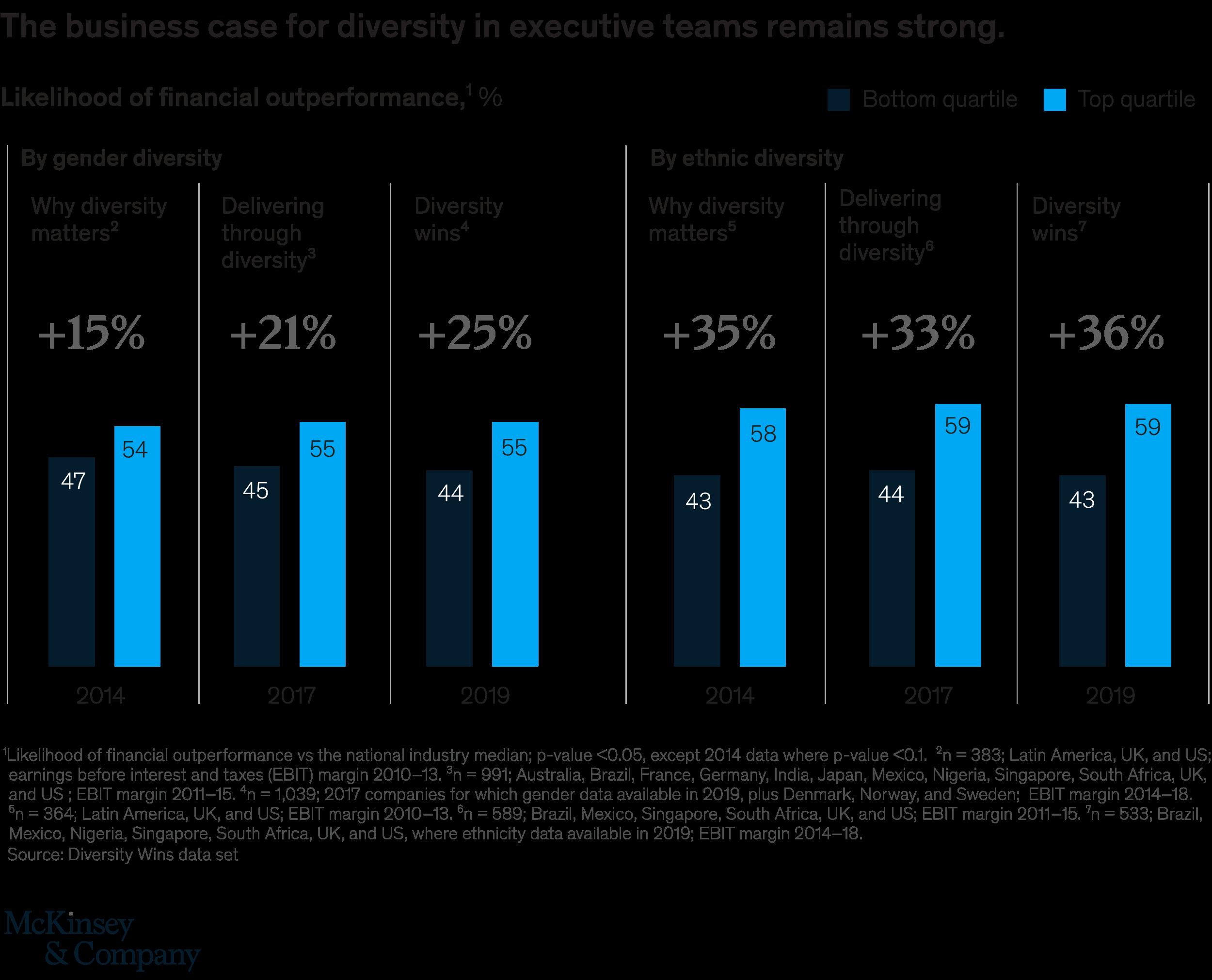
• In an analysis of 1,700 companies, those companies that have more diverse management teams have 19% higher revenue–Boston Consulting Group.

• The McKinsey report also argues that the business case for DE&I as a source of competitive advantage is growing stronger. Increasingly, we find that the most diverse companies see it as a core enabler of growth and value creation.



McKinsey, 2020














































































































































































76% of both active and passive job seekers claim a diverse workforce is an important consideration when evaluating a company or a job offer.
Glassdoor, 2021































































































Next Generation workforce demands companies be more diverse and socially responsible. They look for diversity in the company’s leadership and management. They also look at company websites, recruitment materials, LinkedIn posts, and reviews of Glassdoor and Indeed.
• Hiring for diversity means hiring on merit while ensuring your company’s hiring practices and culture are free from bias and supportive of all people.
• Companies should never prioritize diversity at the expense of skill, experience, or role fit.
• Hiring for diversity and inclusion means looking for employees who will add to your culture, not employees who fit your culture.
• Diversity consists of the visible and invisible traits that make a person unique.

• Diversity brings different voices and different perspectives to the table.
Common Diversity Misconceptions:
• Diversity hiring “lowers the bar.”














































• Diversity initiatives seek to exclude or malign non-minority talent.
• There’s not enough underrepresented talent out there to fill your open roles.
• D&I is not a long game. (Diversity Sourcing 101, Gem, 2020)

One of the common responses to attracting and recruiting a diverse group of applicants, is that there not enough of them. Developing the following recruitment processes and practices can increase your visibility, brand awareness, and qualified applicants. The goal of diversity recruitment is to increase the quantity and quality of applicants—building a bigger and better pipeline.





















































































• Job qualifications: Review and remove non-essential qualifications.
• Educational requirements: Examine if a college degree is needed. By removing degree requirements, you can make the job more accessible to a diverse group of people.
• Word choices: Reduce strong verbs and nouns. Avoid gendered pronouns.
• Translate: Translate job descriptions into a language other than English for some positions.





















































































































• Feedback: Ask diverse people to review and edit your job listing.





• Show your culture and diversity on the career website.
• Mention Equal Opportunity Employer (EOE) applicable.
• Show your commitment to diversity by including DEIB programs and initiatives.
• Include initiatives such as support for veterans or allyship (if you have one).
• Promote your job listings on job boards at Historically Black Colleges and Universities (HBCUs) and Hispanic Serving Institutions (HSIs).
• Attend in-person or virtual career fairs at HCBUs and HSI.
• Advertise in alternative languages in publications and on radio.
• Encourage current employees to refer diverse candidates.
• Use fit scores to rank candidates on skills, competencies, work experiences, prior job titles, proximity to job locations, and more. Using a fit score can help you avoid objective, potentially biased decision-making.
• Invite diverse employees to conduct interviews.
• Develop structured questions to avoid biased questions from managers.

With approximately 200,000 veterans leaving military service annually, you might want to tap into their expertise. They can bring a diverse set of hard and soft skills to the workplace. Many of the military skills are transferable to the business world. In addition to educations and technical skills, veterans bring entrepreneurial and, problem-solving mindsets, resilience, team cohesion, organizational commitment, and cross-cultural experiences.
Many distributors find these skill sets a good fit for operational and managerial roles. Partnering with a Veteran non-profit is a good way to start recruiting. If you are a large organization, attending career fair on military bases for transitioning members would be a good fit.
Veteran Hiring Sources:


















• Veteran Recruiting—https://veteranrecruiting.com/
• Recruit Military—https://recruitmilitary.com/job-seekers
















































































































• Hiring Our Heroes—https://www.hiringourheroes.org/employers/
• Department of Labor Veteran Hiring Resources: https://www.dol.gov/agencies/vets/ employers/hire
• DOL Employer Guide to Hiring Veterans: https://www.dol.gov/sites/dolgov/files/VETS/files/ Employer-Guide-to-Hiring-Veterans2022.pdf




















Workplace equity is provides fair treatment, access, and advancement opportunities to all employees. Equity helps all employees feel valued and helps improve retention. Fair treatment, opportunity, and access to advancement also boosts employee satisfaction, build a better workplace that enhances the employer brand, and improve referrals.
Wage equity is a central element of creating an equitable workplace. ADP defines wage equity as the concept of compensating employees who have similar job functions with comparably equal pay, regardless of their gender, race, ethnicity, or other status.
• The gender gap in pay has remained relatively stable in the United States over the past 15 years. In 2020, women earned 84% of what men earned.—Pew Research
• Compared with Caucasian men with the same education, Black and Latina women with only a bachelor’s degree have the largest wage gap at 65%, and Black women with advanced degrees earn 70% of what white men with advanced degrees earn.— US Department of Labor.
• Wage Equity—Conduct pay analysis based on gender and race. This should be done each year across the company. Some companies also check pay equity when making offers to prevent less-experienced potential employees from being paid more than existing employees. This has become challenging in an era of rapid wage inflation. Wage equity also helps prevent discrimination lawsuits and comply with equal pay regulations.
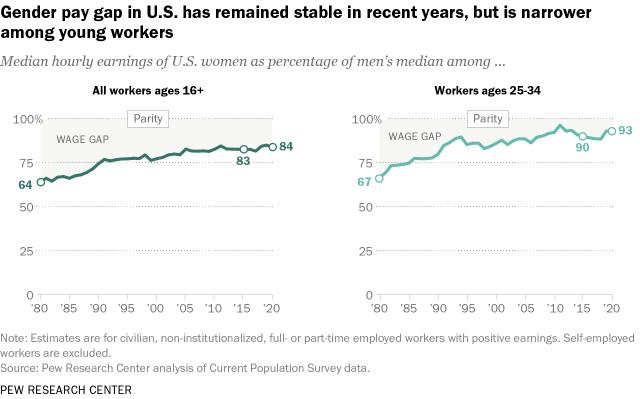




































• Skill-Based Hiring—Emphasize skills and experience over education.




































































































































• Advancement Opportunities—Provide equitable access to all employees to grow and succeed. This includes posting all positions internally and offering interviews for all internal applicants. Having “career discussion” during annual performance evaluations can help set realistic expectations and development plans.















• Benefits—Provide the same benefits to same-sex or non-traditional families.

Diversity is being invited to the party; inclusion is being asked to dance.



















Author and corporate executive Vernã Myers
How employees experience inclusion—or the lack of it—is through equality, openness and belonging.
• Less than 30% of underrepresented groups report feeling a sense of representation or belonging at their respective companies.—(Atlassian).
































• Research involving 3,500 ratings by employees of 450 leaders found that inclusive leaders share six behaviors: visible commitment, humility, awareness of bias, curiosity about others, cultural intelligence, and effective collaboration.—(Harvard Business Review, 2019).



Some of the strategies for creating an inclusive workplace are reducing workplace bias, creating physiological safety, and supporting Employee Resource Groups (ERGs)
























































Bias in the workplace is the purposeful or accidental assumptions made when hiring candidates, delegating tasks or comparing employees in other ways. Bias can be unconscious or conscious. Most of the time, the bias occurs unconsciously. This is due to assumptions about character, skills, or capabilities. Examples of unconscious bias include gender bias, ageism, and confirmation bias (pre-existing beliefs). According to Deloitte, 83% categorize the bias(es) they have experienced and/ or witnessed in the workplace as subtle and indirect, or microaggressions.
Bias influences hiring, promotion, morale, and the overall experience of employees. When employees feel discriminated, against they feel resentful, frustrated, and demoralized. This can lead to them eventually leaving the company.
Unconscious Bias: Unconscious or implicit biases are social stereotypes about certain groups of people that individuals form outside their own conscious awareness. Unconscious bias can be dangerous in the workplace.















Conscious Bias: Conscious bias involves overtly or subtly treating others negatively because of a negative opinion of them or their gender, race, or other factors. The actions are intentional, and the oppressors are aware of their actions.

























• Provide bias training: Bias training can help recognize personal bias and discrimination. It can help improve hiring and development practices.



• Create interview rating scales, use diverse recruitment panels, and set policies that can help create a culture of inclusivity.

Belonging is built on relationships, fairness, respect, and trust. A good place to start is through physiological safety, which includes the following:
• Employees feel comfortable voicing their opinions.
• Employees are open to speaking up without fear of punishment or humiliation.
• Team members feel safe to take risks and discuss failures.
• Managers create a safe space where discussion and it’s okay to be vulnerable.
Four ways you can build physiological safety include:
• Lead by example—Ask for opinions and feedback. Listen. If you are a manager, wait for everyone to express their opinion before sharing yours.
• Create safe environment—Establish a no judgement zone.
• Encourage constructive feedback—Instead of criticism or blame, give encouraging feedback.
• Establish norms—Know how to handle failure, conflict, and new ideas.
Great culture has emerged as one of the requirements for attracting and retaining top talent. Improving physiological safety helps to improve problem solving, innovation, better idea sharing, and decision-making.





































































































































































































ERGs are employee-led and voluntary affinity groups. They are usually based on identity, interest, or experiences (Great Places to Work). Companies typically use the 4C Model career, community, culture, and commerce to segment ERG initiatives. ERGs support learning and development as well as offer a support group for a diverse group of employees. ERGs can create belonging and improve talent retention.

Examples of ERGs include:



































































































































• Young Professionals
• Women Employees
• LatinX or Black Employees
• LGBTQ+




Most distributors have numerous locations and are looking to expand. Since the pandemic, some of the centralized functions have opened for remote work. These branches offer flexible work situations where employees started working a few days a week from home. Creating a culture of diversity and inclusion with branches and remote workers can be challenging. They can feel distant or excluded, if the company doesn’t make efforts to integrate them, make them feel visible and make their voices heard. Some of the strategies companies can develop include:
• Create Inclusive workspaces: Set up a video conferencing facility in all key spaces for both office and remote employees. This enables cross-functional teams to collaborate.
• Blended Training and development opportunities: Provide training opportunities to distributed and remote employees. For in-person events such as annual meetings, enable them to network. For training events, seek to offer a blended model to be inclusive.
• Distributed and remote team building: Set formal and informal team-building activities for distributed teams. Examples of formal team building include monthly all-hands-on-deck meetings with recognition of achievements, introducing new team members and celebrating anniversaries. Informal events include happy hour, Halloween pet dress-up contests, and watch parties.
DEIB initiatives must be well thought out, planned, and executed methodically and slowly. Many DEIB initiatives fail or seem superficial if rushed. Employees need time to understand and engage. Progress can sometimes be slow, and the impact is not felt immediately. Set realistic goals, milestones and metrics.










• Audit—Recognize shortcoming and understand opportunities.

• Examine—Benchmark data within your industry.

• Survey your employees—Anonymously about their experiences.



• Set Achievable Goals—Put forth goals for recruitment, inclusivity, and training.
Leaders and managers are key to DEIB initiatives because they need to be viewed as authentic and purposeful. The importance, effort, and engagement of leaders and managers are noticed by employees. Employees feel that if leaders and managers are not involved and engaged, they must not be important. What leaders do (positive or negative) trickles down in the organization .
• Diverse employees bring new ideas to your company.
• Different backgrounds and perspectives contribute to innovation, problemsolving and thought process.
• Diverse employees can relate to diverse customer groups.
• Diversity = Sustained Profitability
• Wage Equity–Conduct pay analysis–gender & race.
















• Skill-Based Hiring–Emphasize Skills and Experience over Education.




• Seek to provide advancement opportunities for ALL employees.










• Create an inclusive workplace by actively working to reduce workplace bias, creating physiological safety, and supporting Employee Resource Groups (ERGs).
• Develop specific DEIB strategies for your distributed and remote employees.









































































































































































In this chapter, you have explored the multifaceted facets of Diversity, Equity, Inclusion, and Belonging (DEIB) in the context of the wholesale distribution industry. You learned that DEIB is not just a buzzword or a fleeting trend; rather, it is a profound paradigm shift that holds the key to unlocking success and sustainable growth in this rapidly evolving global marketplace.
Embracing DEIB is not about meeting quotas or fulfilling regulatory requirements; it signifies a fundamental transformation in organizational culture, values, and practices. By fostering an environment that values diverse perspectives, offers equitable opportunities, promotes inclusion, and fosters a sense of belonging for all employees, wholesale distributors can tap into the full potential of their workforce and meet the dynamic needs of their diverse customer base.
Moreover, DEIB is not just a moral imperative; it is a strategic necessity. Studies have shown that diverse companies outperform their peers in profitability and revenue growth. Customers, particularly the younger generations, are increasingly seeking to align with brands that mirror their values and support their aspirations, making diversity an essential factor in attracting and retaining a loyal clientele.
To implement DEIB successfully, wholesale distributors must prioritize talent development and recruitment. Diversifying the workforce by attracting employees from various backgrounds, perspectives, and life experiences will enrich the company culture and enable the organization to better understand and serve its diverse customer base.




Try to implement various strategies for fostering DEIB, from reviewing job postings to diversifying recruitment sources, improving interview processes, and focusing on hiring veterans. Creating equity in the workplace involves addressing unconscious biases and conducting wage equity

analyses regularly. Additionally, fostering psychological safety and supporting Employee Resource Groups (ERGs) will create an inclusive and welcoming environment where employees feel valued and empowered to contribute.
Throughout this journey, the role of leaders and managers is pivotal. Their active engagement, support, and commitment to DEIB initiatives set the tone for the entire organization. By leading by example, fostering open dialogue, and setting realistic goals, leaders and managers can drive genuine cultural transformation and make DEIB a central tenet of the business strategy.
As you navigate the challenges and opportunities presented by the evolving wholesale distribution landscape, embrace DEIB as a catalyst for positive change. By prioritizing diversity, equity, inclusion, and belonging, wholesale distributors can empower their workforce, nurture innovation, and build lasting relationships with their customers. You can shape a more empowered, empathetic, and prosperous future for the industry and the communities it serves.











Historically Black Colleges and Universities: A complete list of more than 100 HBCUs all categorized by state.
• https://hbcufirst.com/resources/hbcu-list-map
• https://sites.ed.gov/whhbcu/one-hundred-and-five-historically-black-colleges-and-universities/
Hispanic-Serving Institutions (HSIs): A HSI is defined as an institution of higher education that has an enrollment of undergraduate full-time equivalent students that is at least 25% Hispanic students.
• https://en.wikipedia.org/wiki/Hispanic-serving_institution
• National Center for Education Statistics







Student Organizations:

















• National Association of Black Engineers (NSBE)
• National Black Graduate Student Association (NBGSA)
• National Black Student Union (NBSU)
Diversity Job Boards:



















































































































• Hispanic/Latino Professionals Association
• Association of Latino Professionals for America











































































































































































































Dr. Bharani Nagarathnam is an Associate Professor of Instruction and Associate Director of the Master of Industrial Distribution program at the Department of Engineering Technology and Industrial Distribution at Texas A&M University. In these roles, he teaches graduate and undergraduate courses in industrial distribution. He has more than 20 years of experience in teaching, applied research, and academic program management. Dr. Bharani is the co-founder of the Talent Development Council that works with distributions on talent acquisition, management, and development practices. He teaches graduate and undergraduate courses in Industrial Distribution. He has more than 20 years of experience in teaching, applied research, academic program management. He has also worked on industry projects, consortia, and professional development programs for more than 100 industrial distributors and manufacturers. He has published in academic journals and industry and he is the co-author of two books. Dr. Bharani holds a Ph.D. in Human Resource Development and Master of Science in Industrial Engineering from Texas A&M University and a Bachelor of Engineering in Production Engineering from the University of Madras, India.























































































































































1. How does the concept of Diversity, Equity, Inclusion, and Belonging (DEIB) apply to the wholesale distribution industry, and why is it crucial for the industry’s success in today’s rapidly evolving marketplace?
2. How does the chapter differentiate between diversity, equity, inclusion, and belonging? Why is it important for organizations to address all four dimensions in their strategies?
3. The chapter emphasizes that DEIB should be a part of an organization’s core culture and values, not just a program. How can organizations shift their culture to truly embrace diversity and inclusion as a mindset?
4. How do changing demographics, such as the increasing diversity of the U.S. population and customers, impact the need for diversity in the workforce of wholesale distributors? How does this influence their success?
5. The chapter discusses the business case for diversity. How do diverse workforces lead to profitability and sustainable growth for organizations, and what evidence supports this argument?
6. What strategies can wholesale distribution companies implement to enhance diversity in their recruitment process? How can they attract candidates from various backgrounds and perspectives?
7. What is the role of Employee Resource Groups (ERGs) in creating an inclusive workplace? How can ERGs contribute to fostering a sense of belonging among employees?
8. Psychological safety is highlighted as an essential element for creating an inclusive workplace. How can leaders and managers actively promote psychological safety among their teams?
9. The chapter suggests that workplace bias can often be unconscious or subtle. How can organizations raise awareness of these biases and mitigate their impact on hiring, promotions, and overall employee experience?
10. The role of leadership in championing DEIB initiatives is emphasized. What specific actions can leaders and managers take to drive meaningful change and make DEIB a core part of an organization’s culture?






















































• Diversity Wins: How Inclusion Matters,—McKinsey & Company, 2020.














• “Getting Serious About Diversity: Enough Already with the Business Case,” by Robin J. Ely and David A. Thomas,—Harvard Business Review, Nov-Dec 2020.
• How Diverse Leadership Team Boost Innovation,—by Rocío Lorenzo, Nicole Voigt, Miki Tsusaka, Matt Krentz, and Katie Abouzahr, Boston Consulting Group.
• “How to Have Productive Conversations About Race at Work,”—MIT Press.





























































• “Why Inclusive Leaders Are Good for Organizations, and How to Become One,” by Juliet Bourke and Andrea Titus,—Harvard Business Review, March 29, 2019.






































• McKinsey, Diversity Wins: How Inclusion Matters, McKinsey & Company, 2020. https://www.mckinsey.com/featured-insights/diversity-and-inclusion/diversity-wins-how-inclusion-matters























• Boston Consulting Group, How Diverse Leadership Team Boost Innovation, by Rocío Lorenzo, Nicole Voigt, Miki Tsusaka, Matt Krentz, and Katie Abouzahr. Boston Consulting Group, 2018.












https://www.bcg.com/publications/2018/how-diverse-leadership-teams-boost-innovation
• Phenom, Diversity and Inclusion: The Definitive Guide for HR., Phenom, Feb. 8, 2021. https:// www.phenom.com/blog/diversity-and-inclusion-guide




































































































































































































































































































































 —Greek philosopher Heraclitus
—Greek philosopher Heraclitus
































There comes a point in every organization where change is inevitable, and it can take various forms and degrees of complexity. Some changes may involve relatively simple adjustments, such as implementing an expanded procedure or streamlining certain workflows to improve efficiency.
On the other end of the spectrum, significant changes might entail more intricate endeavors, such as rolling out fresh product offerings, adopting cutting-edge technologies, or venturing into new markets to target a different customer base. The circumstances surrounding the need for change can also vary widely. In some instances, change may be a proactive and strategic decision, driven by the organization’s vision for growth and innovation. In contrast, in other situations, change may be a reactive response to an unforeseen challenge or external factors that necessitate adaptability to stay competitive and relevant in the market.
However, the process of implementing significant changes within an organization is inherently complex and can present numerous challenges. Successfully managing organizational change requires a systematic approach and adept leadership.
This chapter delves into the critical area of organizational change management, providing in-depth insights into strategies and best practices that leaders can employ to navigate change with finesse. The journey of transformation starts with understanding the underlying need for change, conducting thorough analyses, and creating a well-defined vision for the future state of the organization. Engaging employees throughout the change process is vital for fostering ownership, commitment, and a sense of purpose among the workforces.
The only thing constant in life is change.Dayna Williams Author of The Diligence Fix, Strategic Advisor
Furthermore, this chapter addresses the importance of identifying and mitigating resistance to change, as resistance is a natural reaction when individuals are faced with uncertainty or perceived risks associated with the transformation.
As a leader, you play a crucial role in guiding the organization through the change process and helping people adapt effectively. It is not solely about dictating directives from the top-down but rather about creating an environment of collaboration and shared responsibility. When leaders embrace change collectively and align their efforts, they foster an organizational culture that is agile, adaptable, and open to innovation. By valuing the input and insights of employees at all levels, leaders can tap into the wealth of creativity and diverse perspectives present within the organization. A nimble and flexible organization can quickly respond to evolving market dynamics, embrace opportunities, and tackle challenges head-on, positioning itself for sustained success in an ever-changing business landscape..











































































































































There are four concepts and responsibilities for leaders when it comes to implementing change management within your organization. Think of them as the Four C’s of Leading Change:
• Championing Change.

• Coordinating Change.
• Communicating Change.







• Coaching to Change.
This simplified way of thinking about change management means that you and your colleagues can have a shared language and defined practices around how you drive change forward. While this framework is a start, you should always tailor your methods and practices so that you can be effective with your specific organization.


As a leader driving change, it is crucial to dispel the notion of attaining perfection throughout the change process. Perfection is subjective and can often be an unrealistic and unattainable goal. Rather than fixating on perfection, focus on achieving consistency and excellence as you navigate through each step of the change journey.

By setting your sights on consistency, you aim to maintain a steady and reliable approach throughout the change initiative. Consistency ensures that your actions and decisions align with the overall vision and objectives of the change, creating a sense of predictability and stability for your team. When people experience consistency in your leadership, they are more likely to trust your guidance and feel secure amidst the uncertainties that change may bring.
Striving for excellence means continuously seeking improvement and delivering high-quality outcomes. Excellence is about setting high standards and pushing yourself and your team to do your best. While perfection may be elusive, excellence is attainable through dedication, hard work, and a commitment to learning and growing. By pursuing excellence, you inspire those around you to reach their full potential and contribute to the success of the change initiative.
One of the most valuable approaches you can adopt as a change leader is to embrace the mindset of experimentation. Recognize that change is often an iterative process, and not every decision or action will yield immediate success. By experimenting with different approaches, you gain valuable insights into what works and what doesn’t. Embrace failures as learning opportunities and use them to fine-tune your strategies. Experimentation encourages creativity, risk-taking, and innovation, fostering an environment where new ideas can flourish.
Reflection is also a powerful tool for personal and professional growth. Take time to regularly reflect on your leadership journey during the change process. Analyze your successes and challenges, and assess how your actions align with the intended outcomes. Honest self-reflection allows you to identify areas for improvement and make necessary adjustments to your approach. This introspection enhances your leadership effectiveness and empowers you to make informed decisions moving forward.
As you experiment, reflect, and adjust, you build credibility as a change leader. Credibility is earned through authenticity, transparency, and a genuine commitment to the well-being of the organization and its people. When your team witnesses your willingness to adapt and learn from experiences, they will respect your leadership and be more inclined to follow your guidance with confidence.

















































































































































































As a product development leader, I was brought in to a 30-year old organization that had sold pre-hire assessments to the trades and other specialty segments. My role was to create a tailored learning solution that could bolt on to the flagship assessment and offer our customers more value.





















After having some pre-soaking conversations with my new co-workers, it became clear that many were in love with the way that they did things. Most would prefer that we fiddle with the assessment reports (fonts, styles, colors, wording) rather than launch out into the deep and sell a new category of products. However, adding to our solution suite was the only path to achieving the level of growth that our board required. I knew that without a change management plan that started with mindset, there was a risk that some folks could undermine what we were trying to do. Read on; the story will continue!









































As a leader, you are the primary change champion. This means that you will take responsibility for all aspects of planning and executing the change on your team or within the organization. To do this effectively, you need to have a crystal-clear understanding of:




• Why the change is occurring







































































• What it means for everyday operations























• Know who is responsible for the activities associated with this change




• How adherence to the change will be measured

It is also an important practice to recruit other folks within the business who you can tap to serve as champions alongside yourself. Sharing the influence and implementation load makes for lighter work and in the case of change management, it offers a greater chance that change efforts will stick.




Identifying prospective champions for a change initiative is a crucial step in ensuring its success. One effective method to discover these champions is to reach out to department leaders and inquire about the individuals on their teams whom they rely on to drive and support change efforts. Department leaders often have keen insights into their team members’ abilities, strengths, and openness to new ideas.
When seeking recommendations from department leaders, you are likely to discover individuals who possess a combination of qualities that make them ideal change champions. These prospective champions tend to be open-minded, adaptable, and receptive to new concepts. Their willingness to embrace change and take on new challenges sets them apart as potential advocates for the initiative.
Once you have identified these individuals, you can strategically bring them into the fold of the change initiative. Share the vision, goals, and benefits of the proposed change with them, and involve them in shaping the change story. Engage them in discussions about the importance and potential impact of the initiative, encouraging them to provide valuable input and feedback.
As you invite prospective champions to be part of the change process, you empower them to play an active role in
championing the cause within their respective teams and departments. Their enthusiasm and passion for the initiative will naturally translate into their ability to garner support and buy-in from their colleagues.
Having a small but mighty team of change champions can be incredibly effective. A focused and dedicated team can make a significant impact by acting as change advocates and ambassadors throughout the organization. Their influence and credibility within their teams create a ripple effect that facilitates smoother adoption of the change across various levels.
The role of these change champions goes beyond being mere messengers; they become advocates for the change, addressing concerns and helping others understand the importance of the initiative. Their involvement also fosters a sense of ownership among their team members, making them feel more invested in the success of the change.
Furthermore, a small team of change champions can work collaboratively with you as the change leader to tackle challenges and provide valuable insights from different perspectives. This synergy amplifies the impact of the change initiative and enables a more comprehensive understanding of its implications.








































































































































































Here are some common concerns to be aware of during the championing change stage:









• Assuming that your team or organization will evolve naturally in response to change . This is not a likely outcome. Chaos is what tends to happen naturally; change management requires a combination of strategy, execution, and reinforcement.
• Attempting to implement change without personal clarity on the why and the how. If you aren’t clear, then others won’t be either. What follows is often mixed messaging, and when that happens, your people will revert to the status quo.


























As a quick refresher, my role as a product development leader was to launch a new product category to add more value to customers and grow revenue. However, in talking with colleagues many were skeptical and preferred the status quo. So, I found exactly three individuals who were open-minded. We started meeting and I created a safe space for them to advocate for the concerns of others and brainstorm ways we could address those needs. These were my inner circle of change champions–now I wasn’t the lone newbie, trying to upset the apple cart. I had influencers who could leverage trust and credibility with their peers and start to change hearts and minds. The story continues!























































































































































Use the following criteria to prepare yourself to be a change champion and to select others to help you:
I can articulate why this change is occurring and what the impact will be (including the consequences of doing nothing).
I have an optimistic attitude toward the change and the belief that it is necessary for the organization (even if it poses a challenge).
I am willing to dedicate time to plan change management activities to ensure it succeeds within my personal span of control.
If you cannot check all of these boxes, start with yourself and be sure you are clear on why the change is occurring. Take the next, best baby step from there.
Once you are clear on what the change is and why it is occurring, now it’s time to create your game plan. Coordinating change involves defining timelines, activities, roles, responsibilities and outcomes.
Start with the timeline. If you have control over when the change gets rolled out, balance what is necessary and reasonable to arrive at a date. If the go-live date is being set by management, then this decision may be out of your hands. In either case, identify the go date and work backwards by counting the number of days or weeks you have to line up support activities and task others with responsibility.
After you have the timing down, define your outcomes–this includes the right behaviors you will see from people and, in some cases, supporting data to prove that the change is taking hold. For example, implementing a new technology may provide evidence around utilization rates that speaks to the level of adoption. With timing and outcomes, you now have the two bookends of your game plan. What’s left to fill in are the activities—the communication, processes, tools, training and other supports needed to implement the change—and who (roles) will be responsible for developing and rolling out each activity.
Here are some common concerns to be aware of during the coordinating change stage:
• Attempting to make change happen without a game plan . Routine daily stressors and responsibilities will erode your time, and when the deadline for implementing change comes, your efforts may feel reactive and incoherent to others.
• There is no clarity about who is responsible for what and when . Change management is an all-hands-on-deck undertaking. People with already full plates need to know how you expect them to support the change game plan so they can plan accordingly.











My change champions were effective in leveraging trust and credibility with colleagues. Within just a few weeks, our circle had grown from myself and the three champions to eight people, two of whom were project managers in the organization. These were practical pick-ups for the change team because I knew it was important to put some sort of launch plan together.
We were sitting in early February, and the product we were building would be ready by April 1. However, the group discussed the importance of not focusing on when the product would be ready, but rather on what it would take to get our co-workers ready to embrace the new product.

So, we looked at the product-ready date of April 1 and built in a four-week margin. During that time we’d give our internal teams a sneak peek before we starting marketing and sharing with clients. This was really important. We had planned on two town hall events, but actually needed three, so that extra month was crucial for buy-in. Without working backwards from a launch date, we would have been in reactive mode and perhaps would have under scoped the requirements for getting everyone on board. More to come on this story.










































































































































































Use the following questions to create your change management game plan:
What’s the date for rolling out this change initiative, and how many days or weeks are there from today’s date?
What behavior changes do I expect to see within two weeks of rolling out this change? 30 days?










































































































































Optional: What data is available to me to serve as more evidence that the change is taking hold?
Who will help me with communication and training?




What processes or procedures need to be created, and who will do that?
What other job aids, tools, or help will ensure people are supported during this change? Who can do that?
Be sure to set up regular progress meetings with those who are helping you with this gameplan to mitigate any risks and ensure that everyone stays on track. If you cannot check all these boxes, start by defining your own expectations so that at least you will know if change efforts are taking hold.

Now that you have personal clarity into why change needs to occur on your team or within the organization and are flanked by other champions who can help you execute your gameplan, it is important to focus on outward communication.
Not every person learns information the same way. That means a strong communication strategy needs to have clear content and different delivery methods set on repeat. The content of your communication must include why the change is happening, specific details such as the (start date) what folks need to do differently, the supports available to help (including where to direct questions), and how adherence to the change will be evaluated.
Ideally, your first communication event will be live, in a townhall format. People should be able to ask questions, and, if needed, you can answer that more details will be forthcoming. Then each week leading up to the launch date would have some sort of communication touch point to keep important things top of mind. You don’t need to communicate the full scope of the change each time you send repeat communication, but you should call out the essential actions and behaviors you want people to take.
Here are some common concerns to be aware of during the communicating change stage:
• Poor communication is a single point of failure for change management . Most people naturally resist change. That’s why you cannot underestimate how important it is to clearly communicate with your people.
• Forgo one-and-done communication . Repetition and reinforcement increase the chances that the essential change messaging sticks. Take care to condense messaging points and use helpful formatting and hyperlinks wherever you can.







The townhalls were a real accelerator for our product launch change initiative. They were hybrid, so a combination of in-person and virtual. We had a dedicated host who monitored and engaged with those zooming in via the chat. Each event was recorded for those who could not attend. The agenda was circulated in advance, and each person on our change champion team took a topic. This all-hands approach slowly built consensus and continued to surface additional colleague needs. In fact, at the end of the second townhall, it became clear that folks needed a third gathering event so we could emphasize what the product launch would mean for specific departments. We altered the format for that last townhall and created breakout groups to further tailor the discussion. We took a poll at the end of that third meeting and found that more than 82% of people felt informed and confident enough to assist with the new product offering. That helped our change team better address any lingering pockets of uncertainty and remove the risk come launch time. Read on to find out what happened next.






























Use the following criteria to compose and deliver effective communication to your team:














• Define the change and state why it matters to the organization.
• Clarify how everyone plays a critical role in the change process.
• Provide a go-live date.

























































































































































• Summarize key activities and supports available, and provide links as they become available.
• State expectations around new behaviors and actions.
• Invite questions and provide directions on where to route them.
• Thank people in advance for their contributions.
• Plan a minimum of three communication touch points, with at least one being live.
If you are unable to tackle all these items, start with why the change matters to the organization and summarize the key activities and supports available. Slowly expand to include other items from this list as you are able.










































Change is not an episode; it is a longrunning series. This means that any go-live date for a change initiative may be the end point for planning and launch, but it is also the starting point for driving behavior change and outcomes.










This is important because it’s common for people to start out strong, having the best intentions to cooperate with change. However, as time passes and without reinforcement, many will fall back into old habits. Coaching and feedback is your insurance policy to ensure that good behaviors become the new norm.





Setting clear expectations with managers and other champions is a pivotal aspect of effective change management. By doing so, you create a structured framework for gathering feedback and assessing the progress of both the organization as a whole and the individuals undergoing the change. Regular check-ins provide valuable insights into how the change is being perceived and embraced at various levels within the organization.
These check-ins serve as a demonstration of leadership’s genuine concern for the success of the change initiative. When managers and champions proactively engage with employees and seek their feedback, it fosters a sense of inclusivity and shows that their opinions and experiences are valued. This, in turn, boosts morale and encourages individuals to actively participate in the change process.

















Moreover, these check-ins offer opportunities to recognize and acknowledge positive behavior changes. When leaders highlight the efforts of employees who have embraced the change and made positive strides, it reinforces the importance of their contributions and motivates others to follow suit. Celebrating these successes publicly can create a sense of pride and accomplishment, encouraging a culture of continuous improvement and adaptability.











































































Additionally, regular feedback sessions allow for identifying areas that may require adjustments or improvements. Not every aspect of the change may proceed smoothly, and feedback can shed light on any challenges or roadblocks that need to be addressed. This proactive approach to addressing issues demonstrates leadership’s responsiveness and commitment to creating a supportive environment for change.
The feedback gathered during these check-ins also serves as valuable data to assess the overall progress of the change initiative. By tracking the organization’s collective performance and individual responses, leaders can identify trends and patterns that may inform future decision-making and refine the change strategy if needed.
Furthermore, these interactions between leaders and employees create an open and transparent communication channel. As employees share their thoughts and concerns, leaders can address any misconceptions, provide clarity, and offer additional support. This level of transparent communication builds trust and fosters a culture of honest dialogue, enabling the organization to navigate the change process more effectively.




Here are some common concerns to be aware of during the coaching change stage:
• Not keeping the change initiative alive after launch . It is common to breathe a sigh of relief after executing the change gameplan and moving on to other things. Instead, hold yourself and other champions accountable for sustaining the change conversation for at least 90 days after launch.
• Lack of sharing and learning between managers or departments . Change is a community effort. Often times there are pockets of excellence lurking within groups that need to be aired and shared with others. Not being intentional about establishing a time and place to uncover these goodies is a missed opportunity.


























Our change team did not want to abandon its efforts after the new product was launched on May 1. So, we opened a Googleform where people could submit feedback, questions, or concerns postlaunch. That would enable our team to quickly implement suggestions or take corrective action where needed. At 90-days post-launch, we sent a poll out to the company to gauge outlook and attitudes regarding the new product. The results: 73% expressed positivity, 18% were neutral, or let’s wait and see they wanted to wait and see. Only a small number of people remained truly skeptical.



























































































The truth is that you will never win over all the people all of the time, but if you can have 65 to-75+% of people feeling good about the change or a new direction, that’s a best-case scenario. Collectively, we got to know exactly what was required to help our colleagues embrace change and become advocates. Those insights were used for future change initiatives down the line, particularly when the company released a new sales process/CRM about five months later. Leadership tripled during the one-month margin we built into our product launch gameplan to account for the technology aspect, and that was an excellent call. Adoption and utilization of that new process/CRM sat at about 68% after 90 days.
Here is a simple, 1-2-3 format that all managers and champions can follow to keep the change initiative moving forward. At least once a month, ask each affected front-line worker these questions:
Question 1: On a scale of 1-10, how are we doing as an organization with this change? What could be improved?



















































































Question 2: On a scale of 1-10, how am I doing in supporting your efforts to participate in this change? If less than 10, what’s one thing I can do better?

























Question 3: On a scale of 1-10, how well are you adjusting to this change in terms of your daily work habits? If less than 10, what’s one adjustment you can make?
This chapter has served as an illuminating guide, shedding light on the profound significance of understanding the need for change and the intricacies involved in its successful implementation. Recognizing the dynamic nature of the business landscape, leaders must proactively embrace change, equipped with strategic approaches and best practices to steer their organizations toward transformative outcomes.
The process of managing change is far from straightforward, and this chapter has emphasized the multifaceted challenges that leaders are likely to encounter. Armed with this knowledge, leaders can approach change with a well-informed perspective, anticipating potential obstacles and devising effective solutions to overcome them. By addressing resistance head-on and engaging employees throughout the process, leaders can build a cohesive and committed workforce, fostering a sense of ownership and unity towards shared goals.

An essential aspect of navigating change is cultivating a culture that perceives change as an opportunity rather than a disruptive force. Encouraging this mindset shift empowers organizations to view change as a catalyst for growth and innovation, driving them to embrace new ideas and approaches with enthusiasm. Such an adaptive culture enables companies to stay agile and resilient, enabling them to thrive in the face of uncertainties and dynamic market conditions.
Leaders who integrate the insights and lessons from this chapter into their change management practices will witness profound transformations within their organizations. By taking a holistic approach to change, understanding its underlying drivers, and nurturing a culture of continuous improvement, leaders can create a ripple effect that permeates through every level of the organization. Through effective communication and transparent decision-making, leaders inspire trust and confidence in their teams, fostering a collaborative and cooperative environment where everyone is aligned with the vision for change.
As organizations venture into uncharted territories, the wisdom shared in this chapter will serve as a compass, guiding leaders through the complexities of change. The best practices outlined here will not only lead to successful change initiatives but also instill in organizations a dynamic and adaptive spirit that ensures long-term growth and a competitive edge.



























































































































Dayna Williams has more than 20 years of experience working with organizational leaders on talent-related change initiatives. Specializing in sales, leadership, and team effectiveness, she has advised both mid-sized and large companies on how to go from talent strategy to implementation

excellence. Dayna has recently rolled up her insights into The Diligence Fix—a quick read for business leaders who recognize that growth and pressure break things within the sales organization and what to do about it.





She is also a co-founder of DLITE Learning which combines content, technology, and services to help early-career sales and service professionals develop A-player habits and provides data to managers for measuring performance. Dayna also leads the Developing Sales Capability practice and conference at the Association for Talent Development, which is the largest professional association serving the talent profession. She has a graduate degree in Organizational Change and Leadership.







































































































































































































1. Why is change management important for organizations? How does it impact their success and growth?
2. Have you experienced any significant changes within your organization? How were they managed, and what were the results?
3. How can leaders identify potential change champions within their teams? What qualities or characteristics should they look for?
4. What are some common pitfalls or challenges that leaders may face when implementing change? How can they overcome these obstacles and ensure successful change management?
5. How can leaders effectively coordinate change within their organization? What steps or strategies should they follow to create a cohesive and well-planned change management game plan?
6. Why is communication crucial during the change management process? What are some effective communication strategies that leaders can use to ensure that their message is understood and embraced by employees?
7. How can leaders provide ongoing coaching and support to employees during the change process? What role does feedback play in reinforcing positive behaviors and sustaining change?
8. Share an example of a real-world change management initiative that you have been a part of. What were the key learnings from that experience, and how did it impact the organization?
9. Reflecting on the concepts discussed in the chapter, what are some actionable steps you can take as a leader to improve your change management skills and drive successful organizational transformation?
• Change Management Institute website: https://change-management-institute.com/
• “Leading Change” by John P. Kotter.





• “Episode: Change Management: Readiness and Transition” - “The Change Management Review” podcast by Theresa Moulton.



• Prosci Change Management. https://www.prosci.com/

• “Switch: How to Change Things When Change Is Hard” by Chip Heath and Dan Heath.
• “Change Management: Stakeholder Engagement” (Podcast) - This podcast episode from the “The Change Management Review” focuses on stakeholder engagement.
• McKinsey & Company - Organizational Change (Website) https://www.mckinsey.com/.
















• “Managing Transitions: Making the Most of Change” by William Bridges.
• “Leading Through Change” (Podcast) - Harvard Business Review.




















































































































































































































































































































 Joe Poehling Past President and CEO, First Supply
Joe Poehling Past President and CEO, First Supply

 Katie Poehling Seymour Current President and CEO, First Supply
Katie Poehling Seymour Current President and CEO, First Supply
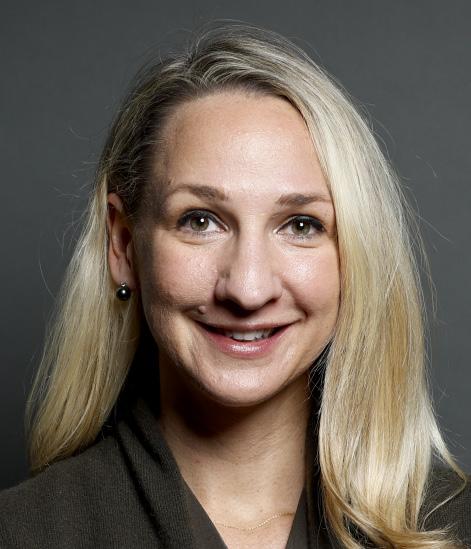 Jeff Pope President, F.W. Webb Company
Jeff Pope President, F.W. Webb Company










 By ASA University
By ASA University

Succession planning is the process of identifying and developing internal talents to fill key leadership positions when current leaders retire, resign, or move to other roles. The significance of succession planning in business can be understood through the following points:
• Continuity and Stability: A well-executed succession plan ensures that leadership continuity is maintained, reducing disruptions during leadership transitions.
• Organizational Performance: Effective succession planning guarantees that competent leaders are in place to guide the organization, sustaining and enhancing its performance.
• Talent Retention and Engagement: Providing growth opportunities to internal talents through succession planning boosts employee morale, engagement, and retention.





• Strategic Alignment: Succession planning aligns leadership capabilities with the organization’s long-term goals and strategic vision.
• Adaptability to Change: A robust succession plan enables businesses to respond proactively to unexpected leadership changes and evolving market conditions.
In our industry, there are a fair number of family-owned companies, which have a significantly different trajectory for succession planning than a non-family-owned business. In this chapter, you will explore succession planning, from two unique perspectives: the family-owned business (FOB) and non-family-owned businesses.




Succession planning in a non-family-owned business requires a thoughtful and structured process to identify and develop future leaders within the organization. Non-FOB business succession deals with identifying and grooming potential leaders from outside the family to assume toplevel positions.




Some hallmarks of non-FOB succession are:






































































• Objective Decision-Making: Non-family-owned businesses tend to prioritize merit-based decision-making over familial relationships. The focus is on selecting the most qualified and competent candidates for leadership roles.
• Cultural Alignment: The challenge lies in ensuring that the selected successors align with the company’s culture and values, as they may not have grown up within the organization.
• Retention of Talent: Non-family executives might feel uncertain about their future in the company, leading to a potential risk of losing top talent if they do not see a clear path to advancement.
• Ownership Transition: In non-family-owned businesses, the succession of ownership may require careful planning and coordination with external stakeholders, such as investors and shareholders.
• Shorter Timeframe: Unlike family-owned businesses with long-term generational planning, non-family-owned businesses may focus on more immediate succession needs, especially in cases of unplanned leadership changes.
• Integration of Family Members: If family members are part of the workforce, integrating them into leadership positions or finding alternative roles for them requires careful consideration.
While there are many ways to structure your succession planning at a non-FOB, there are several key steps to a successful planning process. To help you with the process, we’ll explore they key steps needed to achieve succession goals at a non-FOB business.
• Identify Critical Roles: Begin by identifying key leadership positions in the organization that are essential for its success. These may include CEOs, C-suite executives, senior managers, and other critical roles.
• Define Leadership Criteria: Develop clear leadership competency profiles for each critical role. Outline the skills, experience, qualifications, and personal attributes required for success in these positions.
• Align with Business Strategy: Ensure that the leadership criteria are aligned with the organization’s strategic goals and future vision.










































































• Internal Talent Assessment: Conduct a thorough assessment of internal employees to identify potential successors. Use performance evaluations, leadership assessments, and 360-degree feedback to gauge their strengths and development areas.

• Talent Review Meetings: Hold talent review meetings with top executives and HR to discuss potential successors and their readiness for leadership roles.
• Create Successor Profiles: Develop detailed profiles for potential successors, highlighting their strengths, areas for growth, and specific development needs.
• Personalized Development Plans: Create individualized development plans for all potential successors. These plans should outline the training, mentoring, and experiences required to prepare them for future leadership roles.
• Job Rotations and Assignments: Offer job rotations and special assignments to expose potential successors to different aspects of the business and develop their skills and knowledge.
• Leadership Development Programs: Invest in leadership development programs, workshops, and executive education to enhance the leadership capabilities of potential successors.













• Regular Performance Reviews: Conduct periodic performance reviews to monitor the progress of potential successors in their development plans.
• Continuous Feedback: Provide continuous feedback to potential successors to help them understand their strengths, address weaknesses, and stay on track with their development.
• Management Buy-In: Gain buy-in from top management and the board of directors to support and actively participate in the succession planning process.
• Transparent Communication: Communicate the succession plan and its objectives to all stakeholders, including employees, shareholders, and potential successors. Transparent communication builds trust and confidence in the process.
• Formalize Succession Planning: Incorporate succession planning into the organization’s talent management and strategic planning processes.































































































































































































• Review and Revise: Regularly review the succession plan to ensure its relevance and effectiveness in light of changing business conditions and goals.
• Identify New Talent: Continuously identify and assess new talent within the organization to maintain a pipeline of potential successors.
• Address Gaps: Address any gaps or shortcomings in the succession plan promptly and make necessary adjustments.
Remember that succession planning is an ongoing process that requires commitment and dedication from the organization’s leadership. By investing time and resources in identifying and developing internal talents, non-family-owned businesses can build a strong leadership bench and ensure a smooth transition of power when the need arises.
In our industry, family-based succession plans are common. FOB succession revolves around managing complex family dynamics and preserving a legacy. Given the core personal nature of family succession, different considerations must be accounted for as planning begins.
Some hallmarks of FOB succession are:












































































































































• Emotional Dynamics: Family-owned businesses are often driven by emotional ties and family relationships. The succession process can be complex due to potential conflicts, personal feelings, and the challenge of balancing family dynamics with business decisions.
• Continuity of Legacy: FOBs often prioritize maintaining the family’s legacy and values. Successors may be expected to uphold family traditions, which can influence the choice of leaders, even if they might not be the most qualified candidates.
• Inclusivity and Exclusivity: Family members may have varying degrees of involvement or interest in the business, leading to issues of inclusivity and exclusivity in the succession process. Non-participating family members might feel left out or resentful of the chosen successor.
• Integration of Non-Family Executives: If the family business brings in non-family executives to lead, integrating them into the family’s culture and decision-making processes can be a challenge.
• Long-Term Vision: Succession planning in FOBs often involves longer-term planning, considering multiple generations, to ensure the company’s continued success and growth.
To illustrate the complexities and challenges of family-based succession planning, we will explore two stories of family-based succession.
Joe Poehling, past President and CEO, First Supply Katie Poehling Seymour, current President and CEO, First Supply
“Coming together is a beginning; keeping together is progress; working together is success.”
 —Henry Ford
—Henry Ford
“Like all the best families, we have our share of eccentricities, of impetuous and wayward youngsters, and of family disagreements.”
—Queen Elizabeth IISome of the largest and most successful businesses in the world are family owned. In fact, approximately one-third of the 1,000 largest companies in the world are controlled by families. There are 5.5 million family businesses in the US. (FEUSA, 2011). Family owned businesses contribute 57% of the









U.S. GDP (that’s $8.3 trillion), employ 63% of the workforce (FEUSA, 2011), and are responsible for 78% of all new job creation. (Astrachan & Shanker, 2003). 35% of Fortune 500 companies are family-controlled. (Businessweek. com, 2006). Even if you are not a member of a family-owned a business, you are likely impacted by one.


Beyond economics, family-owned businesses tend to have more diverse leadership and disproportionately invest in their communities. There are greater opportunities for women in family businesses. In 2007, 24% of family businesses were led by a female CEO or President while of non-family firms in the Fortune 1000, only 2.5% were led by women. Nearly 60% of all familyowned businesses have women in top management team positions (Mass Mutual American Family Business Survey, 2007).
However, the average lifespan of a family-owned business is 24 years (familybusinesscenter.com, 2010).























































































































































































About 40% of U.S. family-owned businesses transition into a second-generation, approximately 13% are passed successfully to a third generation, while only 3% survive to a fourth generation or beyond (businessweek.com, 2010). Clearly, succession remains a constant challenge.

Because the pool of talent for future business needs is somewhat fixed, as it relates to the family connection, retirements can be devastating if they are not part of a larger plan. In fact, almost one third (30.5%) of family business owners have no plans to retire, ever, and nearly another third (29.2%) report that retirement is more than 11 years away.

Since the median age of the current leaders is 51, this means that many owners plan to live out their years in office. This poses unique challenges for the succeeding generation. There may not be an opportunity for the succeeding generation to hold a leadership role until the current generation passes away. Even more critically, if the succeeding generation finds themselves in leadership, should there be a sudden health event or otherwise, they may not have the exposure or development needed to succeed. Further exacerbating this risk is the fact that nearly one third (31.4 percent) of FOBs have no estate plan beyond a will (2007).
Failure to plan does indeed result in disaster. In nearly half (47.7%) of all FOB collapses, the failure of the business was precipitated by the founder’s death, or in 29.8% of the cases, the owner’s unexpected death. Only in relatively few instances (16.4%), did the business failure follow an orderly transition, and in situations where the owner was forced to retire, the figure drops to 6.1% (University of Connecticut Family Business Program, 2009).
















Clearly, the case for a clean, succinct succession plan is not a “nice to have”–it’s a must. Without a succession plan in place, literally, the future of the family and of the employees are at the mercy of a single point of failure. The goal of succession planning is to alleviate failure to launch when a transition of leadership takes place.






































































































































For well-established, large families, maintaining ownership is not the ultimate end; rather, the family’s unity and commitment are strengthened by other motivations that result in retaining the business for generations. For example, they may rally around a social purpose for the company like the family ownership of Roche, the Swiss pharmaceutical company that believes in the life-saving innovations of medicine. Most of the family’s wealth is invested in the business, but its connection to the company is emotional as well as economic (John Ward, Keeping the Business within the Family, Financial Times Guide to Mastering Corporate Governance).
First Supply has had the immense fortune of thriving for 126 years through five generations of the Poehling family (members of the sixth generation have now also worked in the business for several years). Like all business success, this longevity has been hard earned through planning, persistence, and probably a good bit of luck. For at least three generations, succession planning has provided stability and structure during a time that is otherwise muddled with uncertainty. Three critical characteristics of succession planning have emerged with some notable nuance, given that succession entailed not only a business but also a family.
The three characteristics are clarity, specificity, and communication. Each characteristic serves a role in the plan, working together to create the ultimate family business goal–aligned consensus. What does that mean? Even more than in a non-family-owned business, where relationships are transactional at their core, alignment means that the family understands the direction and consensus means that there is a majority in consent with that direction.
Notice “agreement” is absent from an understanding of aligned consensus. Agreement would be nirvana state, however, perhaps an impossible standard. Depending on a family member’s experience with the business, current professional status, and even geographic location, they may have a differing perspective about how the business should be run or whether the family should even continue to own the business.













Families that can create an understanding and general concurrence, despite all the different characteristics of each family member, are succeeding. This certainly becomes increasingly difficult as generations build and family membership grows. As complexities layer through time, a strong foundation of unified consensus will keep the focus on the right actions for the business.
Establishing a succession plan for a business of family and non-family members that embodies the characteristics of clarity, specificity, and communication takes one thing—time. Putting in the time necessary to build a meaningful plan that has lasting relevance should take place over time and should be reviewed periodically over time. A family succession is an ever-evolving landscape, much like the fabric of your life—shifts happen, unexpected challenges arise, and realignment is sometimes needed. As with any maturing business, leaders must be nimble and willing to modify course if warranted.
Engaging all constituents involved should be done periodically, over time, and on a regular basis. Care should be taken to be inclusive when communicating, both inside and outside the family. Presenting the current succession plan annually to the board of directors or advisors and at an annual family business meeting keeps it top of mind, so there are no surprises when the plan takes effect. Everyone should have a clear understanding of what would happen and how it would happen, if the transition needed to happen overnight.












































































































































































































Clarity in a succession plan is the foundation. Clarity drives engagement from everyone involved in the plan, both successors, and those who succeeded. Clear timelines should be established so that the path forward has no question as to an official transition. This allows employees, both adjacent to the transition and throughout the organization, to understand who is in charge. If it is not clear, authority and leadership are harmed throughout the transition. As with any change initiative, it’s important to ensure your stakeholders clearly understand the process and the reasoning behind it.
Even more important is a clear understanding of expectations following the transition for financial obligations, governance of the business, and operations of the business. If there will be a transition period, who reports to whom and why? Who can make “the call” about key decisions? Who attends which events and when? Who attends which meetings and what is their role in the meeting? What compensation expectations exist, and for how long?
There are no right or wrong answers; the key is to have a clear answer for as many elements as possible. Uncertainty can be destabilizing not only to the business at the macro level but also at the micro level with each employee undoubtedly invested in the decision-making of the family at the head of the business. Even if expectations don’t go according to plan, clear communication is an efficient tool to dispel uncertainty before it arises.
Lastly, despite every effort there may be omissions or misalignments, so having a clear path for resolving any questions or uncertainties is important.
Specificity is essential to clarity. Specific elements in the plan ensure that there is no question as to how the clear plan will be implemented. In the worst case, there is an assumed aligned consensus around non-specific details that results in discord when each stakeholder puts forward their assumed details.






The key elements requiring specificity include:















































































































































• Specific names for certain roles on specific timelines.
• Specific communications in specific events (for example, if Person X is named as successor on Y date, customer 1, 2, and 3 will be called, vendor A and B will be called, and vendors D, E, and F will be emailed; the bank will be called; and so on).
• Specific meetings. For example, the board will convene within 24 hours, the senior leadership team will convene within 48 hours, and the family will convene within 72 hours.
• Specific training, attributes, and skills. The Poehling family utilizes a “five year out” rule, meaning any successor must to work outside the business for five years. Other families use a five years and out rule where successors can get experience for five years then you need to go elsewhere and come back.
There are myriad elements that could be specified but it is important to find balance. Garner specificity to provide clarity but enough room to address unimaginable circumstances. Some other elements to consider may be more frequent board meetings during the critical transition period, a board or other executive mentor during a critical transition period, professional executive coaching leading up to a transition period, and important introductions leading up to a transition period (top five customers, top five vendors, etc.).
It is be impossible to give clarity to every situation that may arise. Anticipating and discussing any situation with specificity is the lesson. Any situation discussed vaguely only results in misalignment and eventual conflict.

Perhaps most obvious, the succession plan should not be a secret. Instead, it should be over communicated at every opportunity.
The plan, both normal and emergency plans, should be published annually to all stakeholders–shareholders, family, and board. It should be “ratified” by all stakeholders with an opportunity for feedback, although not necessarily input. A distant shareholder may express an opinion, but it may not be relevant or reasonable to implement. The important thing is that their voice was heard. The plan should be easily accessible to the same stakeholders. First Supply uses a board portal where the plan is published for any board member to review and placed in a family-secured shared folder any family member can access it. Secure software exists for both groups as well.
The plan should be communicated across the organization. Key executives should know and understand that there is a plan and that the intention remains orderly. Successors should have a prominent role in employee meetings, employee communications, and key projects, so their leadership is visible and valued.







In the same vein, the successor should be well known to the industry. For industry constituents such as vendors, manufacturer reps, and customers, the transition should be a non-event where they feel the succession is assumed because they are so familiar with both the former and incoming leaders. It should be stated–this is extraordinarily difficult. This requires the current leader to be deferential at times to an incoming leader for roles within industry associations, to lead customer relationships, and to sponsor transformative projects. However, the confidence instilled in not only the successor but also in the industry around the successor is invaluable when done well.
















































































































































































First Supply and the Poehling family have transitioned the business leadership through six family leaders in 126 years and five generations (two generations founded the business together). These three elements are the lessons we’ve learned over those transitions, coupled with the education we’ve sought in the spirit of continuous improvement for future generations.
Over the course of nearly five years, the family leadership team crafted both a normal succession plan and an emergency succession plan. They were presented to the board and the family for ratification. They detailed various circumstances and details about who They by whom, and when. At the time, it seemed extensive, but, it was complete. Even over those five years, the plans were amended and updated as life events happened and circumstances changed. They were living document but the plans were clearly communicated at every adjustment.
Unfortunately, our most recent leadership transition occurred in an emergency situation a number of years prior to the implementation of the normal succession plan. However, the greatest gift our family and our company could have had in a moment of crisis was a clear, specific, and wellcommunicated plan. We literally pulled it off the shelf and went to work enacting it. We had a board meeting within eight hours of the emergency event so we could name the interim chairman, CEO, and president of the company. It was a relatively brief meeting with little discussion beyond an update on the situation because everyone already knew the plan.
As we began to communicate the interim plans to the family, vendors, and customers, we were overwhelmingly met with the same response–“Yes, I know. That was always the plan.”




















The right plan provides not only an orderly transition but Iso a roadmap in times of uncertainty, reassurance in times of crisis, and support when most needed. The time spent on a plan and these key elements will be the most valuable time your team, and your family will ever spend.









































































































































Family businesses are powerful contributors to society, to the economy, and to our industry. Whether you are a family member or an employee at a family business, understanding how the business will transition to the next generation or the next owner, is critically important. It doesn’t happen by accident. Diligent, hard work ensures that succession has intentional outcomes, not unintended consequences.
It is never too early to start planning for the future. Engaging even the youngest family members in age-appropriate activities and introducing them to the business builds positive associations and curiosity. Establishing family culture and principles makes it clear how the family’s business will be led into the future. The leadership succession plan is the blueprint for that future.
Jeff Pope, President, F.W. Webb Company
Planning for succession in a family-owned business is not always a formal process, nor is there a standard way for it to happen, as far as I know. In my family’s case, my grandfather purchased the F. W. Webb Company in 1933 and died of a second heart attack in 1961. When he passed, my father went from being an outside sales to the president.



In 1955, before he joined Webb, my father was in the navy and in charge of 90 men on a ship. The day after leaving the Navy, he was pushing a broom in a warehouse. In the six years before he became the president of the company, he was an inventory clerk and then a sales. That was the extent of his grooming to succeed his father. I was far more fortunate in that I had more than 20 years to become ready for that huge step.
I would say that I had a formal and an informal path to the presidency. The overall goal was to understand how it all worked and to learn what each position did within the company. No calendar of events was created, and there wasn’t a grand design for specific training during my journey.
Over the course of my career, I had at least 10 different jobs at Webb. So, I still have a pretty good idea of what skill sets are needed for most of the roles within the company despite, the








technological advances that have occurred in my lifetime. While it’s not revolutionary or cuttingedge stuff, on-the-job training continues to be the best way for our employees to learn and advance in the Webb Company.






























































There are several advantages to doing many jobs while traveling up the “corporate ladder.” In my case, I came away with so many ideas that still help me to this day. Working in a warehouse and at the counter immediately helps one learn what the products are and how important it is to have 100% of the customer’s order on hand.
Lifting boilers, water heaters and steel pipes are memorable experiences. Answering phones, taking lists of material, checking stock, and coordinating truck deliveries while working as an inside salesperson reinforces the importance of proper customer service daily. Going out on the road and calling on contractors is a real education, too. Managing a location with all those moving parts, delivering great customer service, and being profitable at the end of the year is probably the most important on-the-job training one can get.
Successful coaches and managers of professional sports teams are rarely the former superstars of their leagues. It’s usually a back-up player who has gone through so many different experiences to become the leader of the franchise. I believe that is also the case for those who run family-owned supply houses. So, it isn’t crucial to be the top salesperson or the manager of the biggest location before taking the next step in the succession process. It’s the gaining of all that comes with each new role along the way that is most important.

















Making mistakes during the ride is also a must, as crazy as that might sound. If you don’t learn what works and what doesn’t during this process, then you won’t know what to do when problems happen. You would also be unable to help employees get past the situation if they haven’t experienced it for themselves. You learn what is important and what isn’t as well. Try not to make the same mistake twice, if possible.
One other benefit of doing many different jobs and then becoming the boss is that you can empathize with employees and know the degree of difficulty of their positions. You’ll also have the knowledge and experience, so it will be rare when someone tells you that you don’t understand what it’s like to do a specific job. There is an additional appreciation for the fact that you have walked in their shoes and know how that feels.










































































Building lasting relationships is immensely helpful during the process. As the son or daughter of the owner, you get a terrific idea of who could be on your team in the future. You learn to identify the people who respect you for your abilities versus your last name. You find out what people like about the company and what could use improvement. It’s helpful to be humble and to work as long and as hard as your co-workers when you’re in any role. In most cases, your co-workers know more than you about the functions of their jobs, so having an appreciation for their abilities needs to happen too.
Even though on-the-job training is a proven path to succession, there are going to be gaps, and that’s okay. You need to understand what your strengths and weaknesses are and plan to fill in those gaps with education and with people who have expertise in certain areas. Being a member and



















































participating in associations and buying groups is another way to help your overall business education. Listening to people from all parts of the country about how they operate is truly beneficial. You will almost always come back to your company with ideas to try.
It’s often recommended that you to work somewhere else before joining the family business for a few reasons. One is that you learn how others run their companies while you’re there. Some best practices usually come from experience. Another is that your last name has no importance during this time and you can figure out what you do well and what you need to work on with no one keeping score.
It would be presumptuous to state that on-the-job training is the best way to go from sweeping the floors to running a company. But, the school of hard knocks and being in the trenches and learning all that happens during the process is an unforgettable experience that will provide knowledge and certainly help you keep your business heading in the right direction. We’re in an industry where change is a constant and the need to wear many different hats happens. That is what’s great about taking on as many jobs as possible during the climb to the top rung of the ladder.






















































































































































Joe Poehling & Katie Poehling Seymour, First Supply
Katie Poehling Seymour is the president and CEO of Madison, Wisconsin-based First Supply and the 2023 ASA president. She and her father Joe Poehling, chairman emeritus of First Supply, are the first daughter-father combination to hold the ASA presidency. Poehling Seymour represents the fifth generation of family leadership at the 126-year-old wholesaler.
Joe Poehling is chairman emeritus at Madison, Wisconsin-based First Supply. Poehling is one of three First Supply individuals to hold the ASA presidency along with his brother-in-law, Ed Felten, and daughter, Katie Poehling Seymour (the 2023 ASA president). Poehling, a key driver in the original fundraising efforts for the ASA Education Foundation Karl E. Neupert Endowment Fund, is a recipient of ASA’s prestigious Fred V. Keenan Lifetime Achievement Award.
A third generation Pope family member to serve as president of the F.W. Webb Company, Jeff Pope leads the largest wholesale supplier of plumbing, heating, HVAC, LP gas, refrigeration, cooling, pipe, valves and fittings and industrial products in the Northeast. He oversees and monitors all aspects of the F.W. Webb enterprise to ensure the company continually fulfills its mission as a one-stop partner to the commercial and residential trade industries as well as to industrial and institutional building and property professionals.
Like his father, John Pope (1931 - 2018), Jeff is a Dartmouth College alumnus who also began his career at F.W. Webb in sales. As the company continues its expansion into new markets and territories, Jeff strives to ensure every customer’s experience with F.W. Webb is a positive one. Motivating employees to continually give their best and creating ongoing value for the company’s stakeholders are also among his top areas of focus. Jeff is a past president of the American Supply Association (ASA).




















































1. What is the significance of succession planning in a business, and how does it contribute to continuity and stability?
2. How does effective succession planning impact organizational performance and long-term strategic alignment?
3. In what ways can succession planning enhance talent retention, employee engagement, and morale within an organization?
4. What challenges do family-owned businesses face in succession planning compared to non-family-owned businesses?
5. What are some key differences between succession planning in non-family-owned businesses and family-owned businesses?
6. How does succession planning in non-family-owned businesses differ in terms of timeframes and objectives compared to family-owned businesses?
7. What are the critical steps in the succession planning process for non-family-owned businesses, and why are they important?
8. How can family-owned businesses address emotional dynamics and maintain continuity of legacy during succession planning?
9. What role does communication play in successful succession planning for both family-owned and non-family-owned businesses?
10. How do the stories of First Supply and F.W. Webb Company illustrate the importance of succession planning in family-owned businesses?

• “Succession Planning Basics” by Donald J. Bittar.
• “Business Succession Planning for Dummies” by Arnold Dahlke.
• “The Family Business Succession Handbook” by Frederick D. Lipman.
• “Effective Succession Planning: Ensuring Leadership Continuity and Building Talent from Within” by William J. Rothwell.
• “Succession Planning: What You Need to Know” byHarvard Business Review.



• “The Unique Challenges of Succession Planning in Family Businesses” by Forbes.
• “The Role of Leadership Development in Succession Planning” by Training Industry Magazine.
• “Succession,” a podcast series.




















































































• “Leadership and Succession Planning,” by The Gartner Talent Angle Podcast
































































• “The Family Business Voice,” a podcast series.


















































































































































• “Succession Planning for Small Businesses” by The Growth Lab Podcast

























































































































































